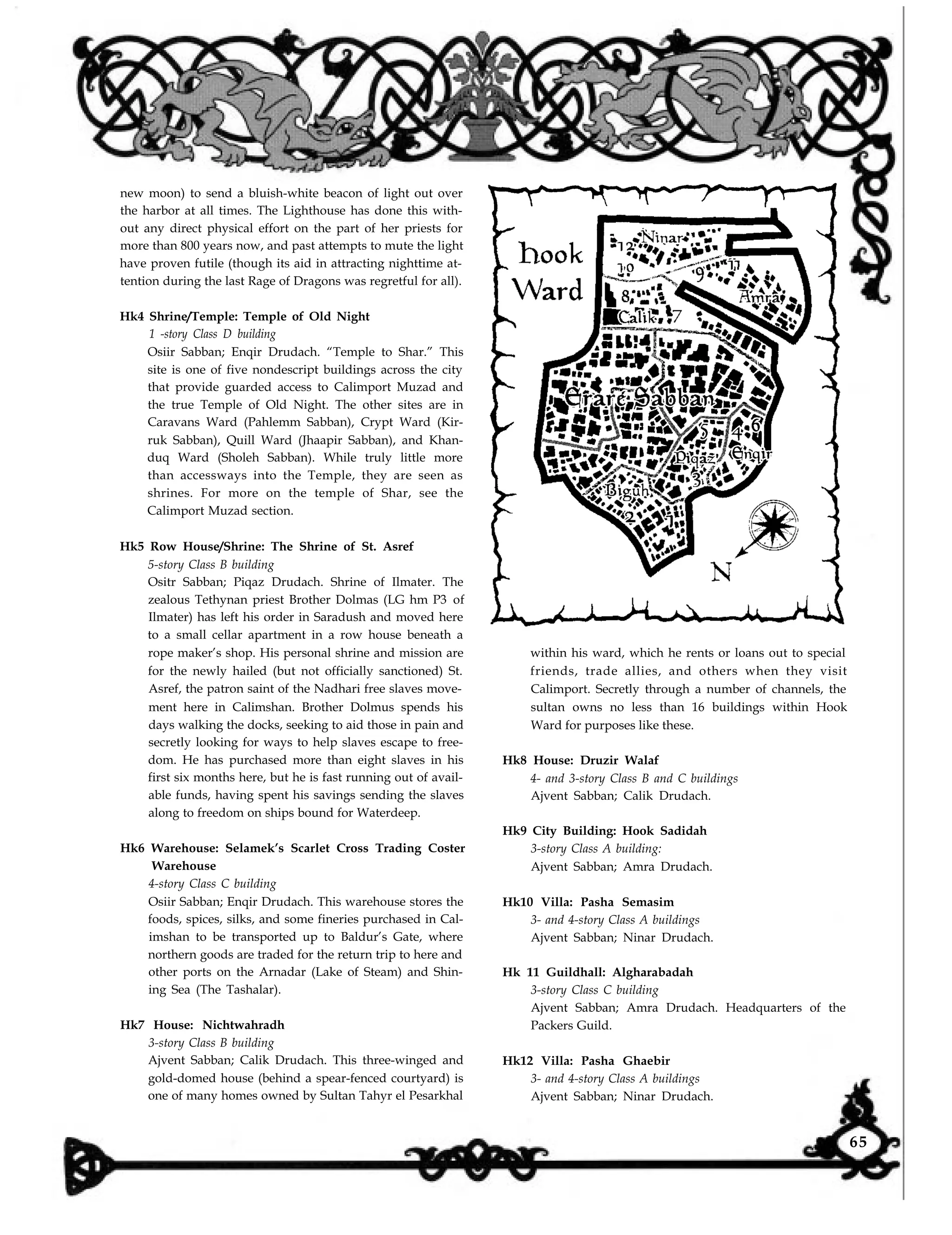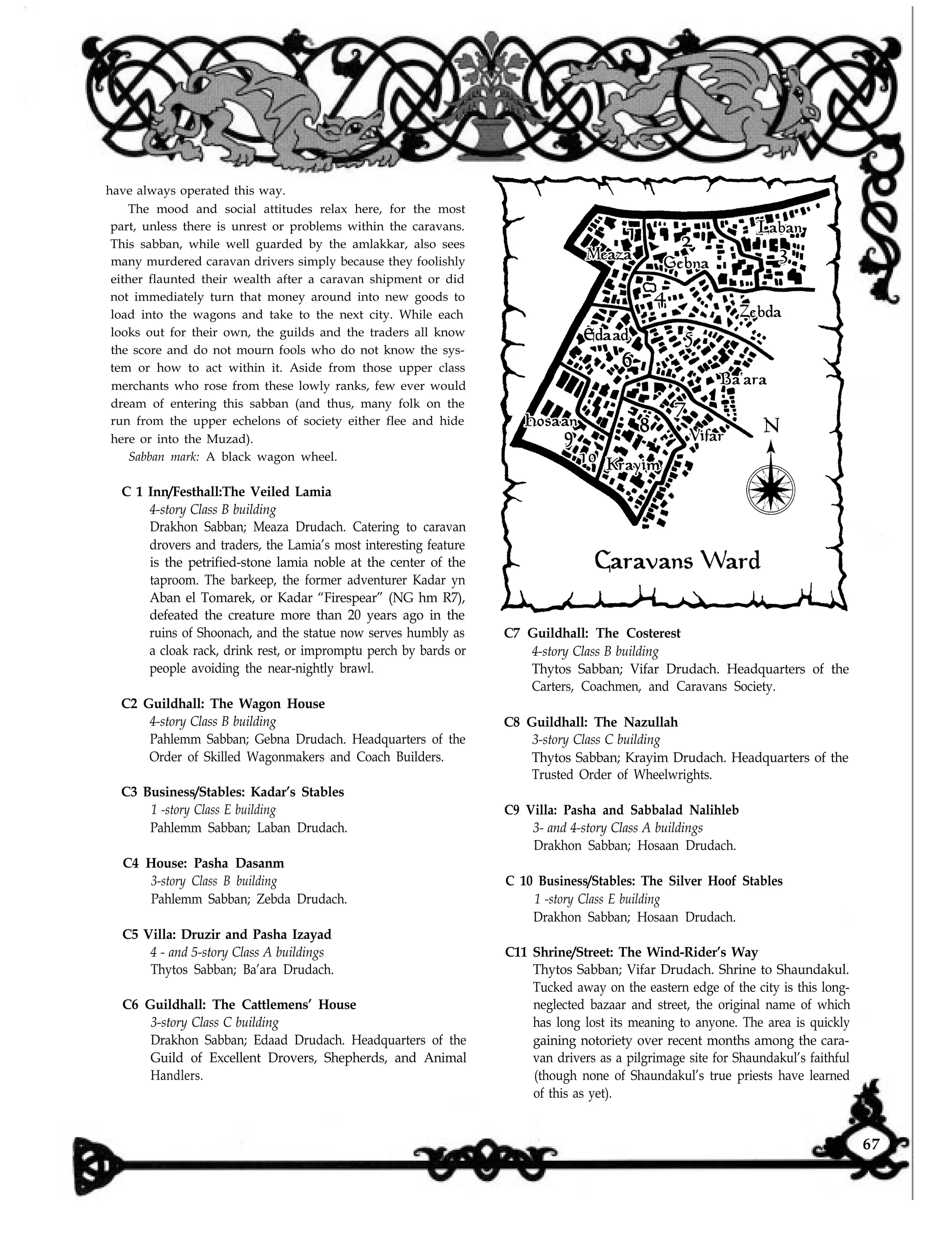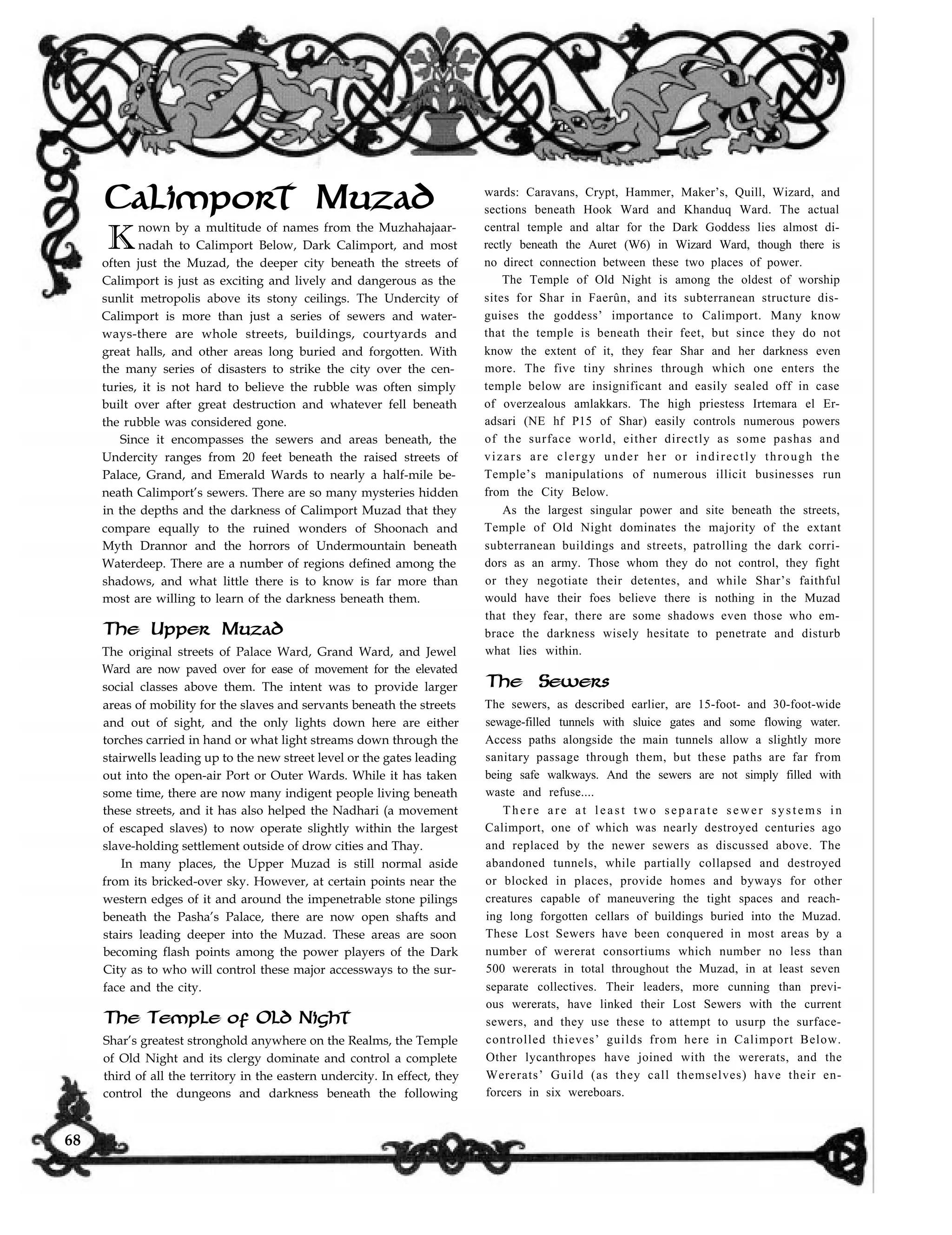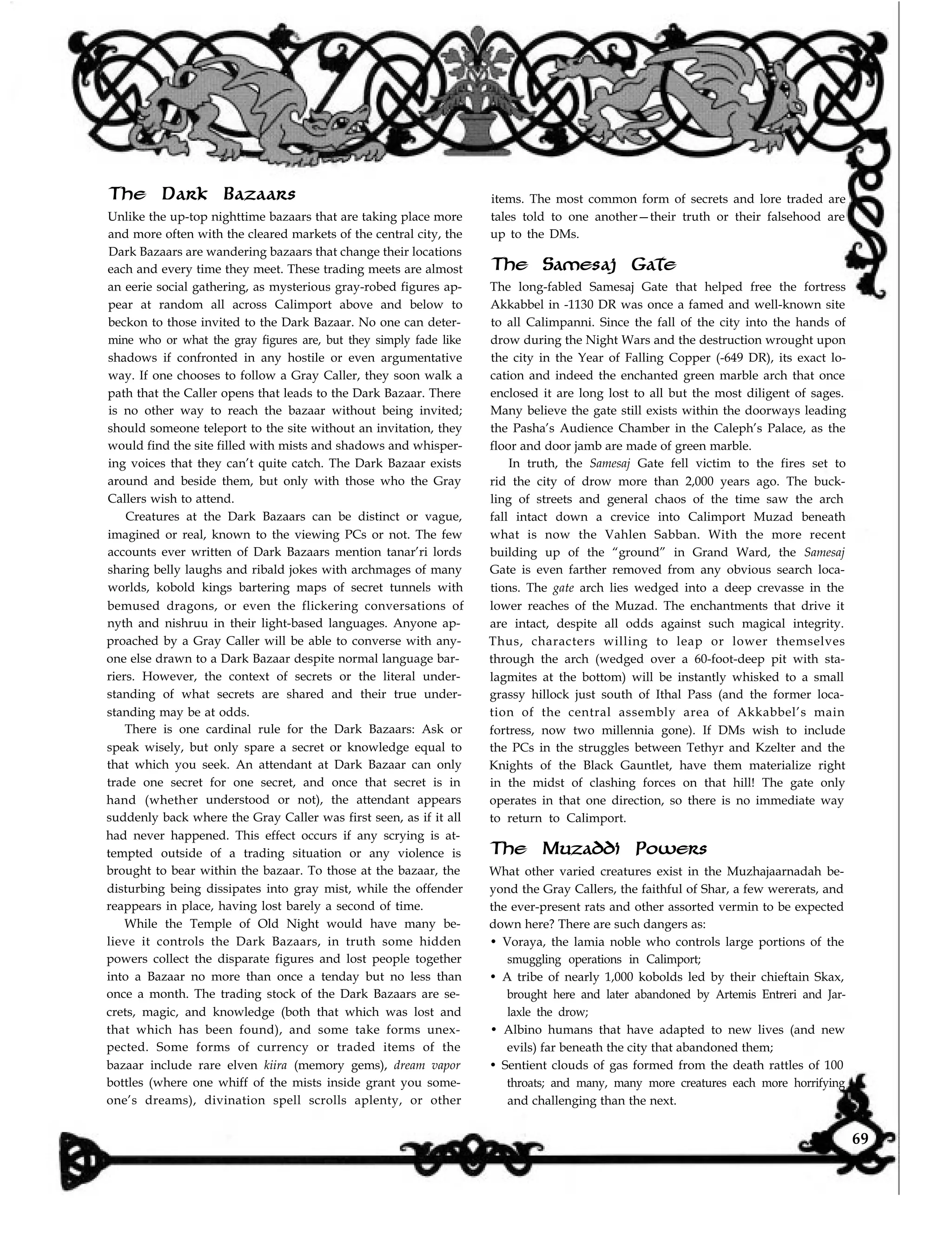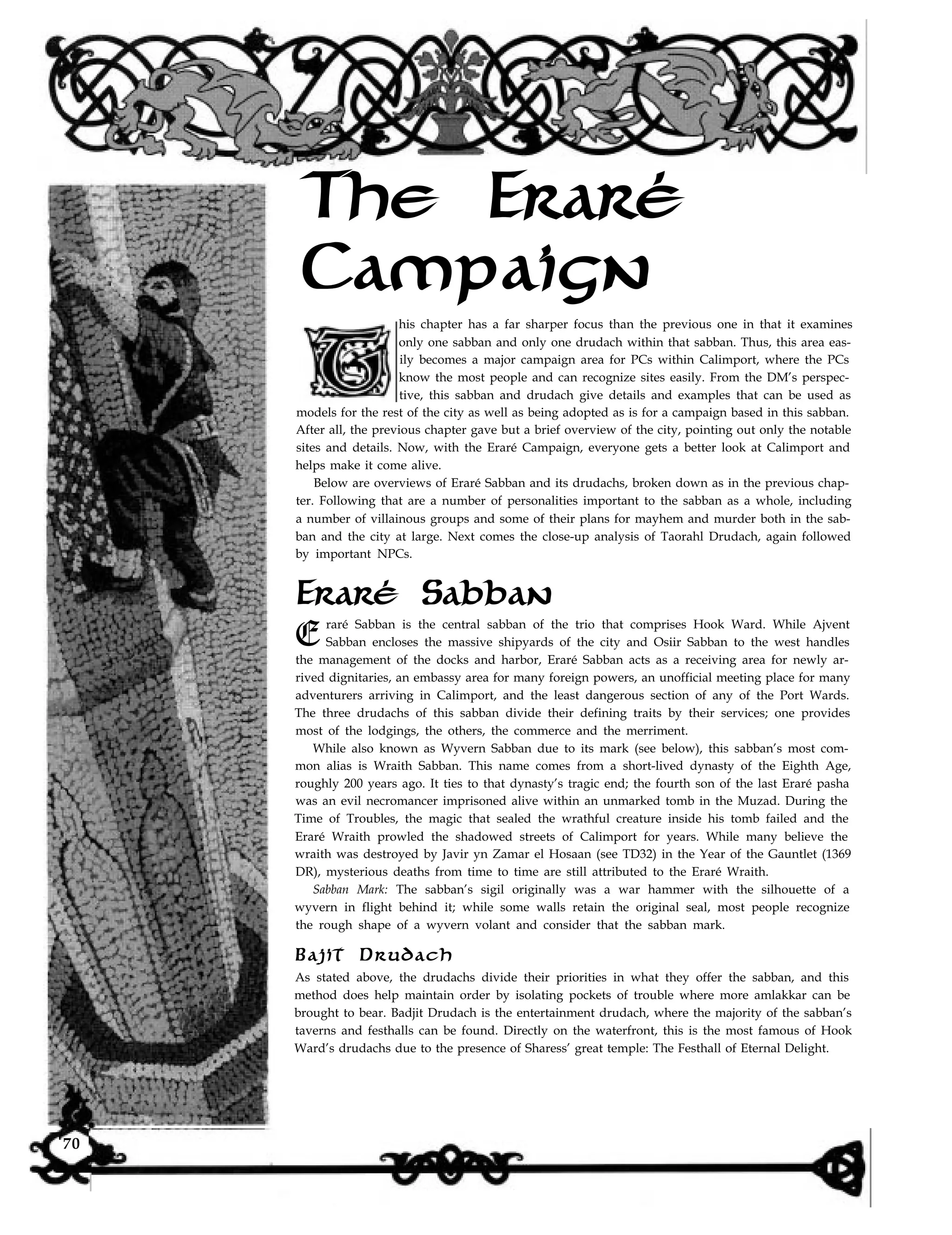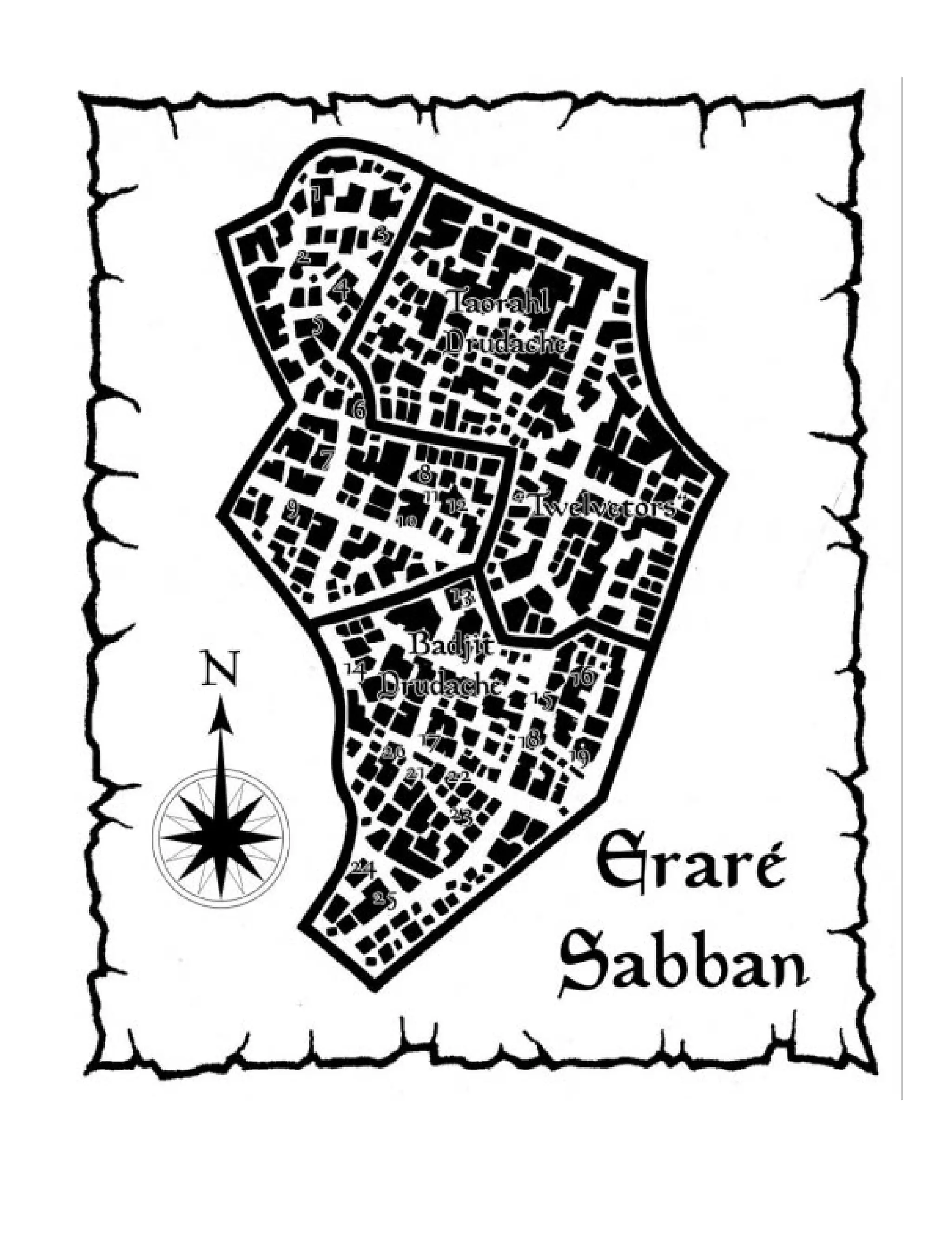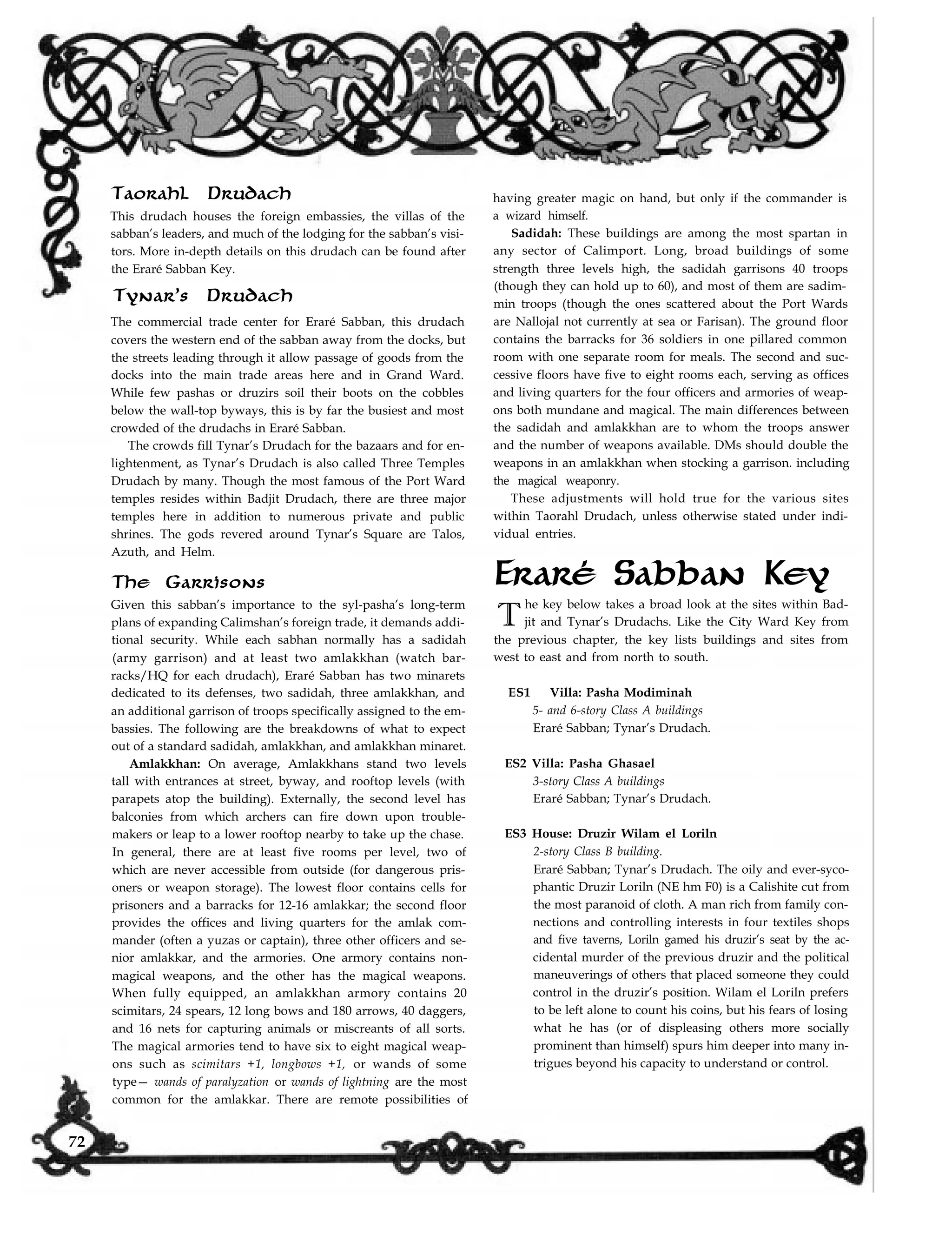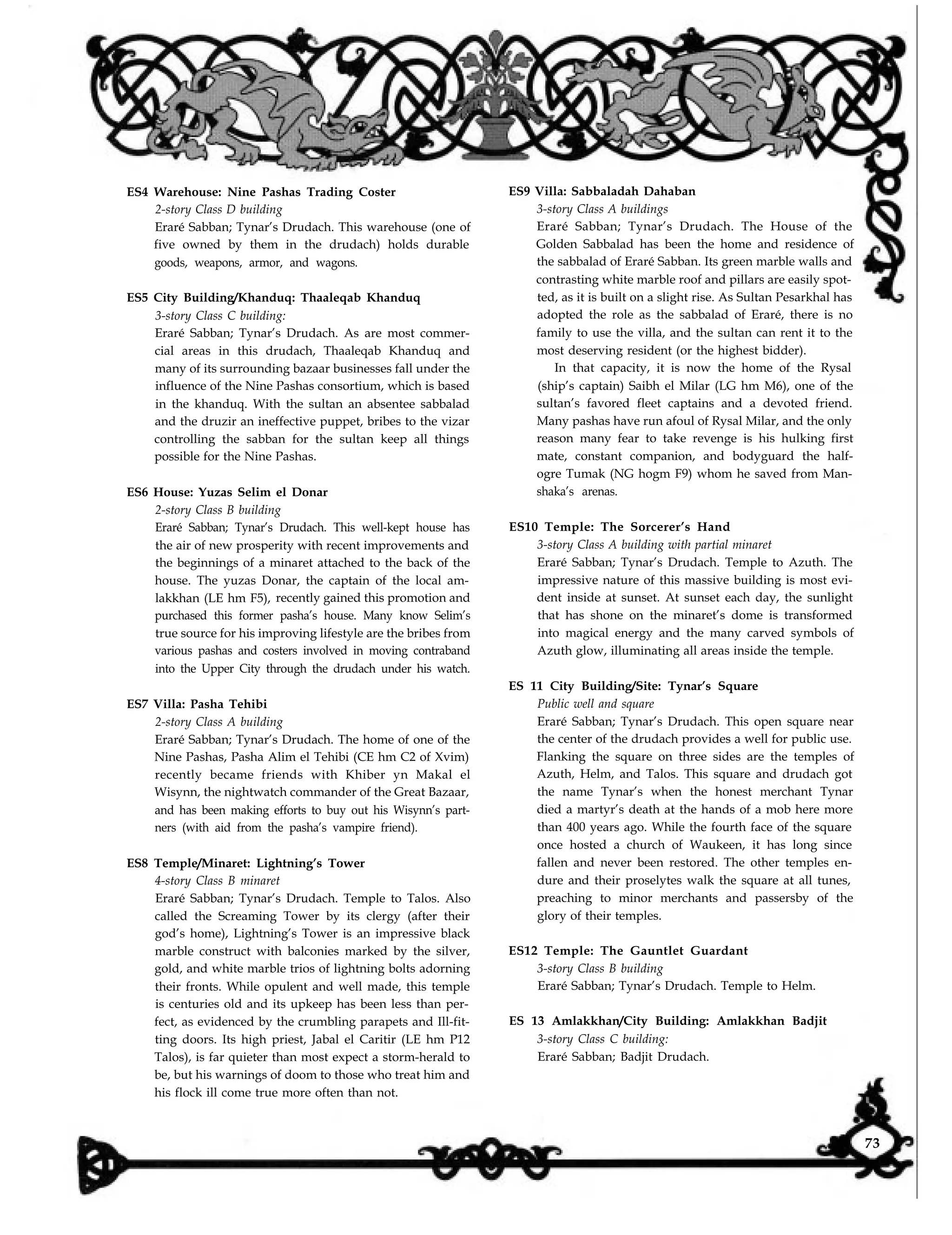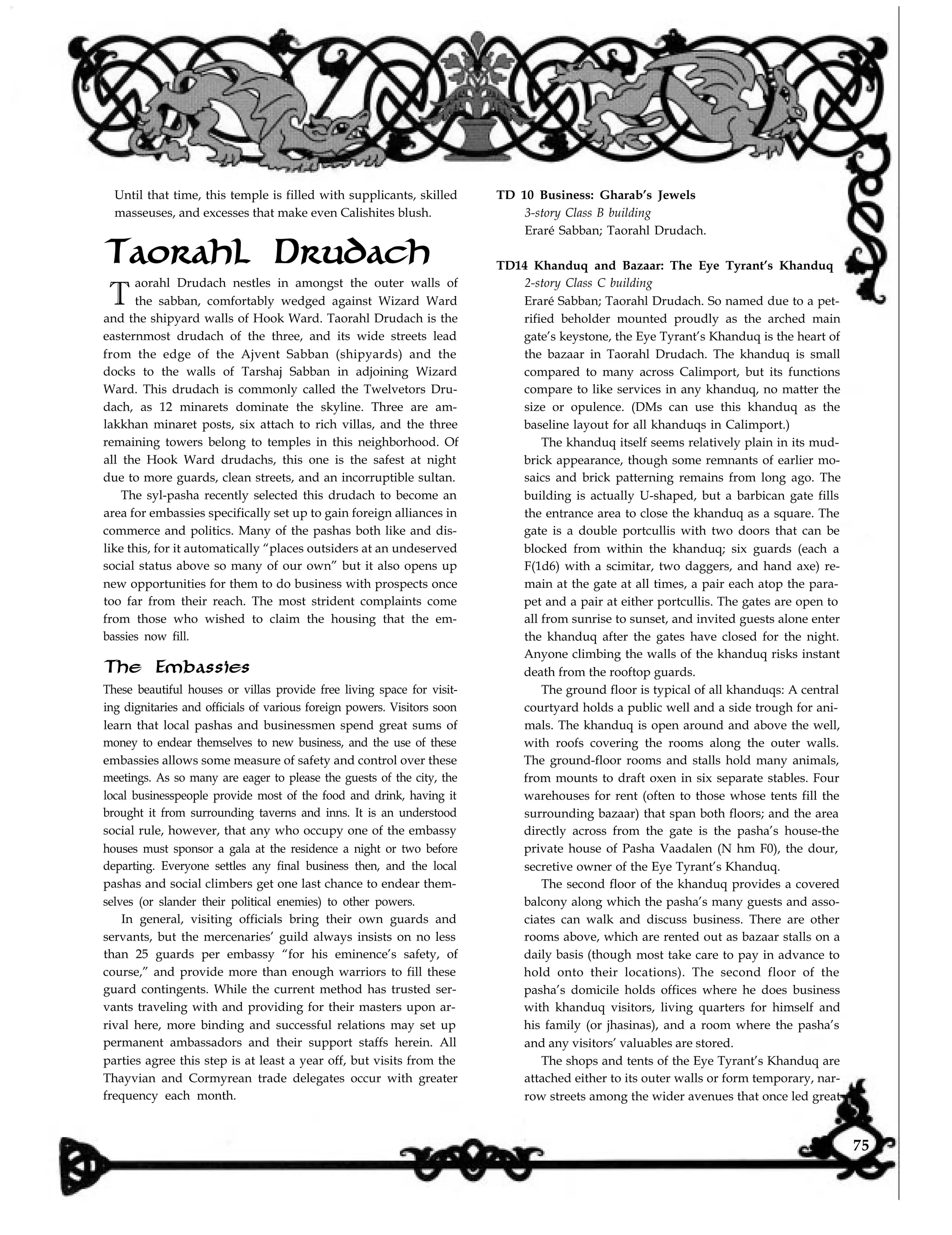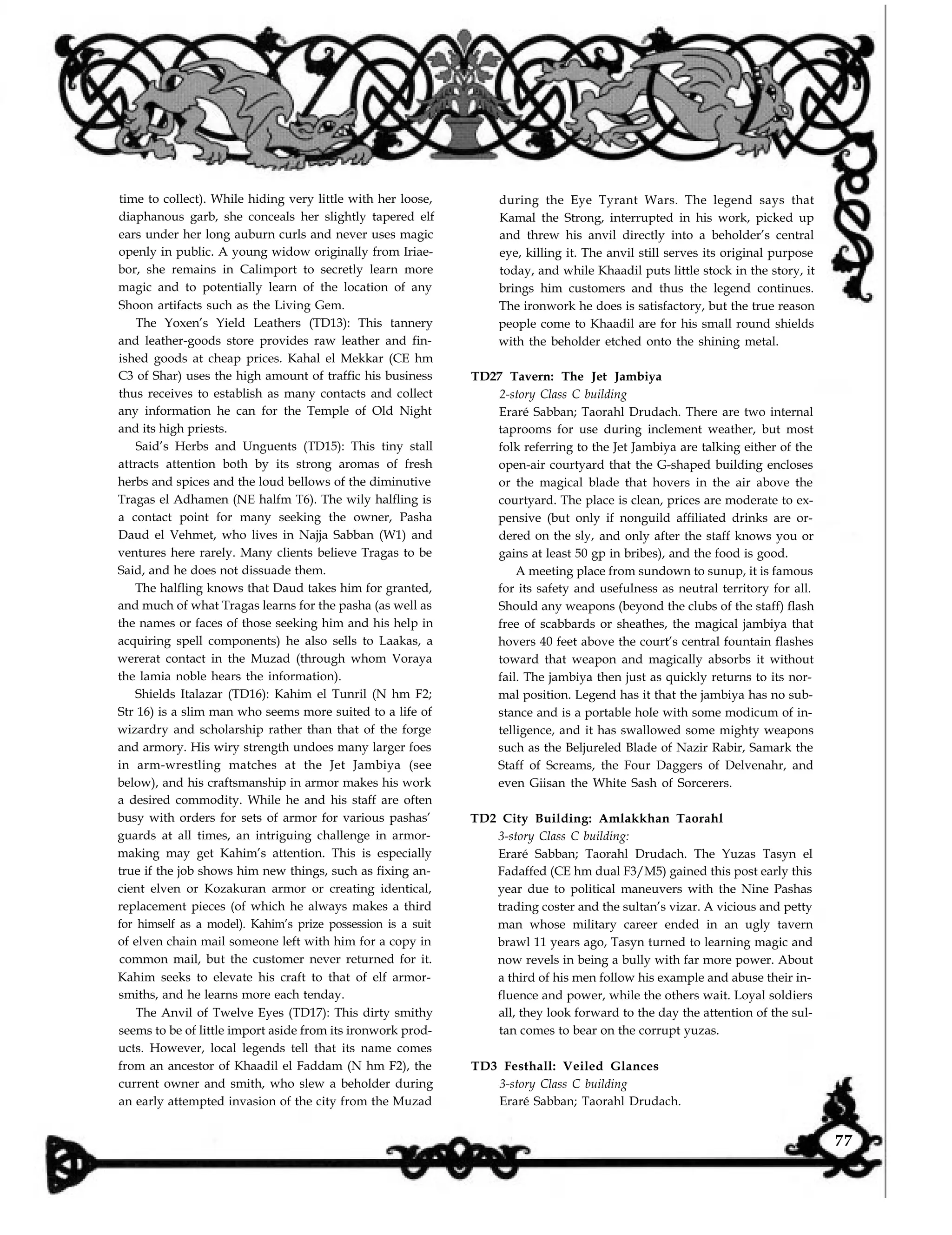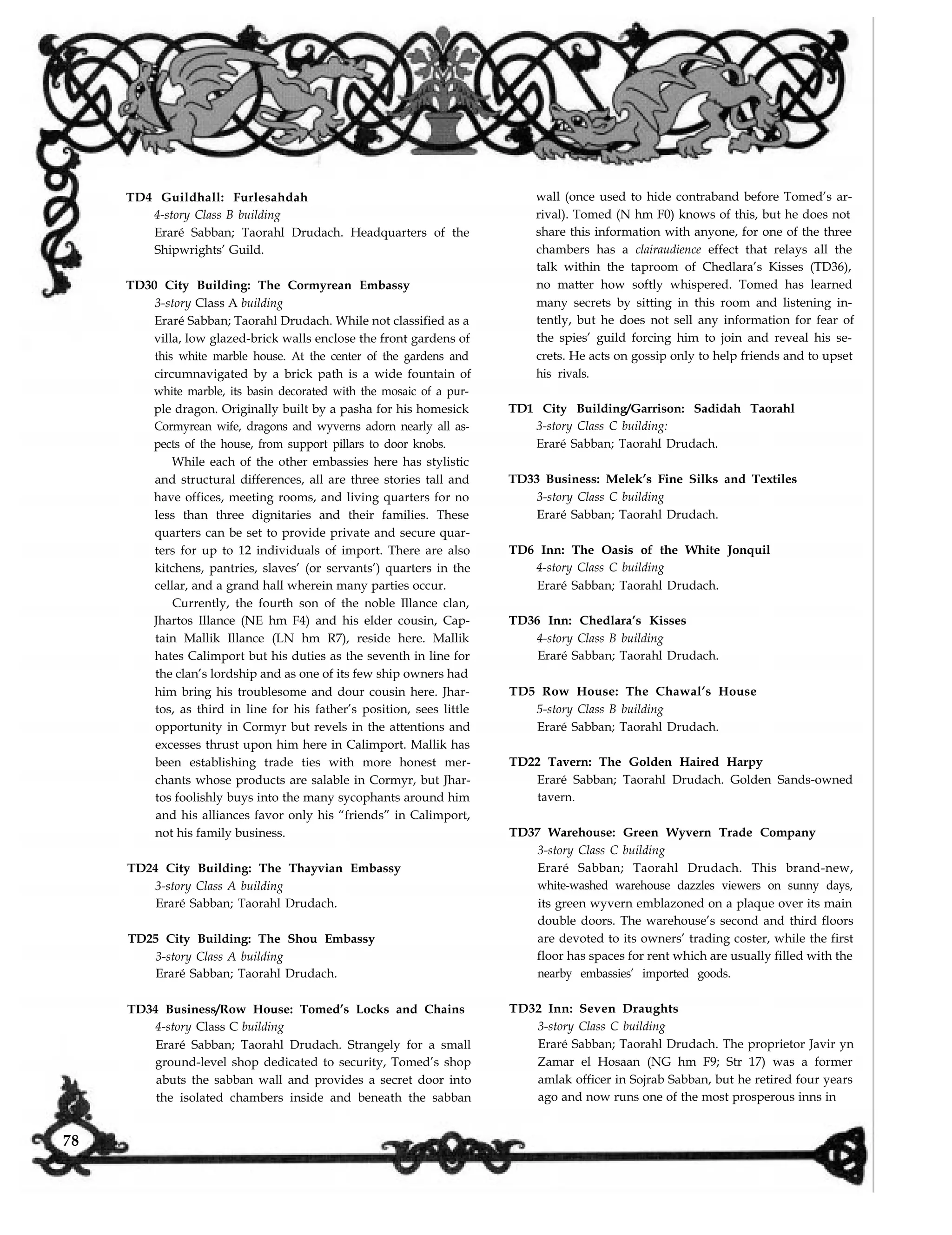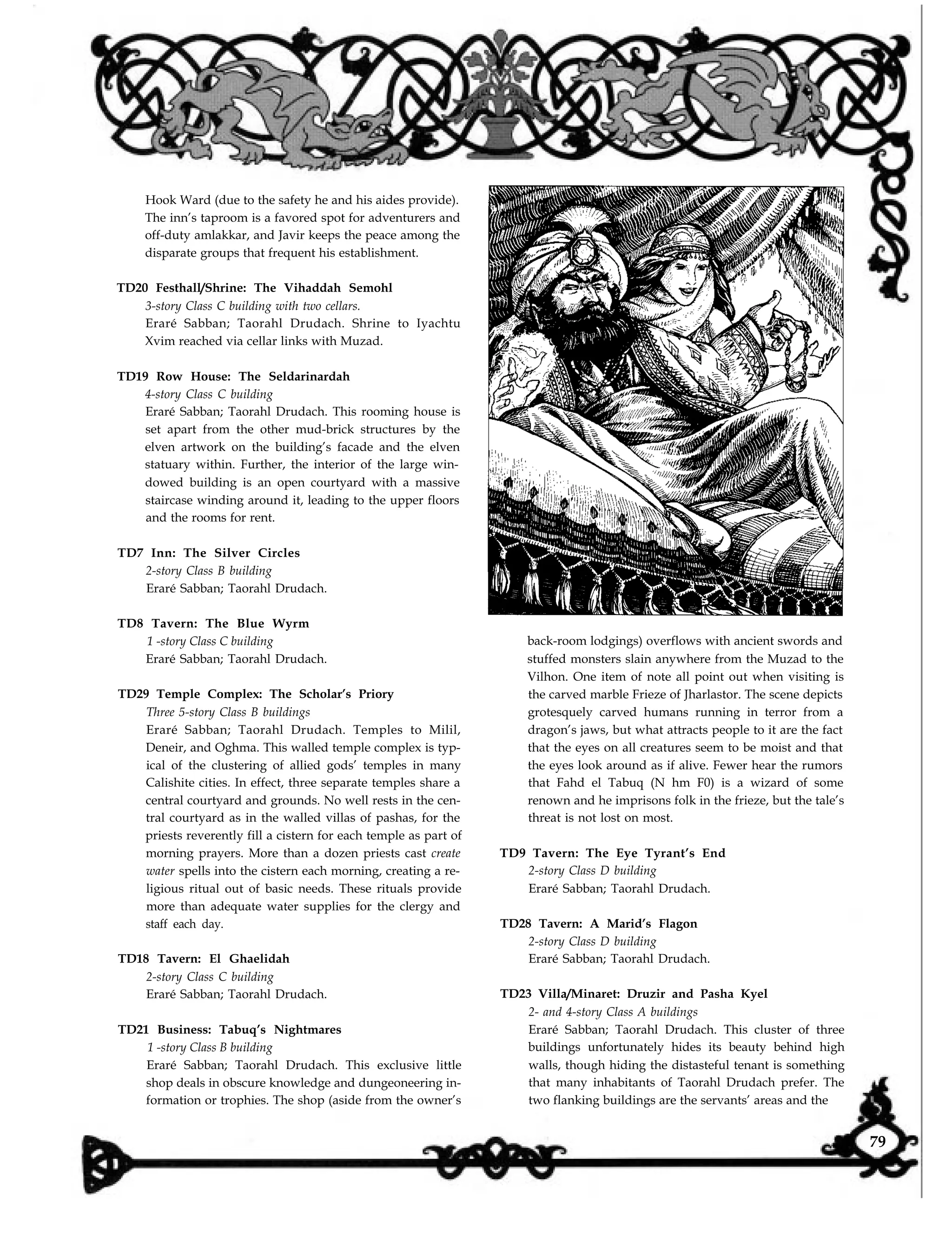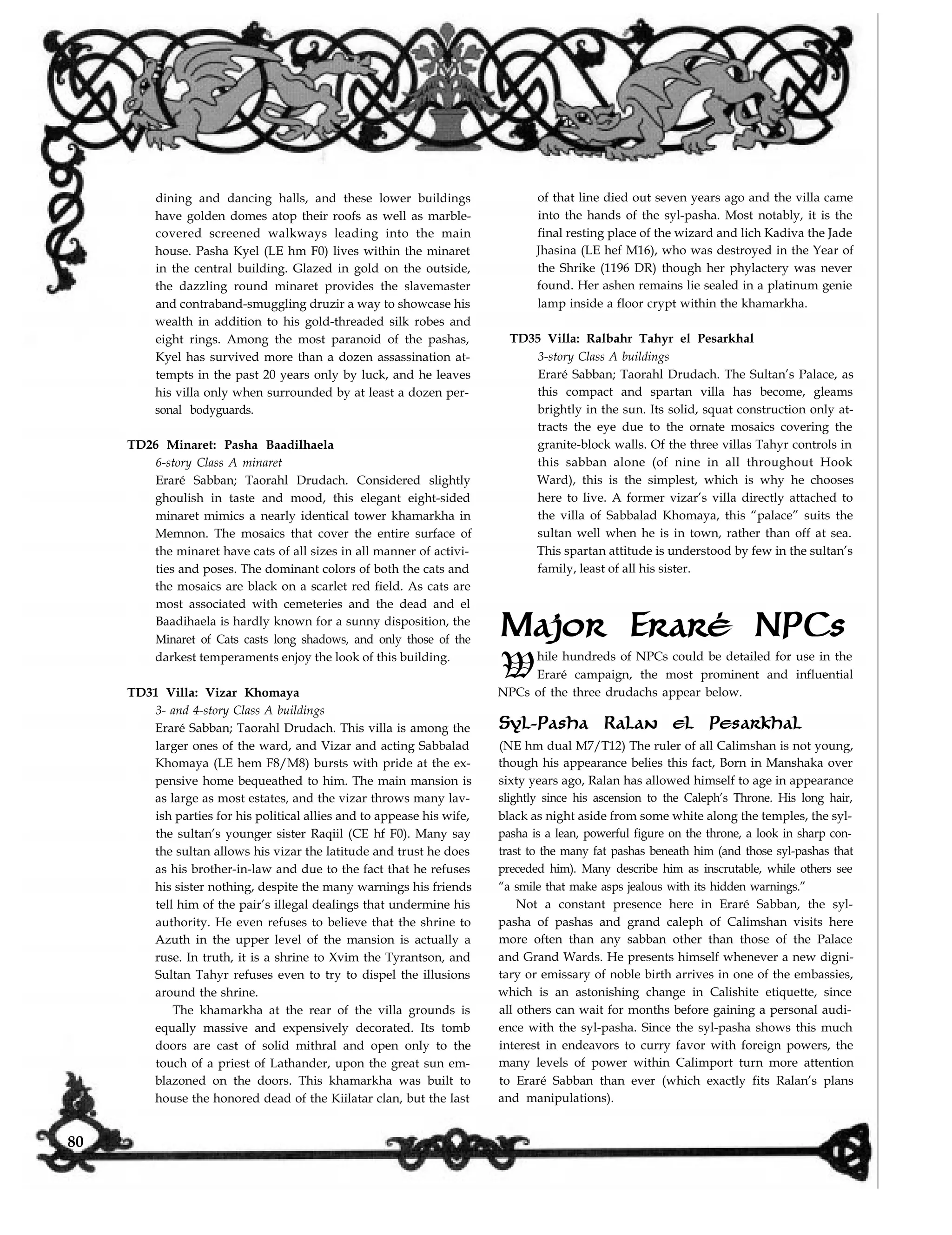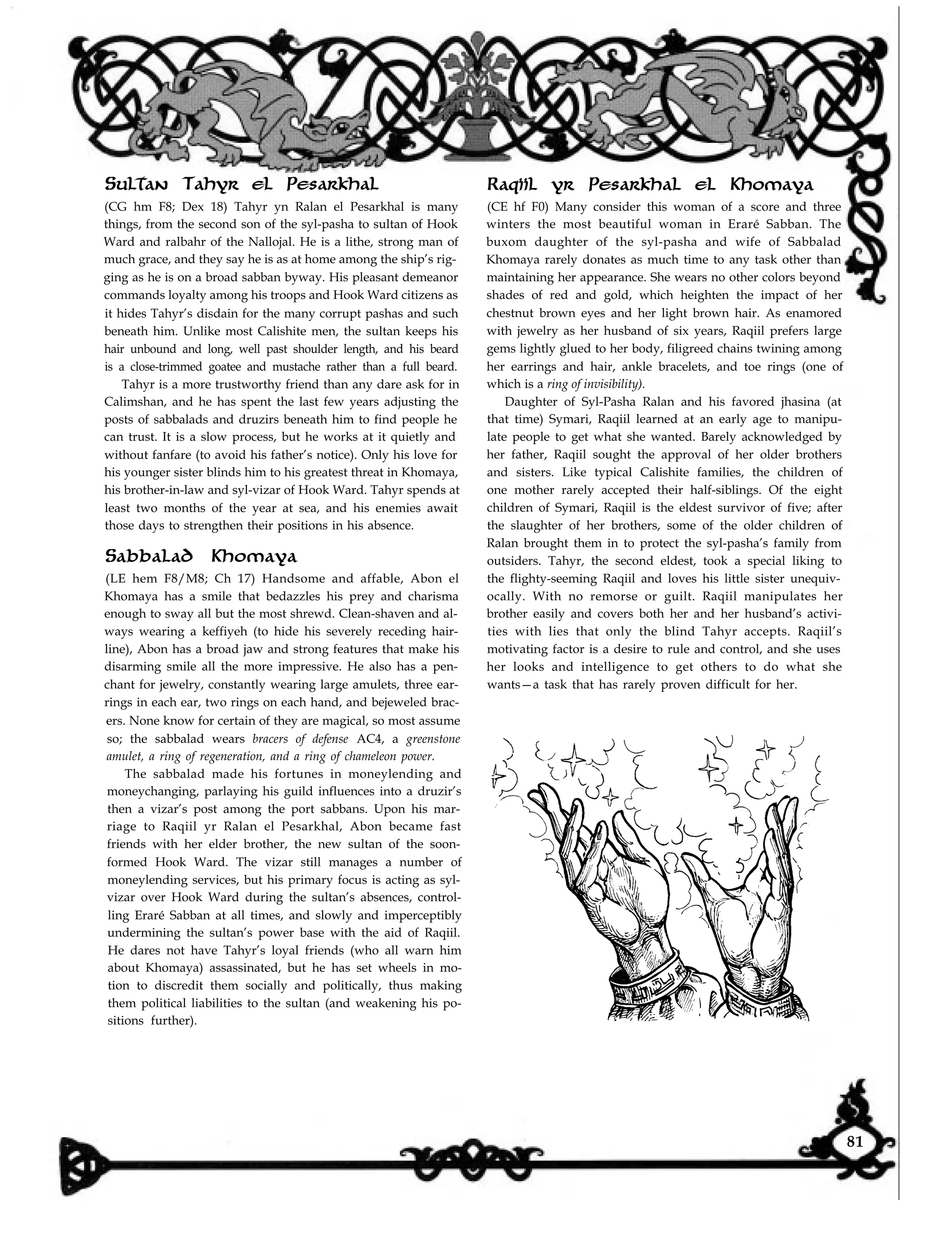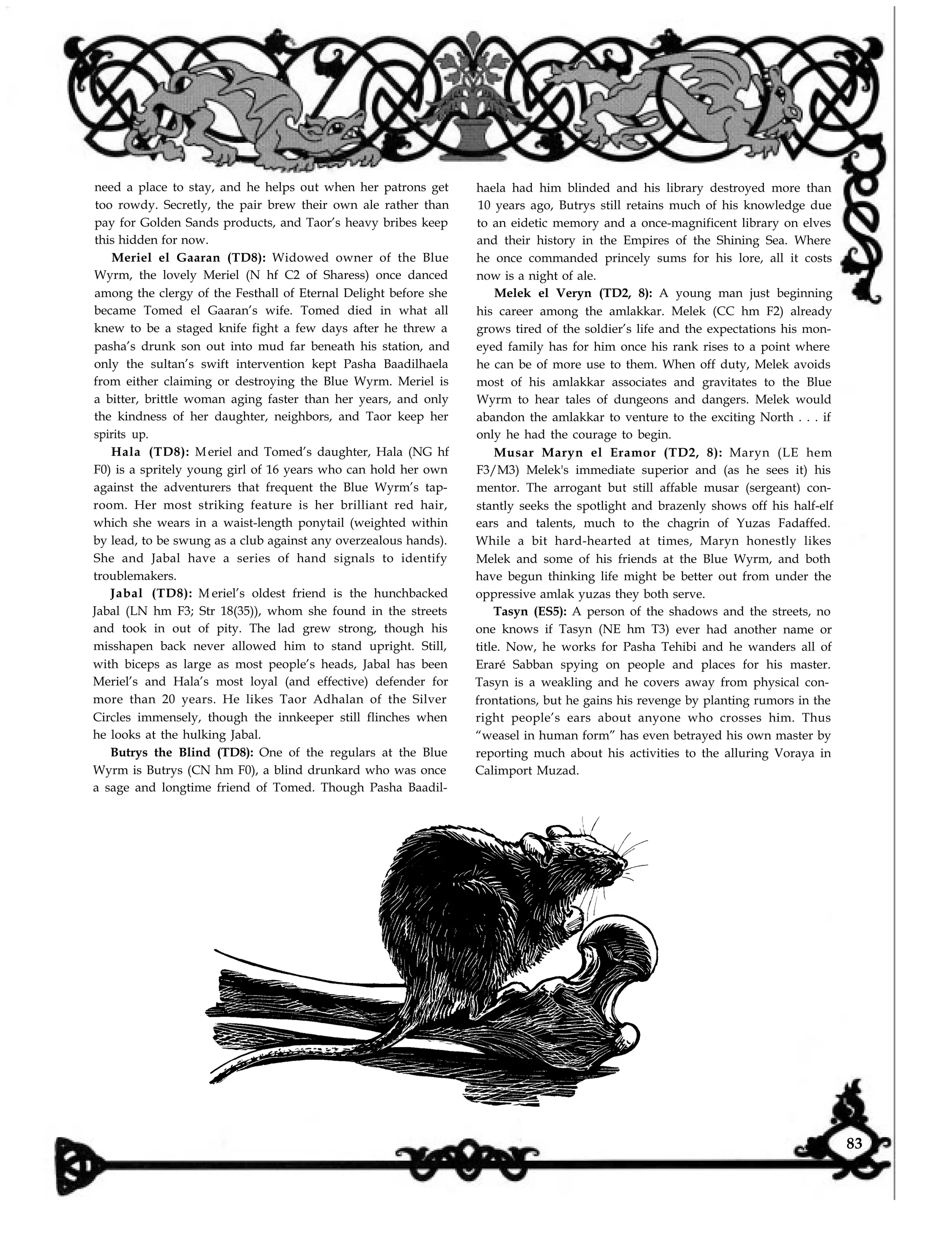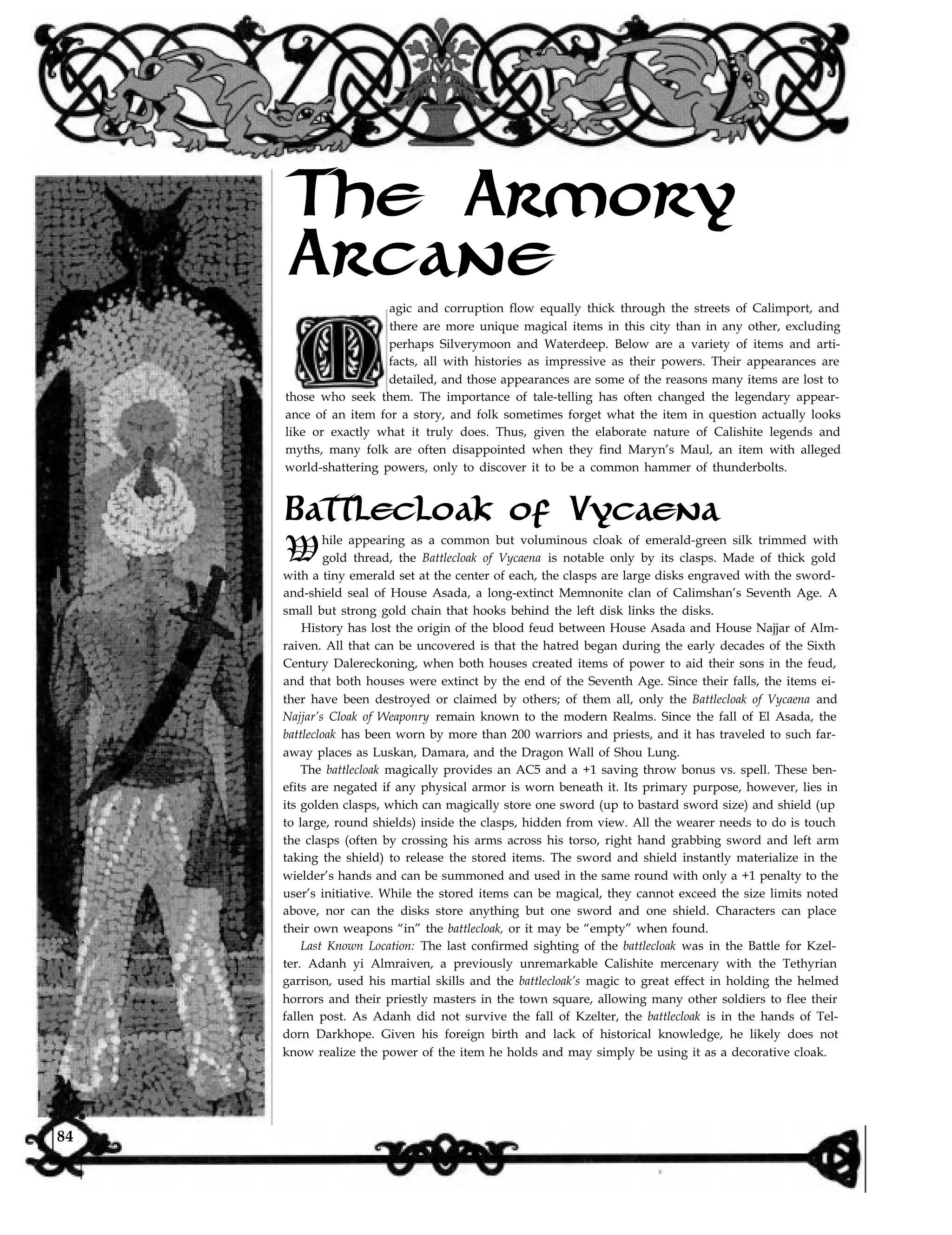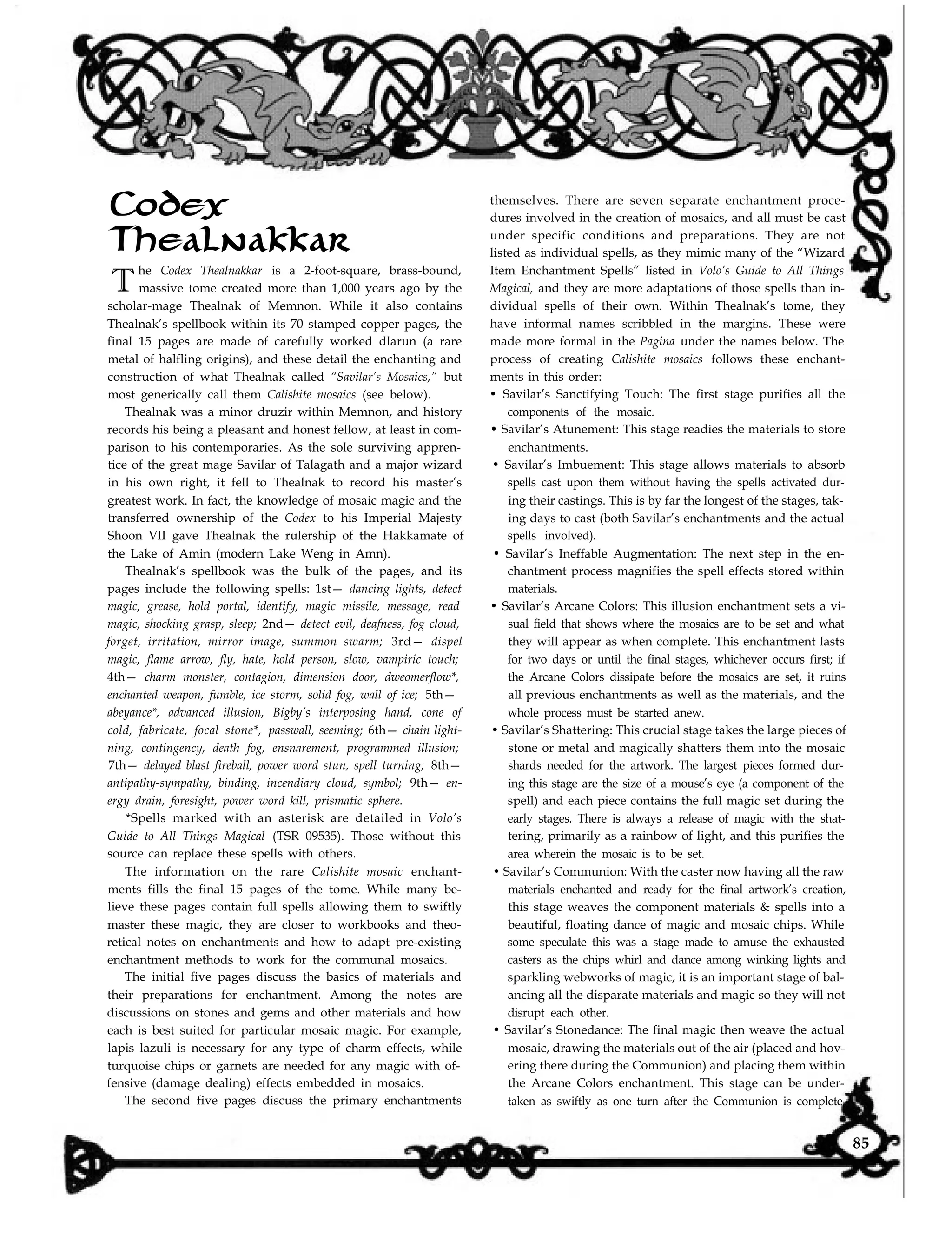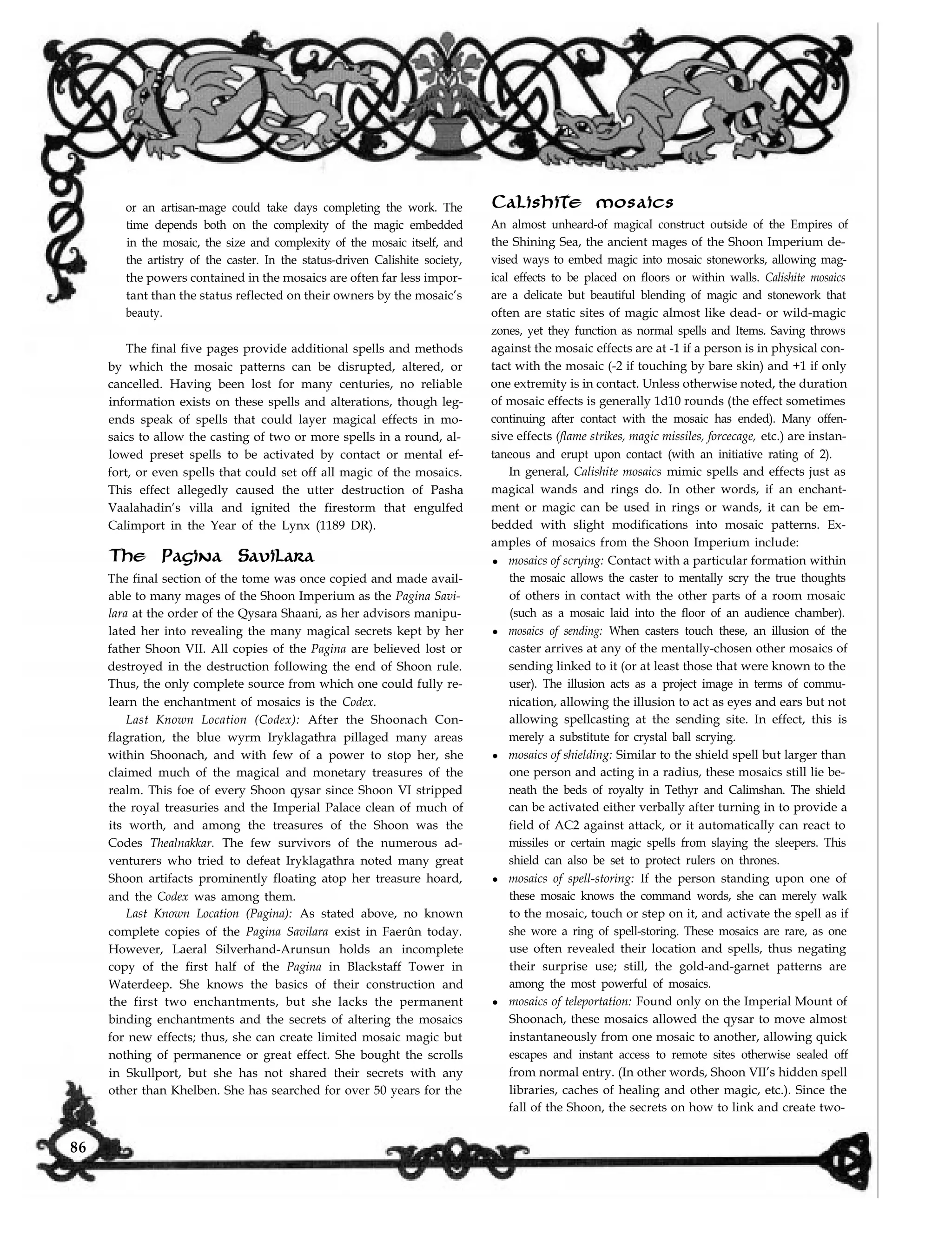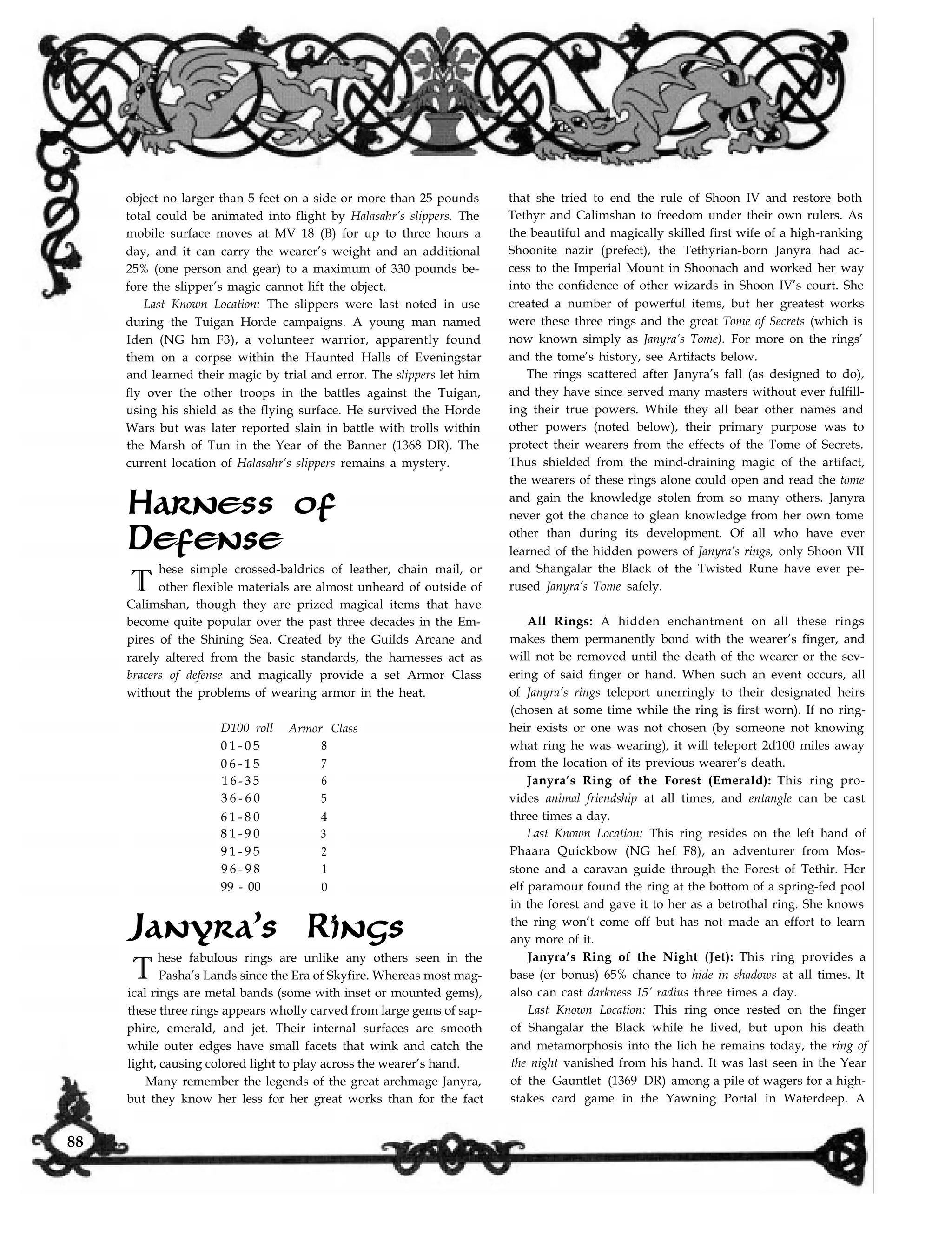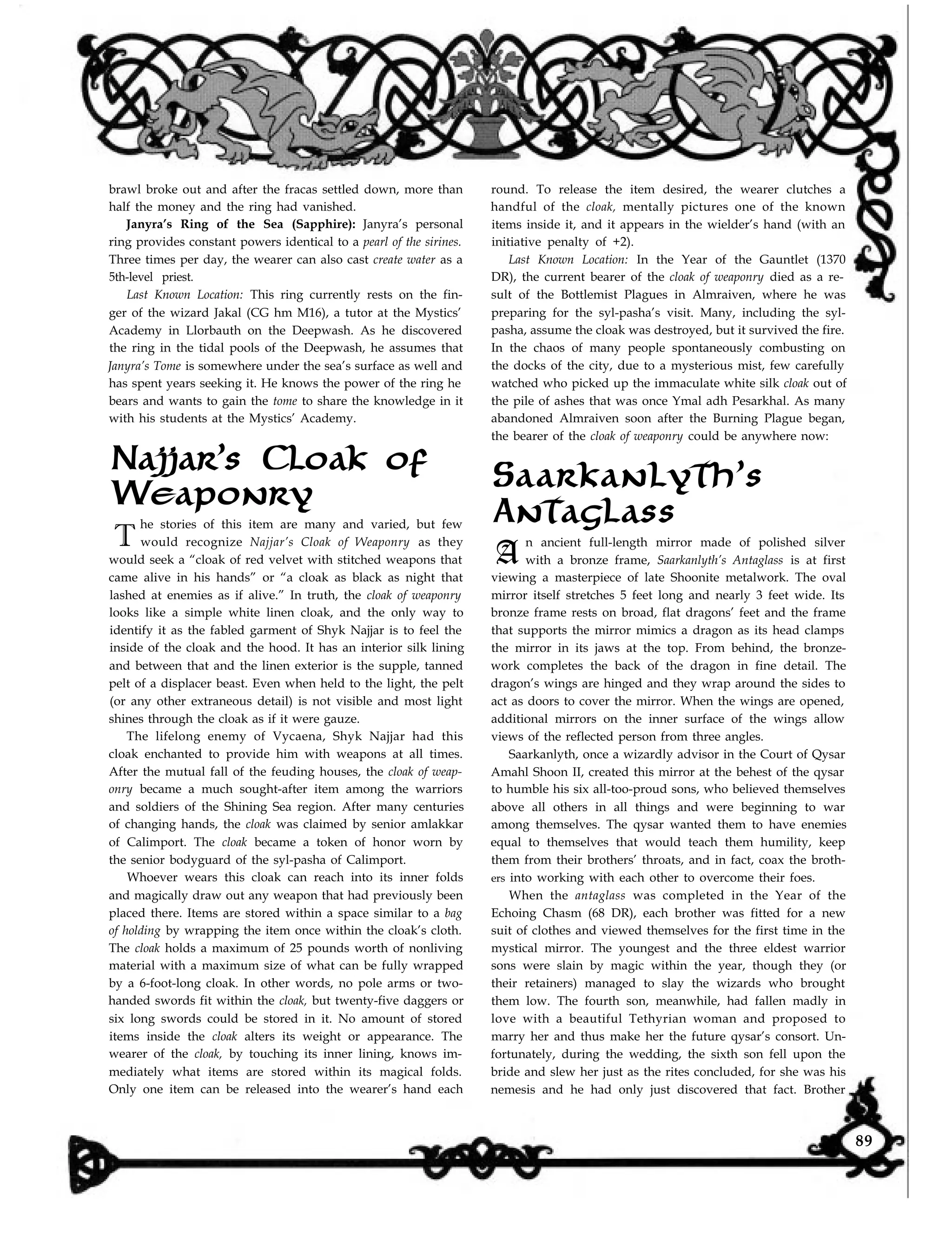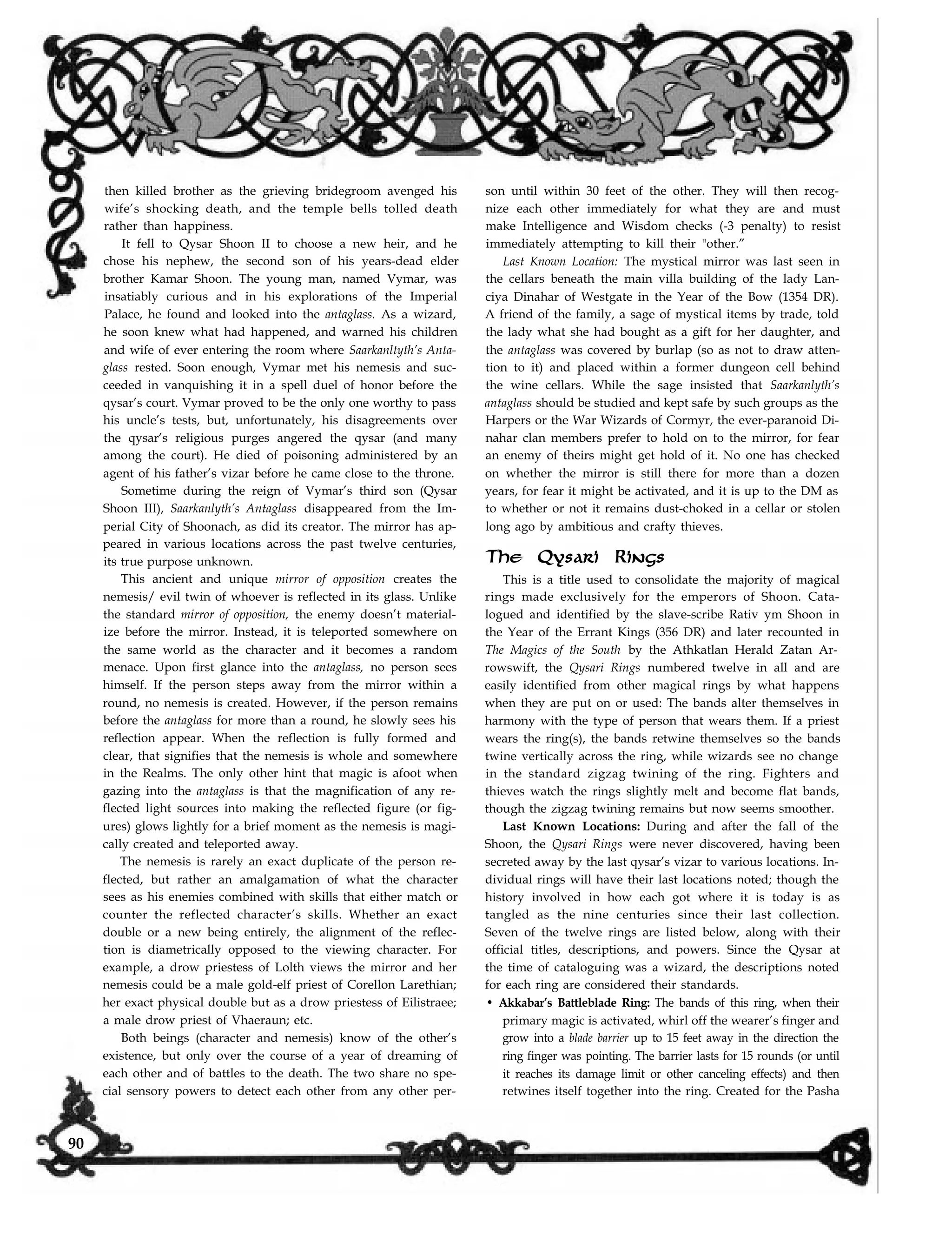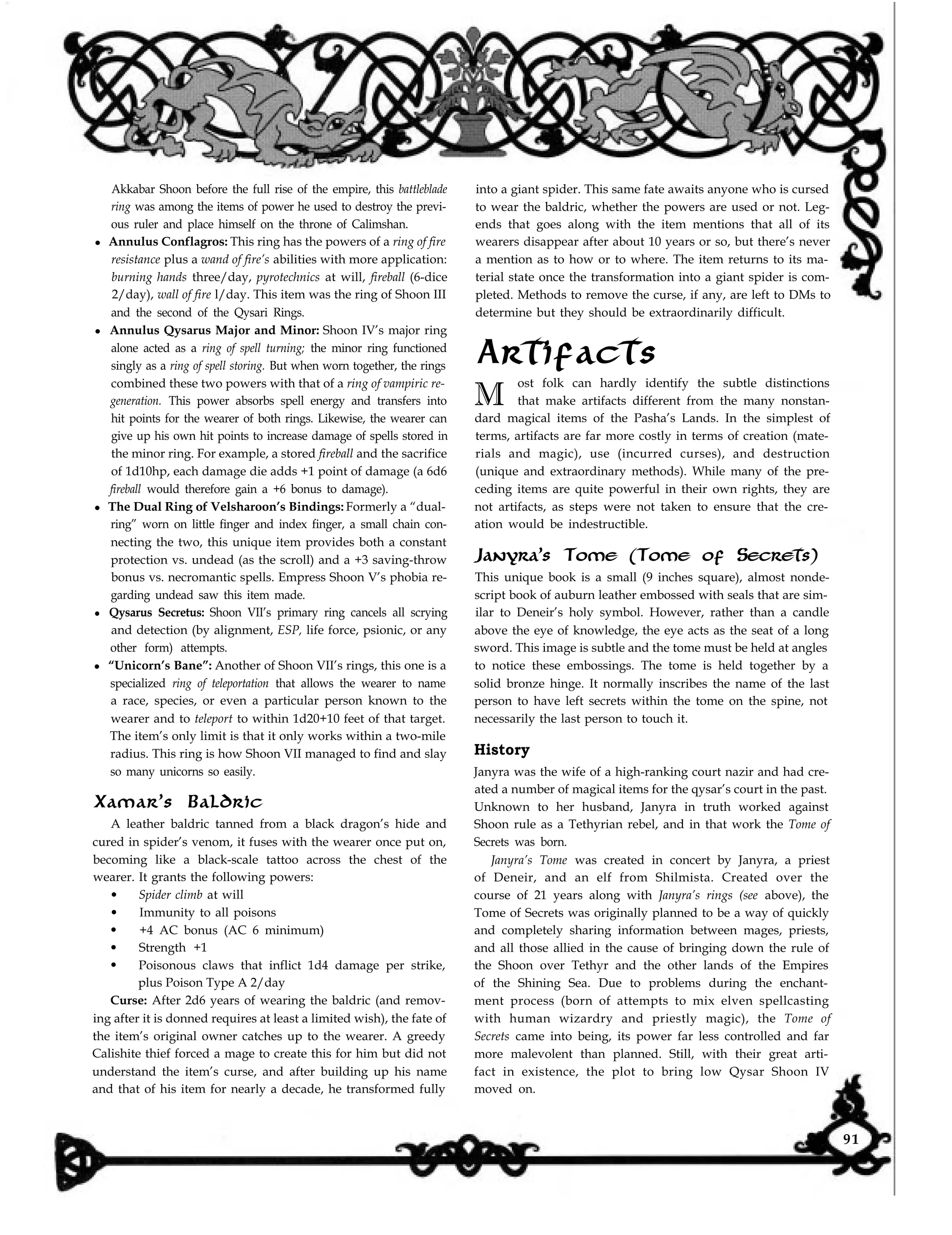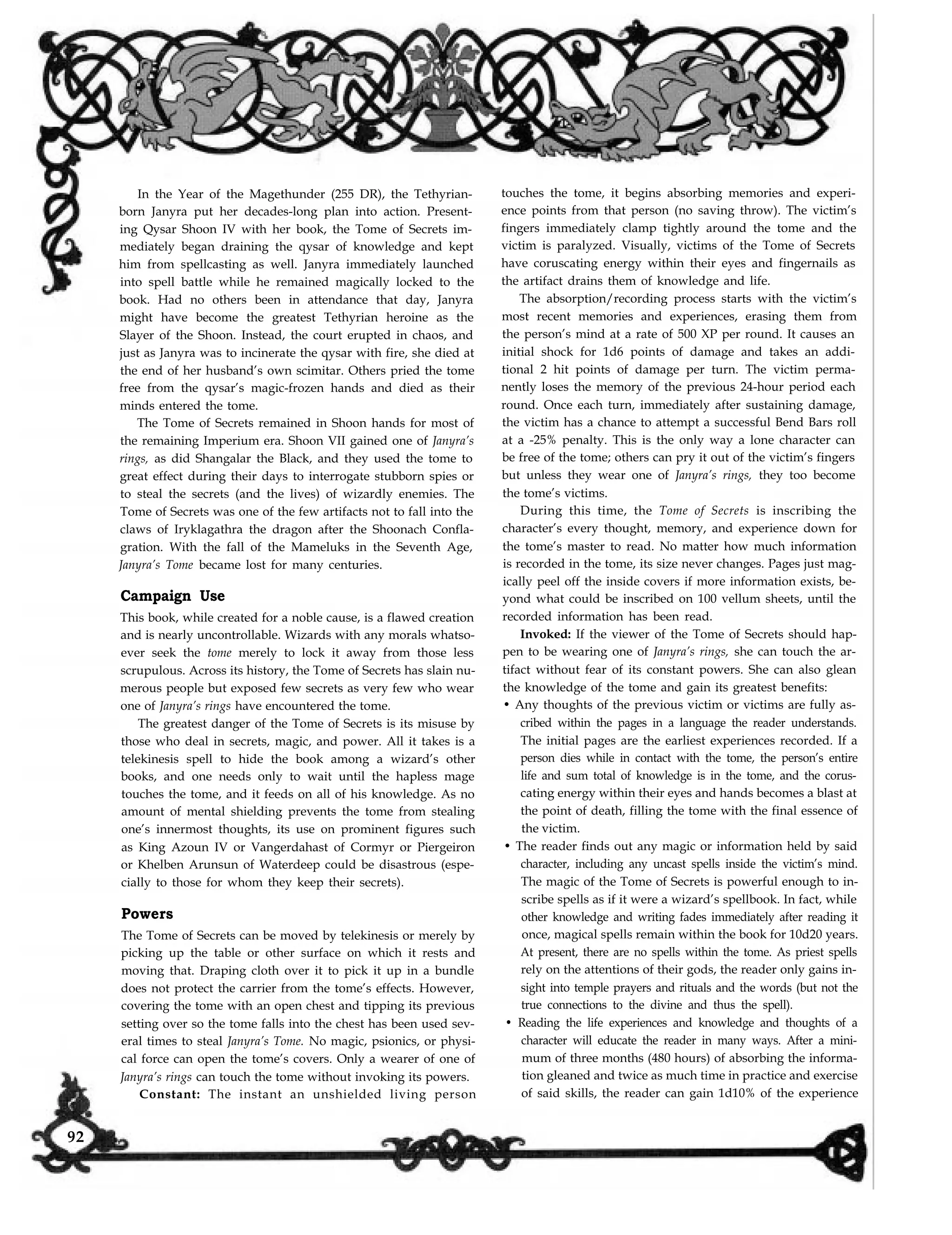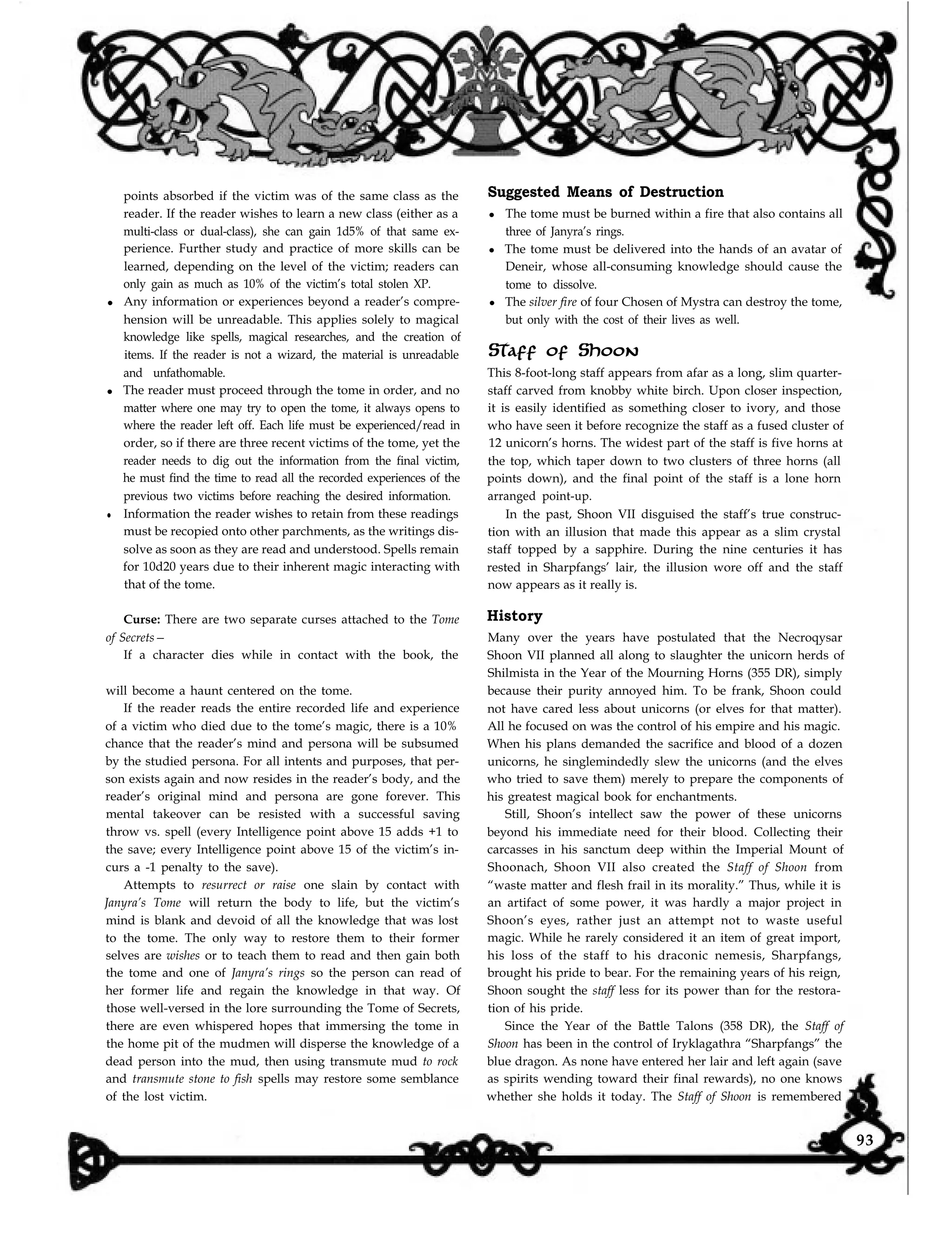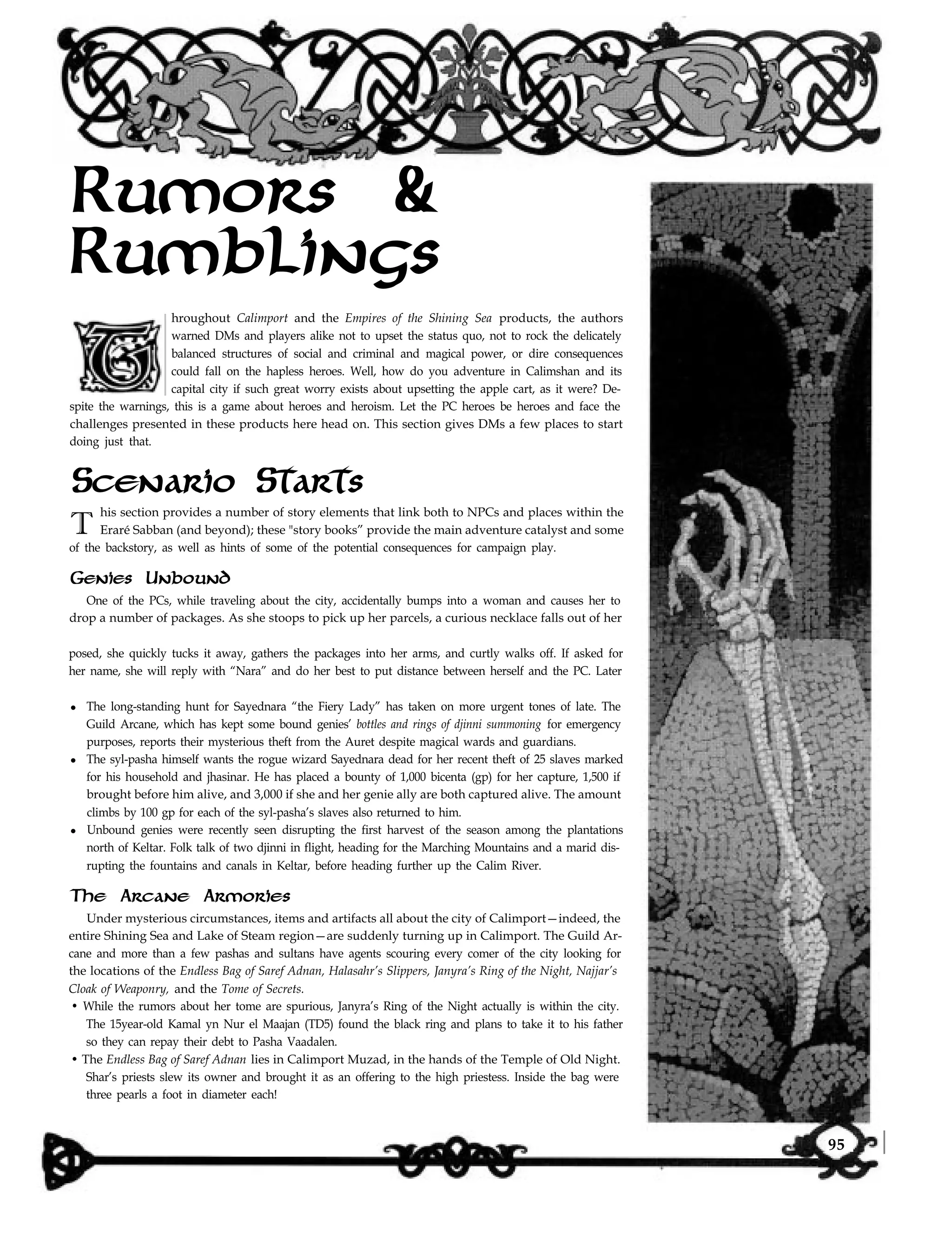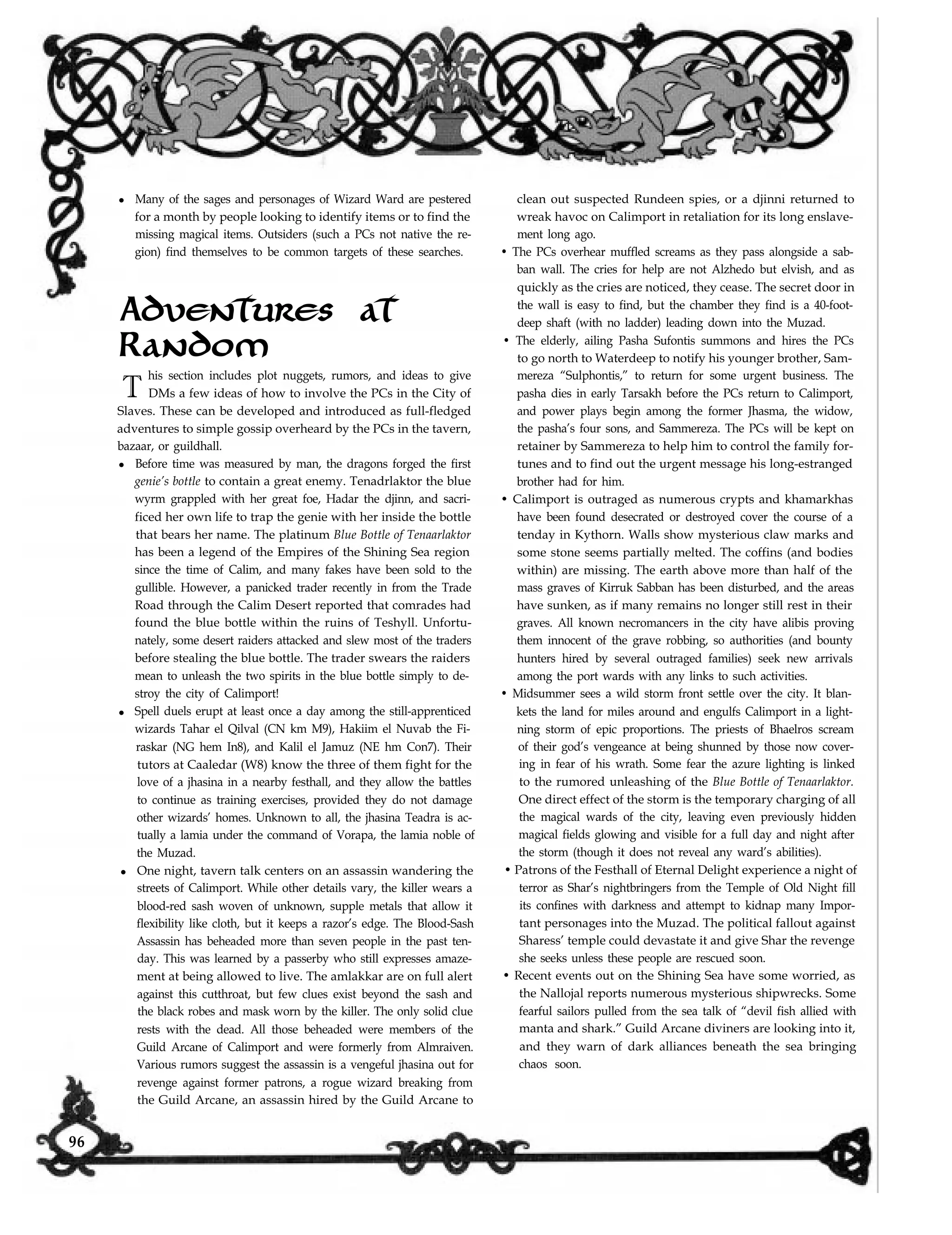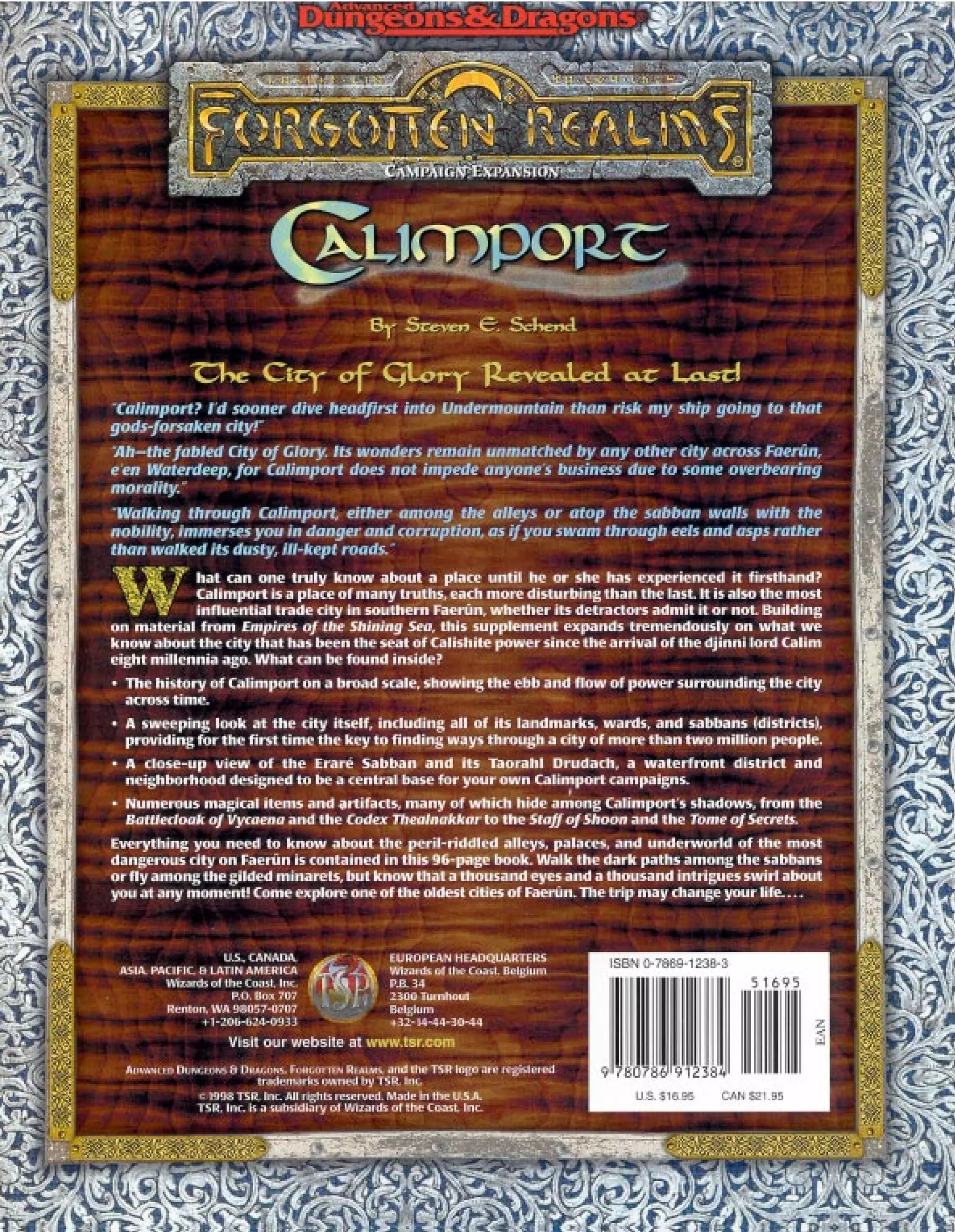This document provides an overview of the city of Calimport, including its history, structure, wards, and notable locations. Calimport began as a small coastal town and grew over time due to its strategic port location. The city is divided into 17 wards, each governed by a noble family called a sabban. Important locations include the Elder Wall remnants, various sabbans' manors, and the Pasha's palace. The document also gives a timeline of Calimport's history over the ages of the Calishite empire.
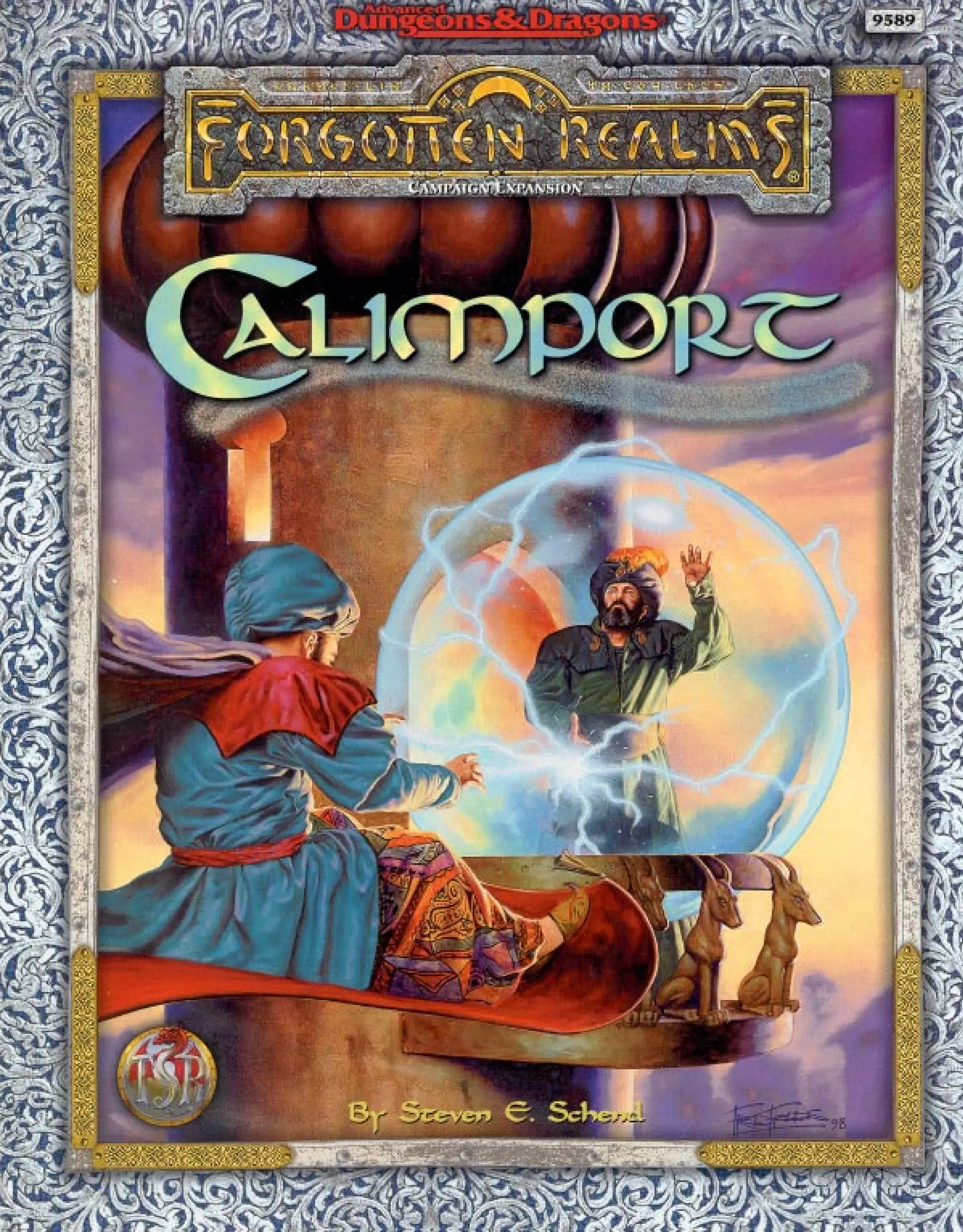
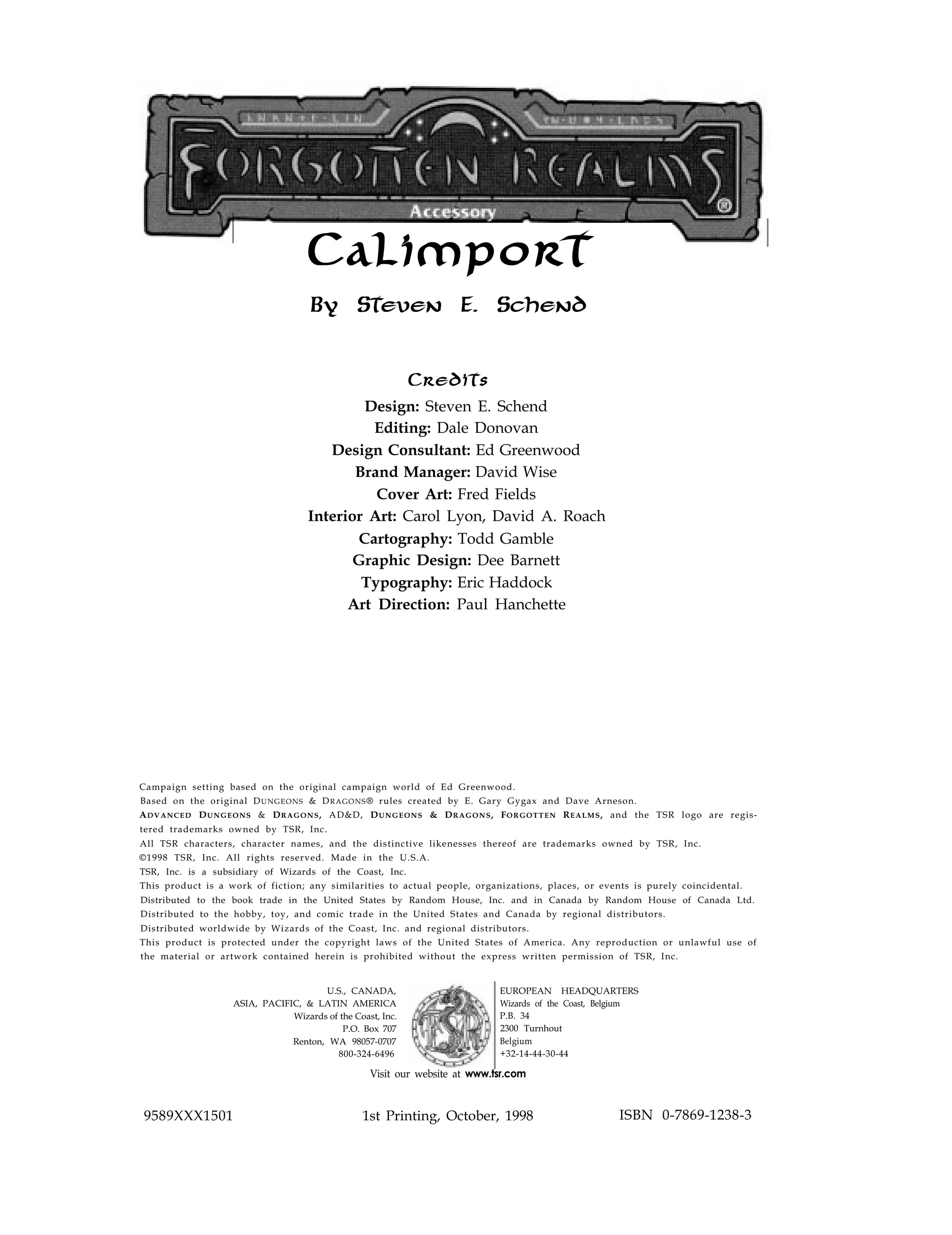

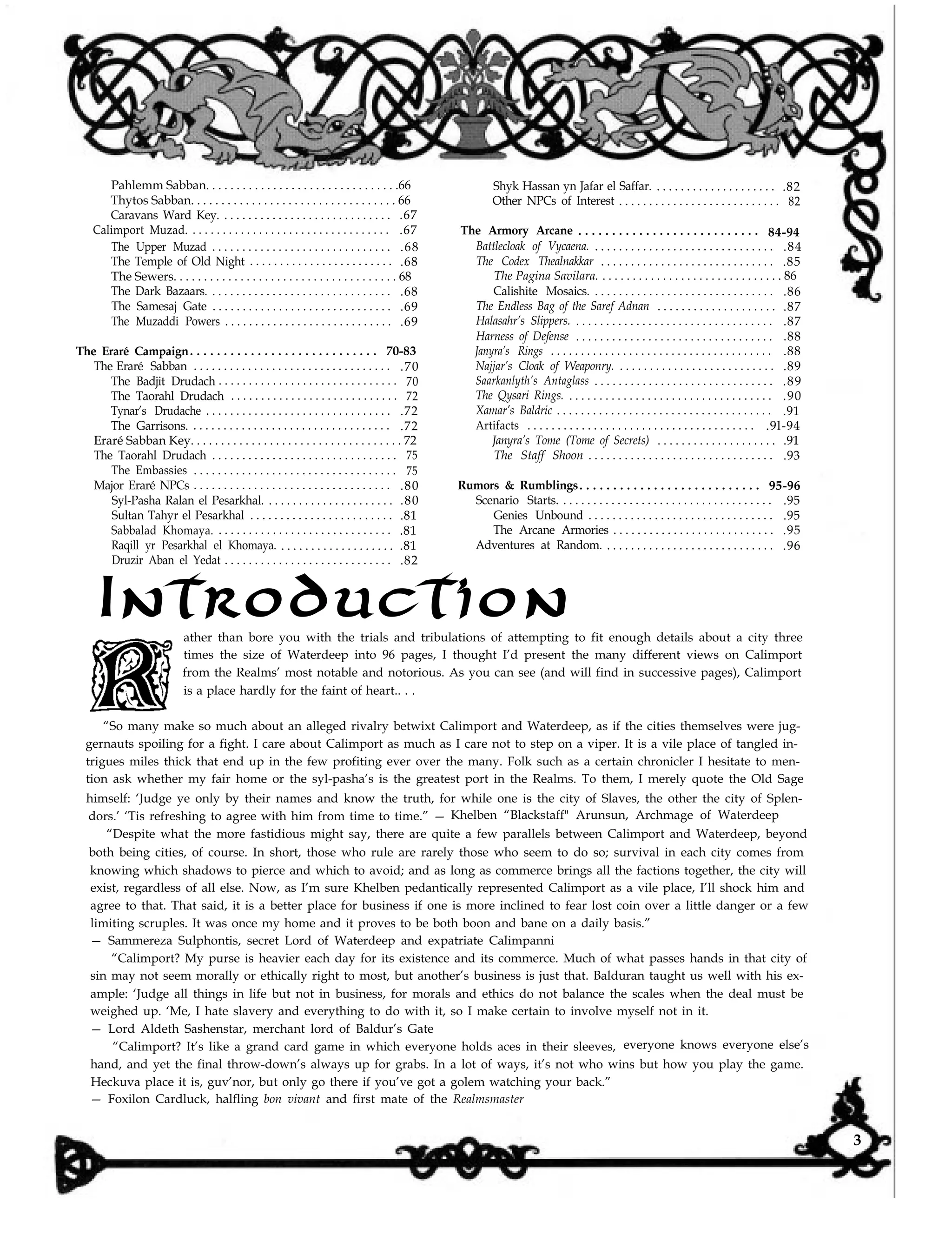
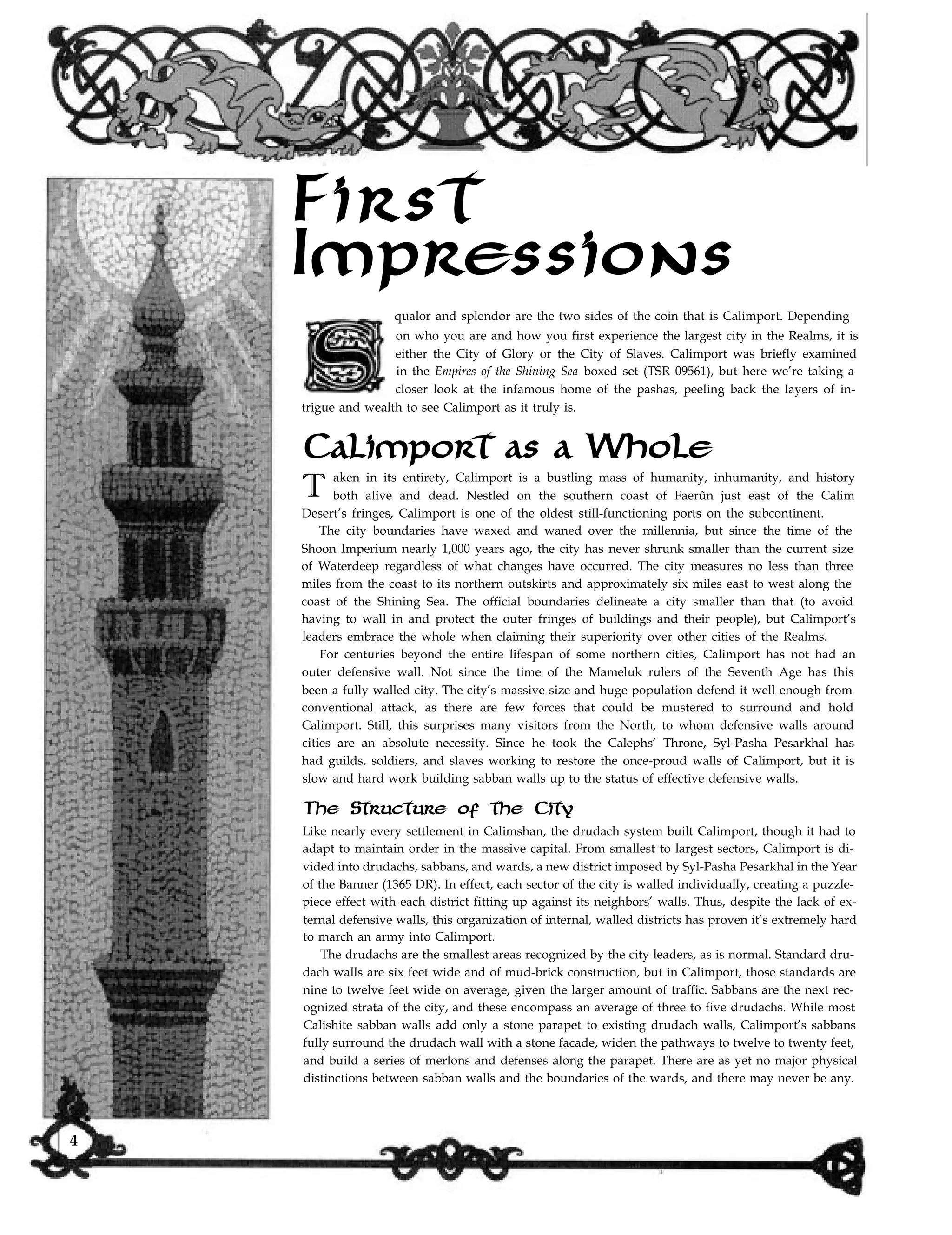
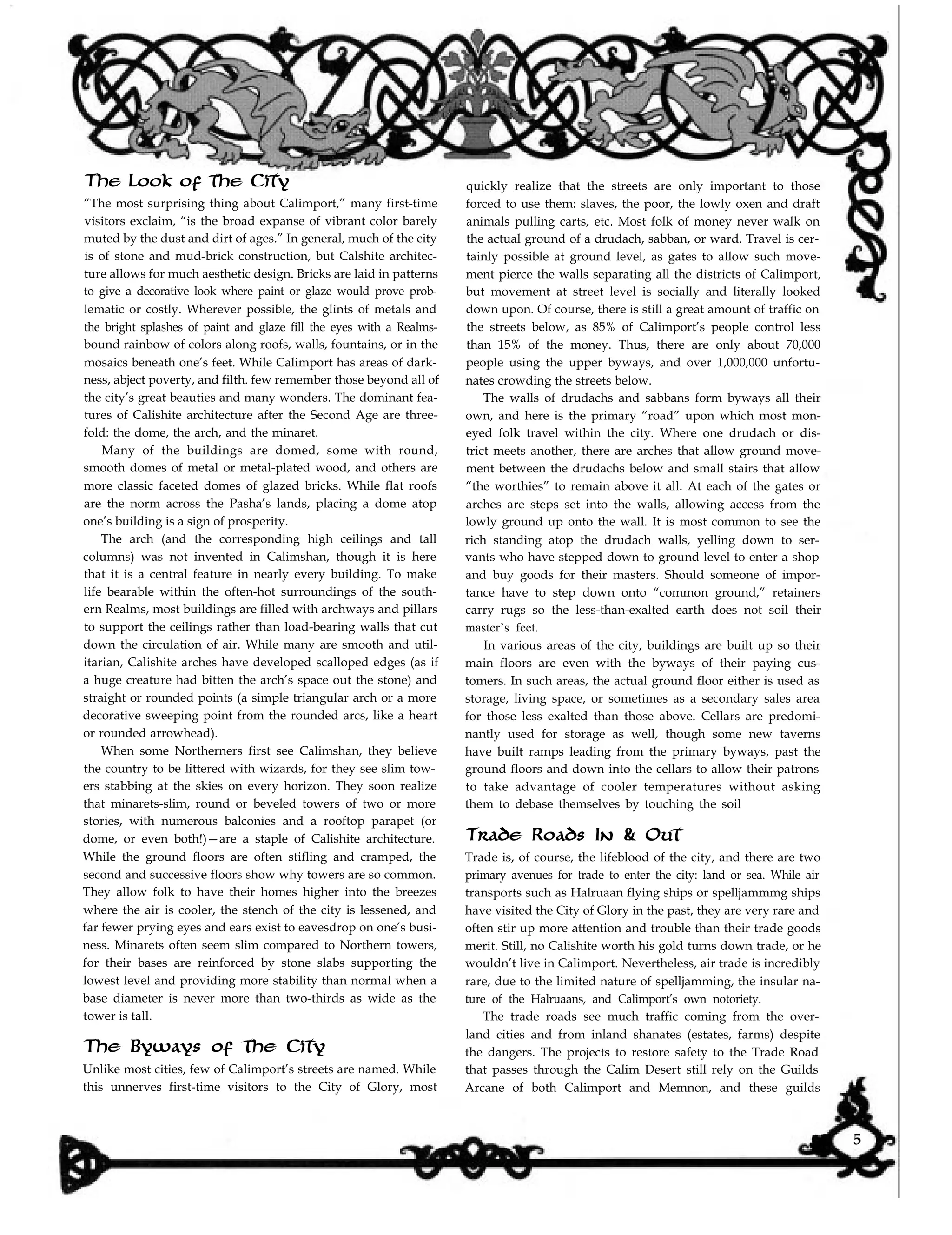
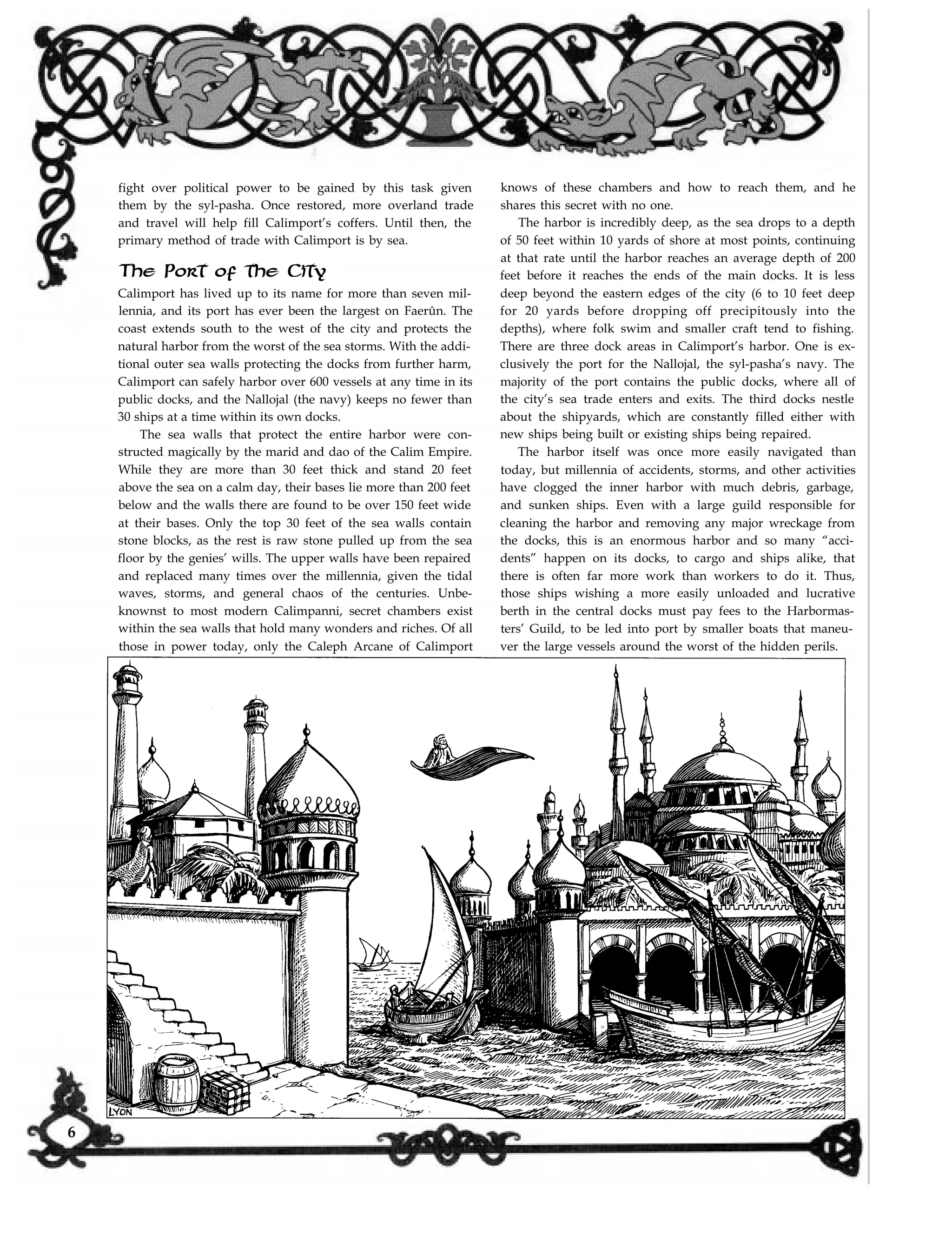
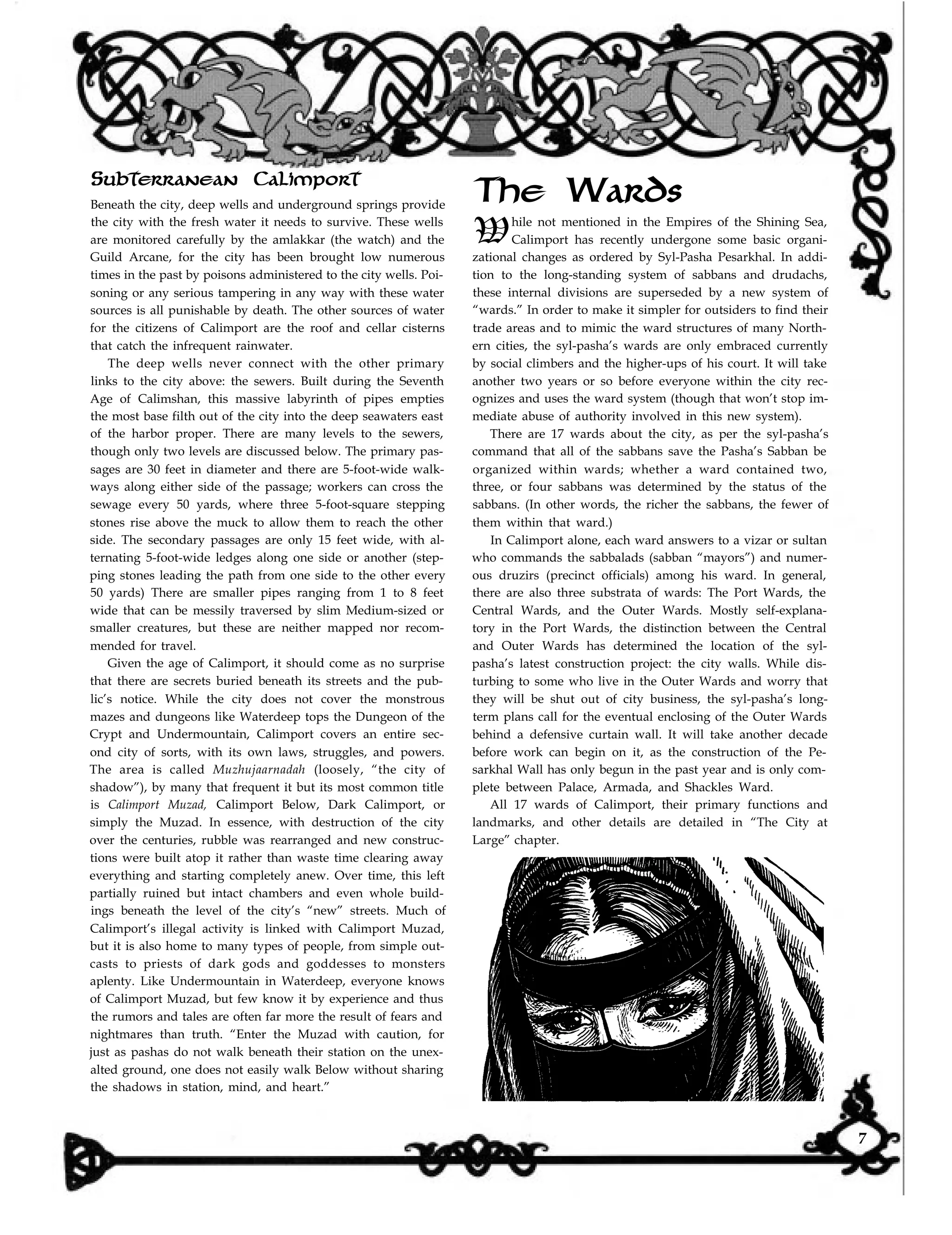
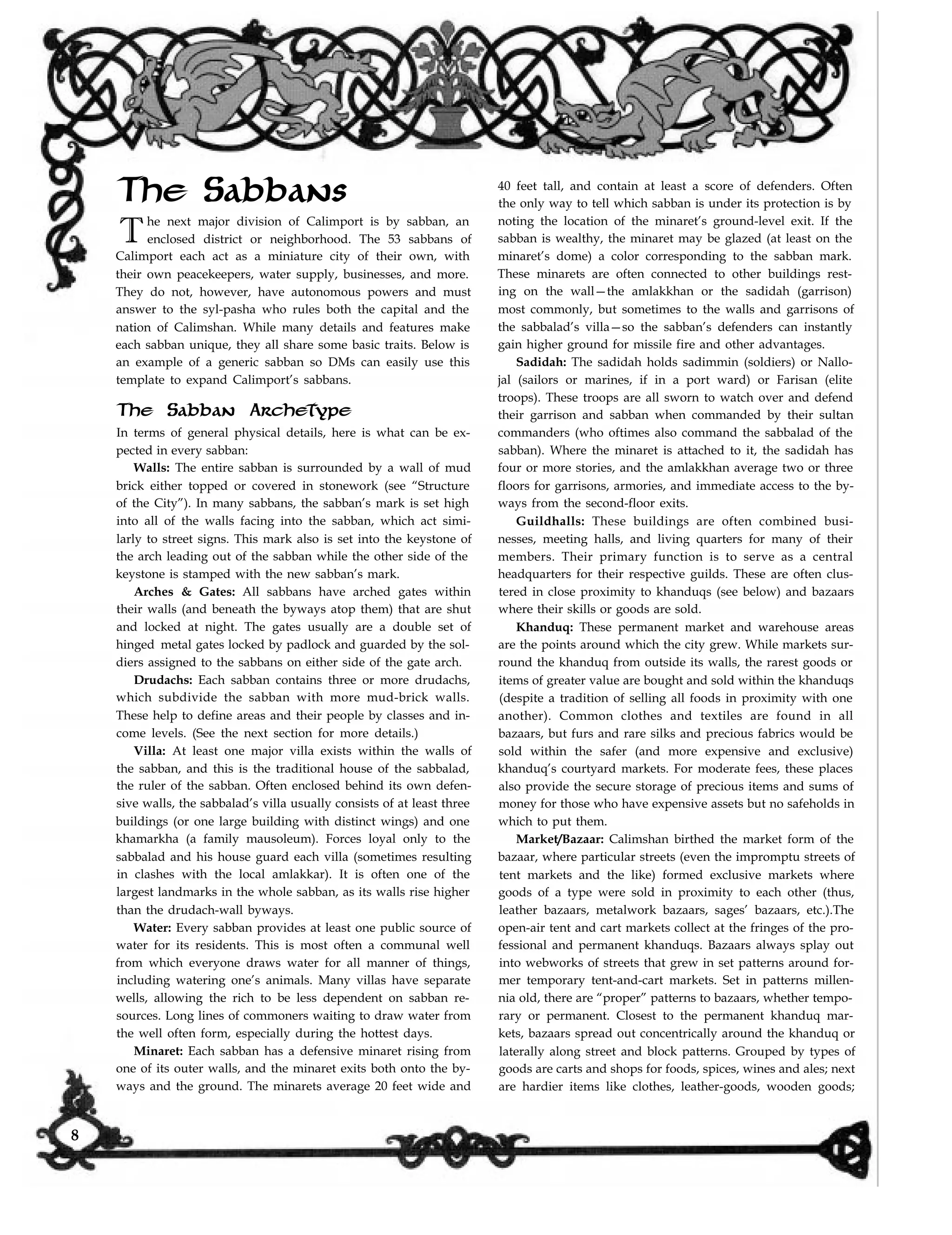

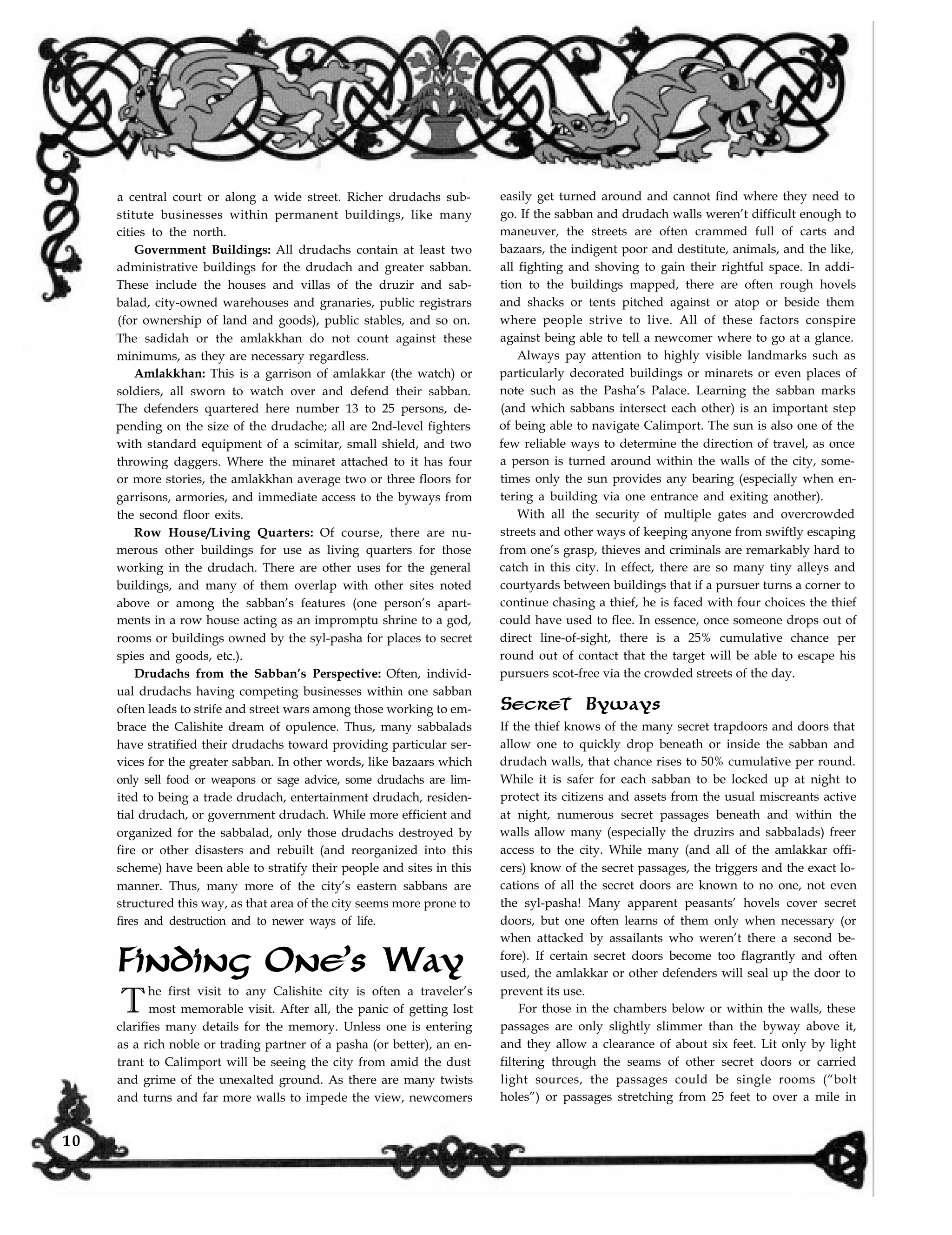
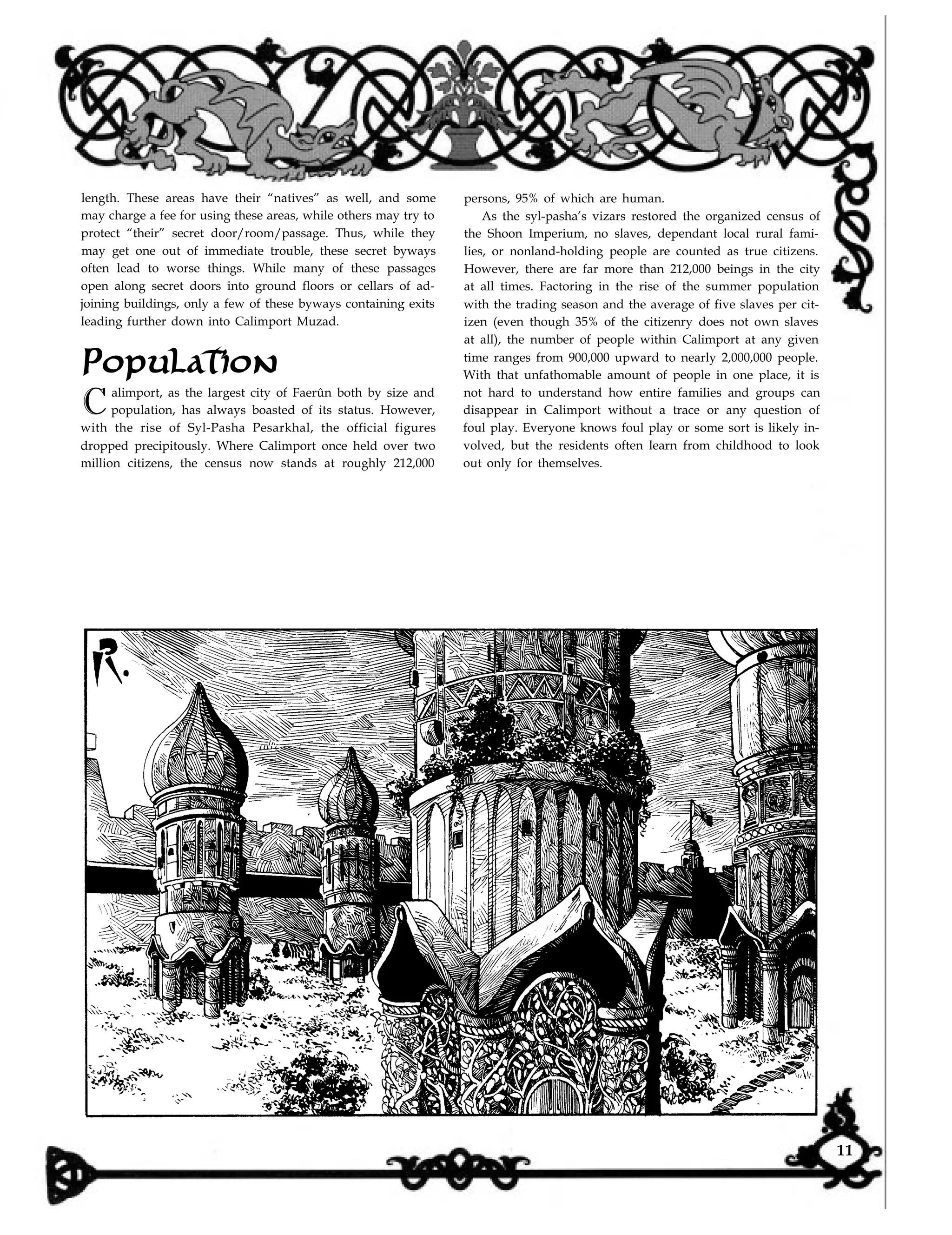

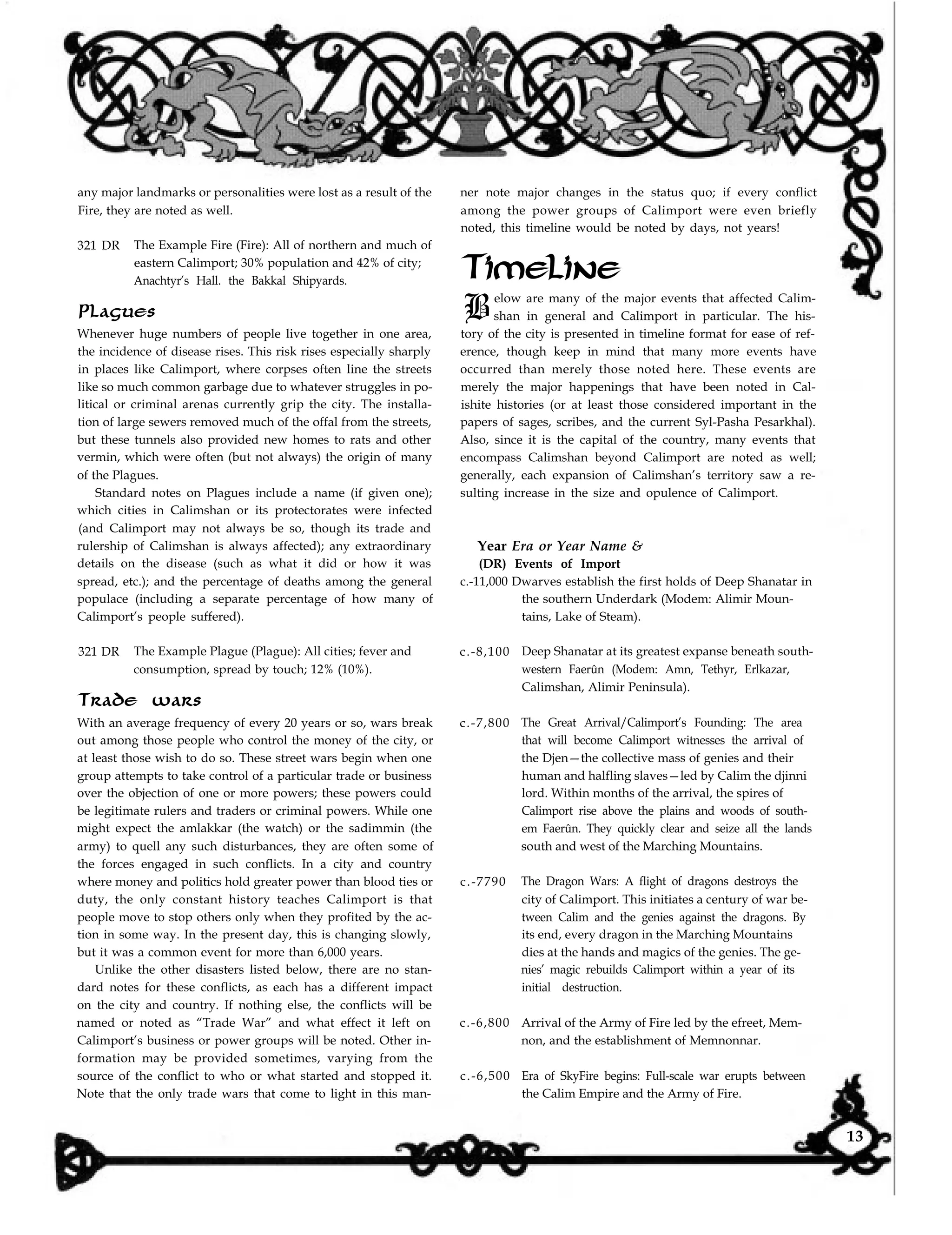
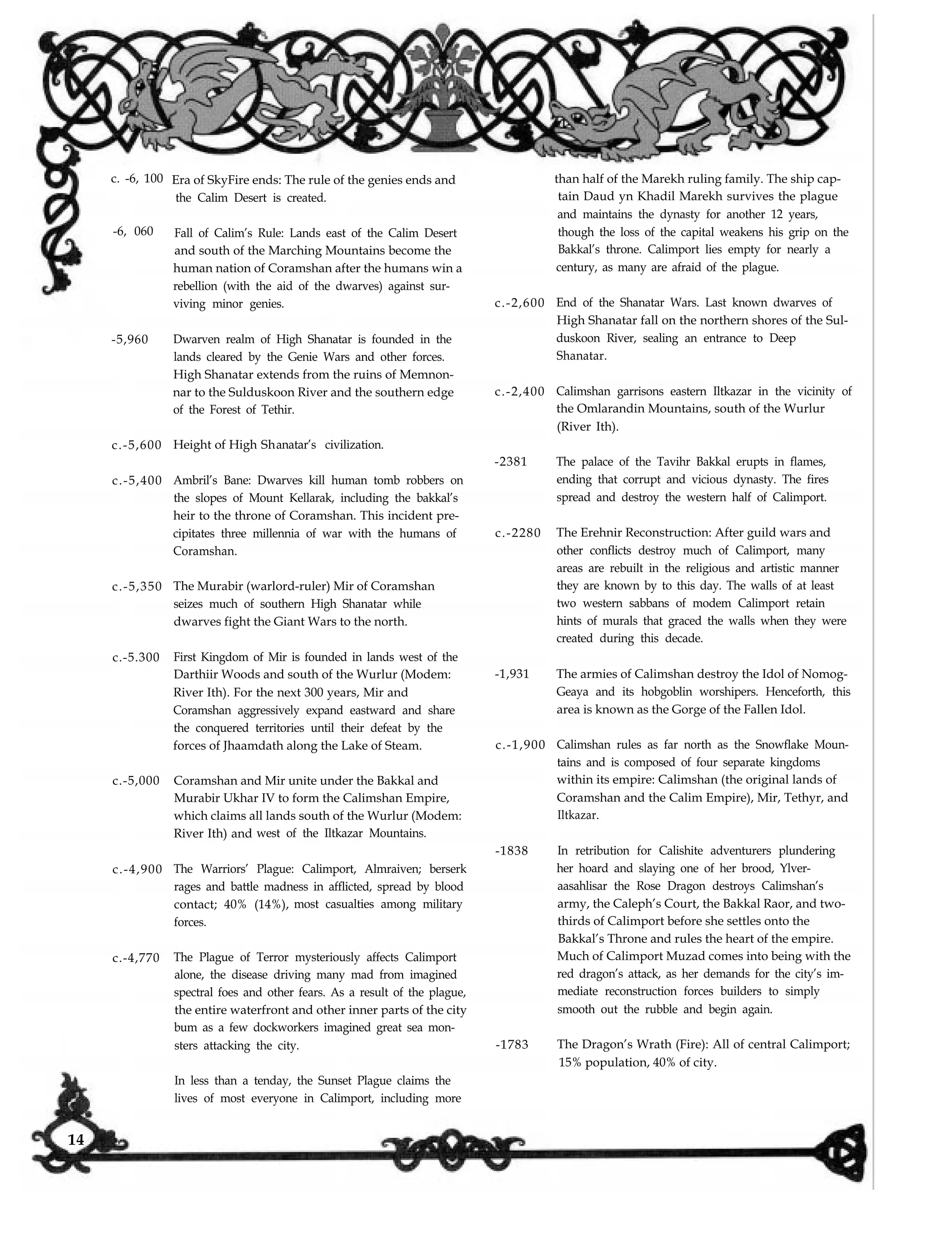
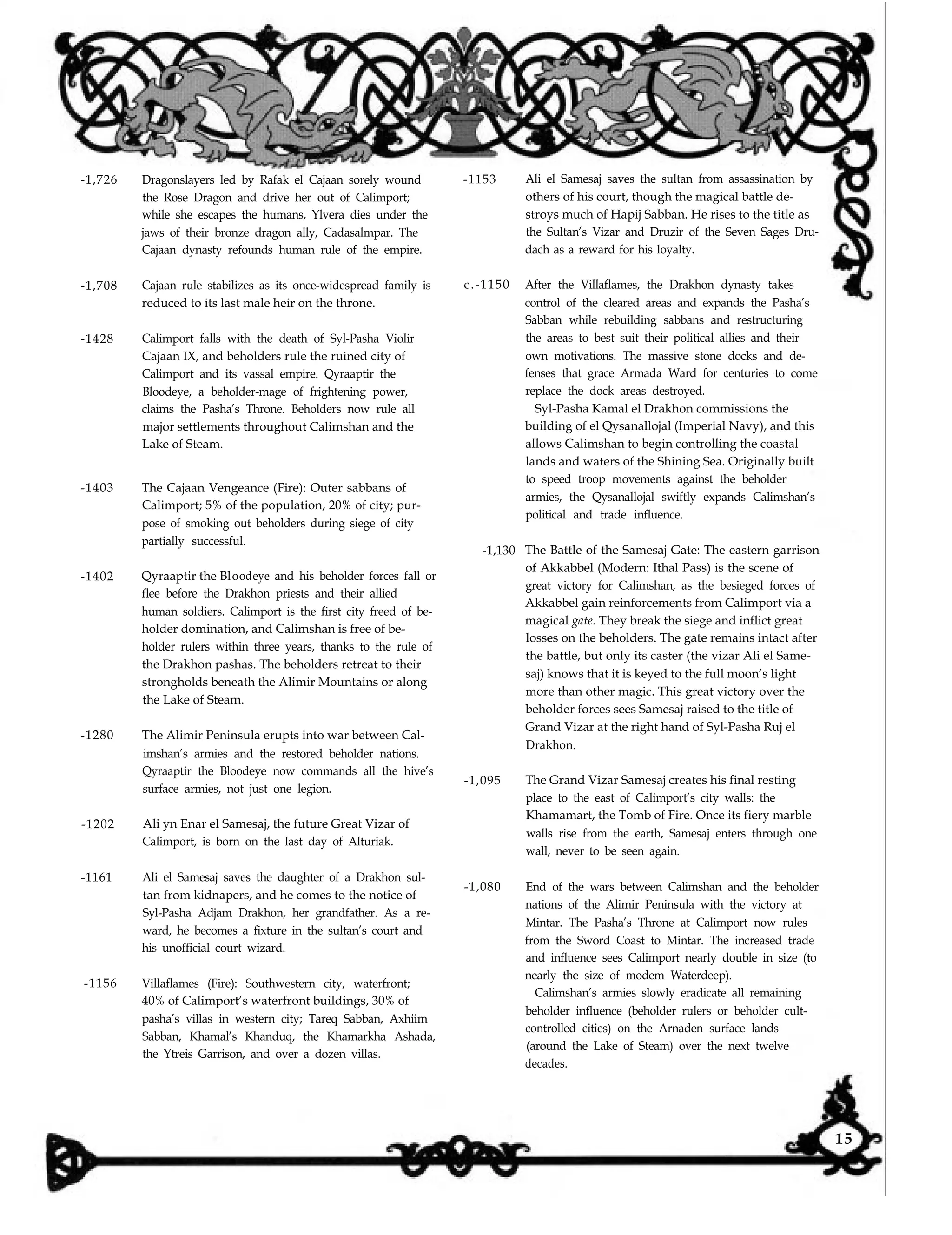
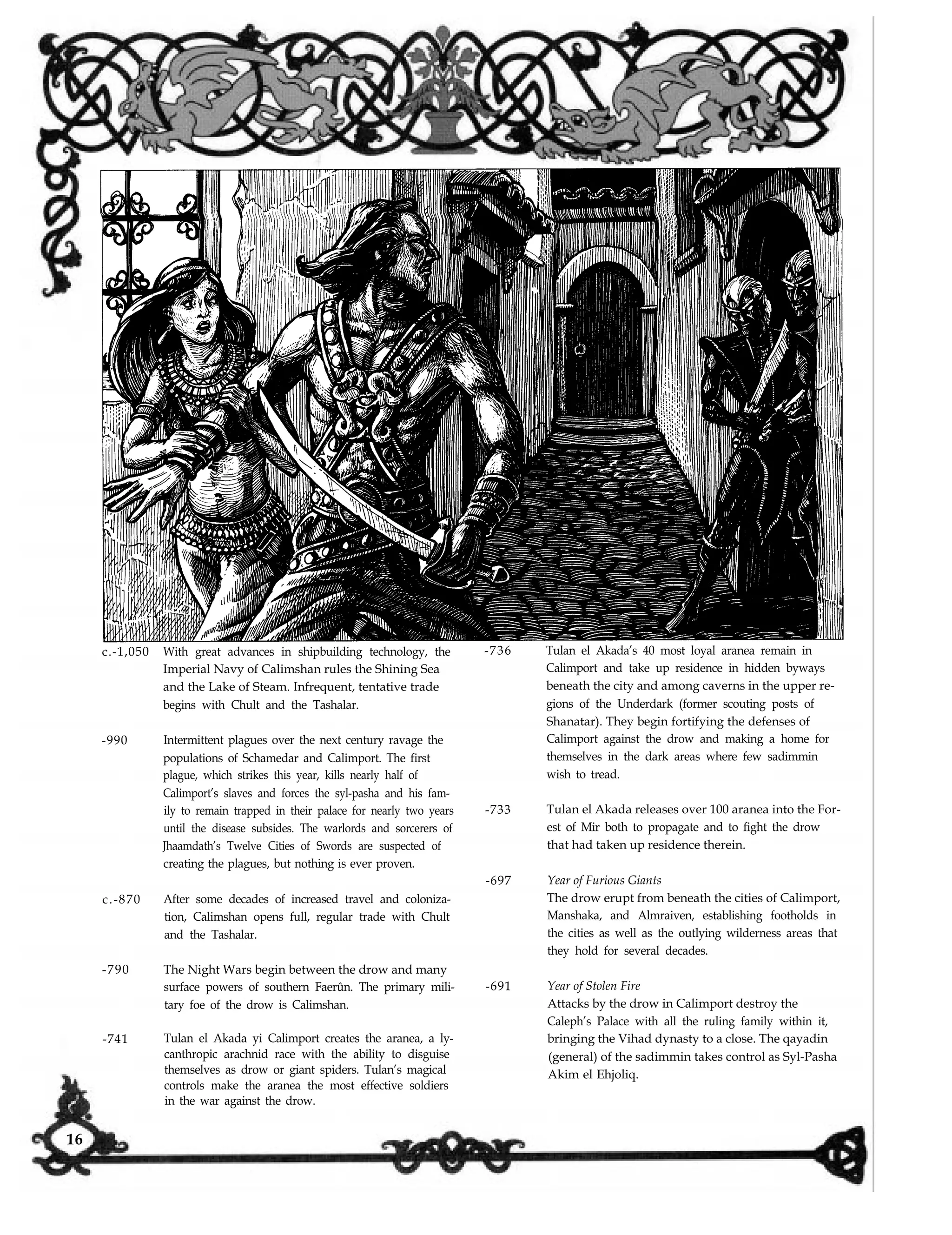
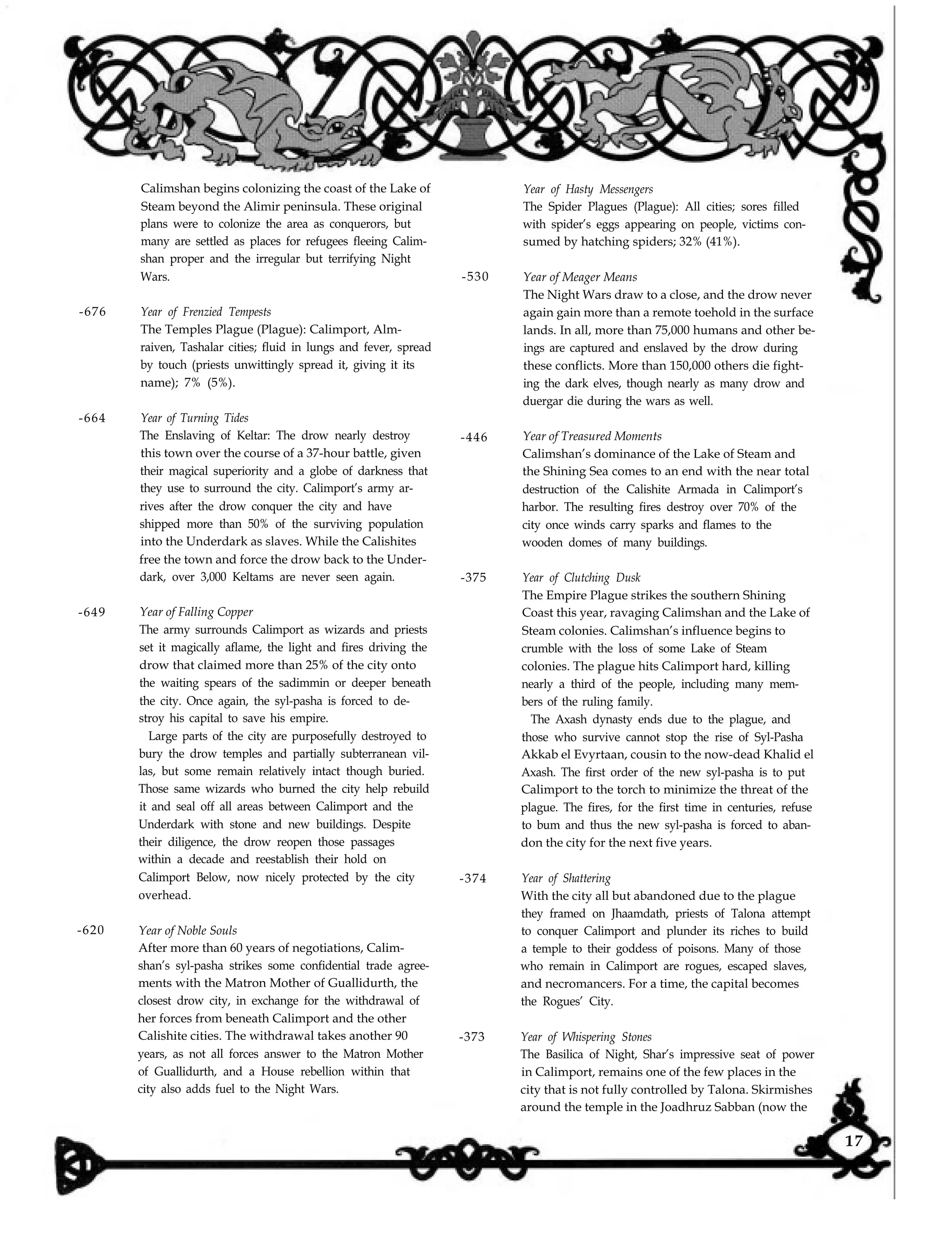

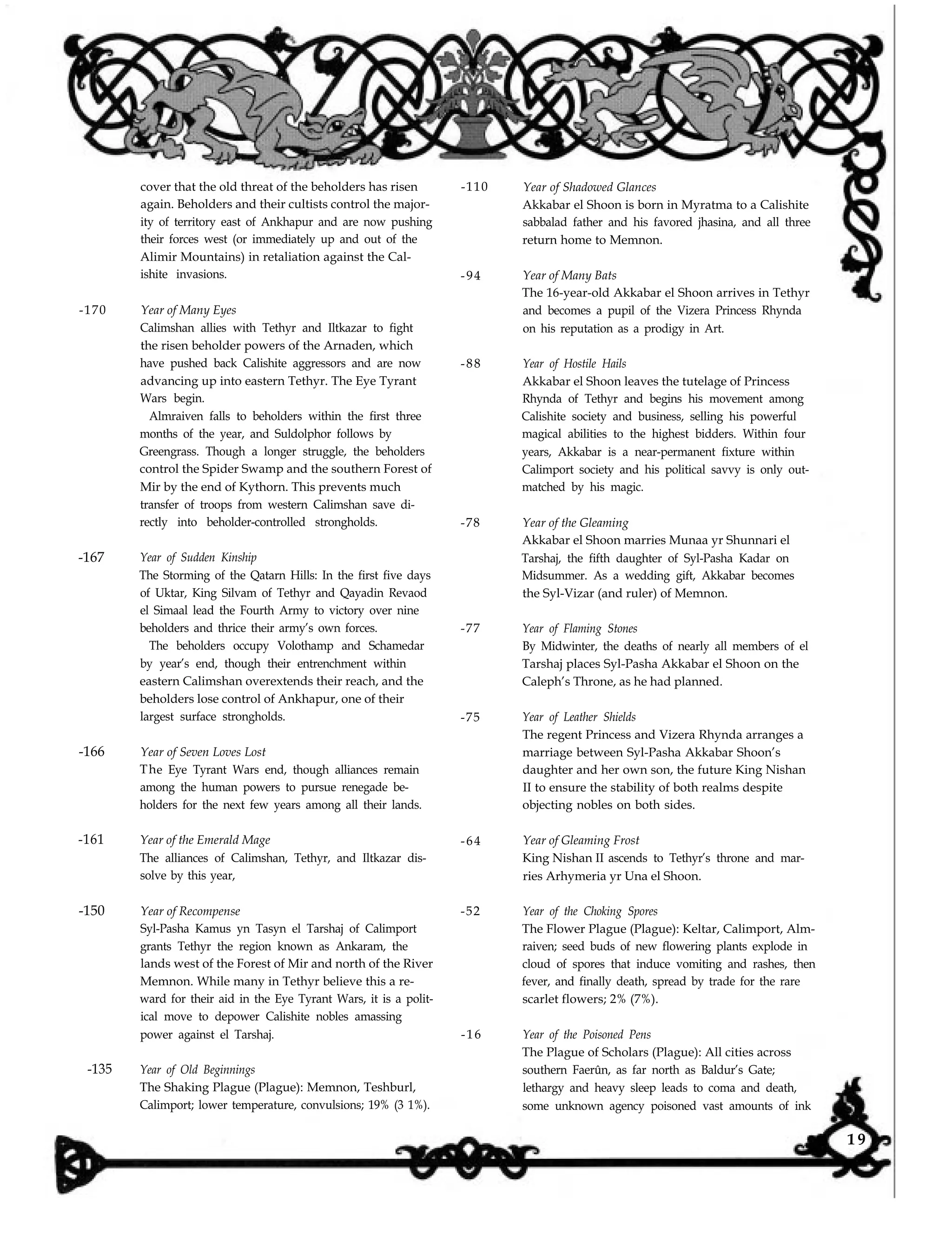
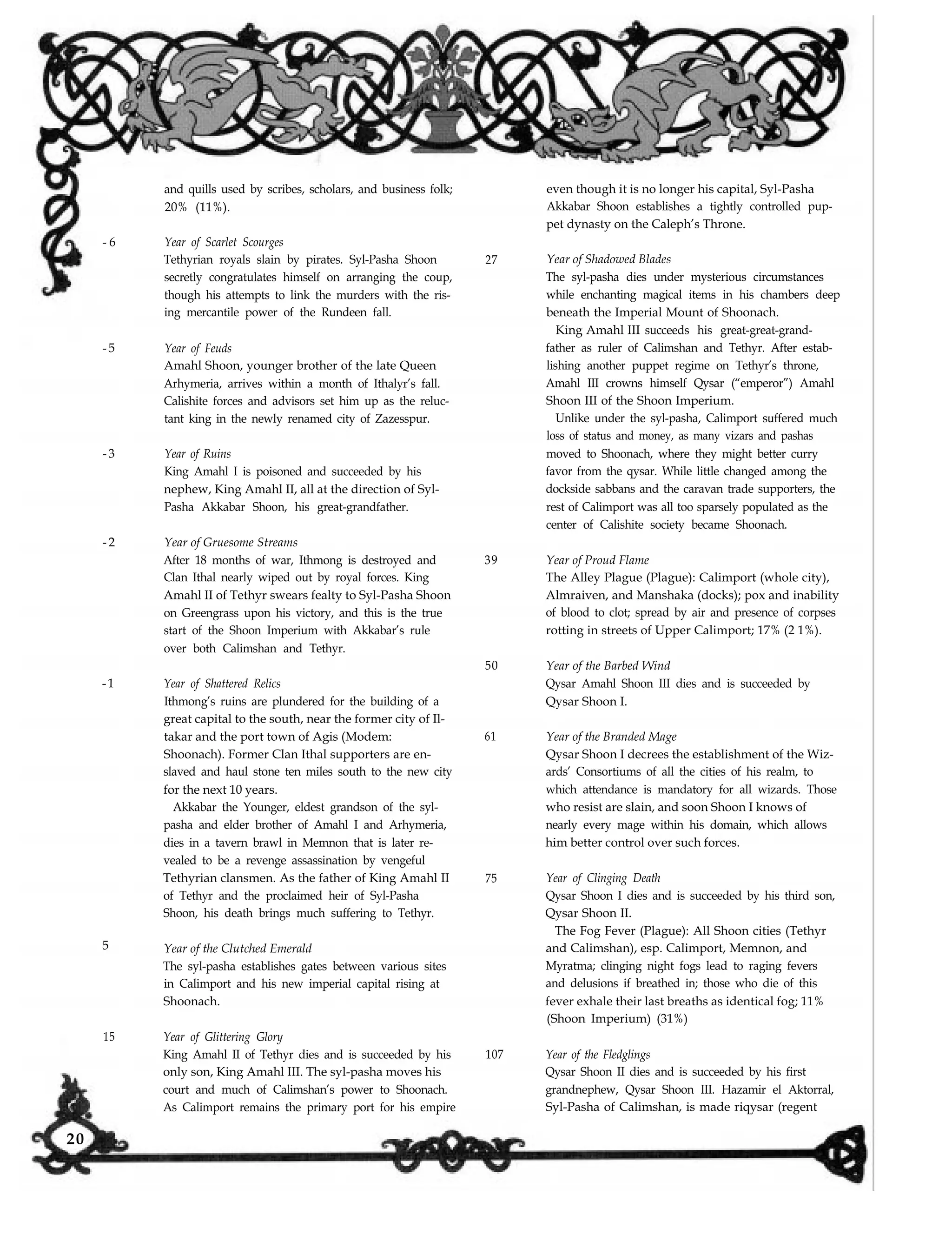
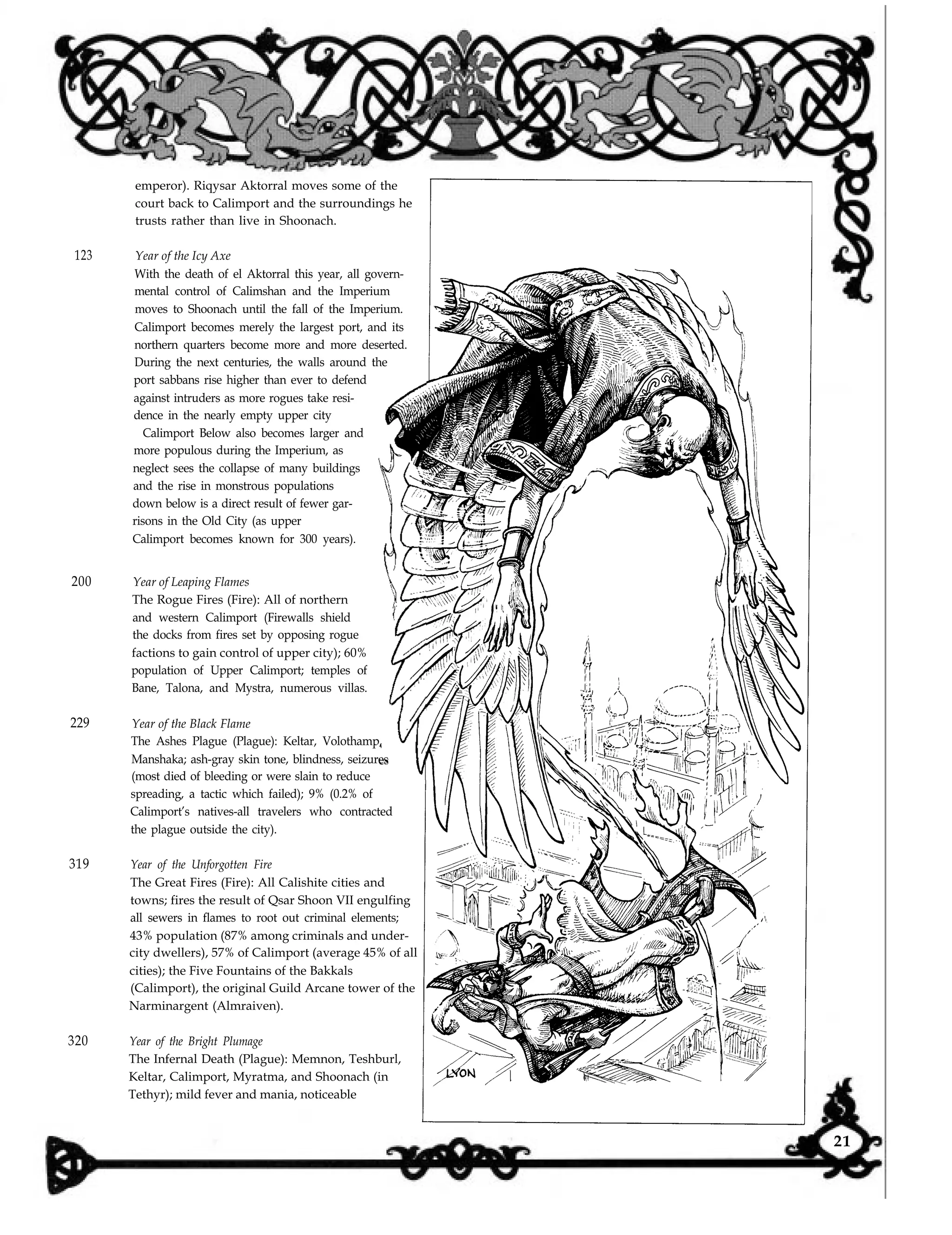
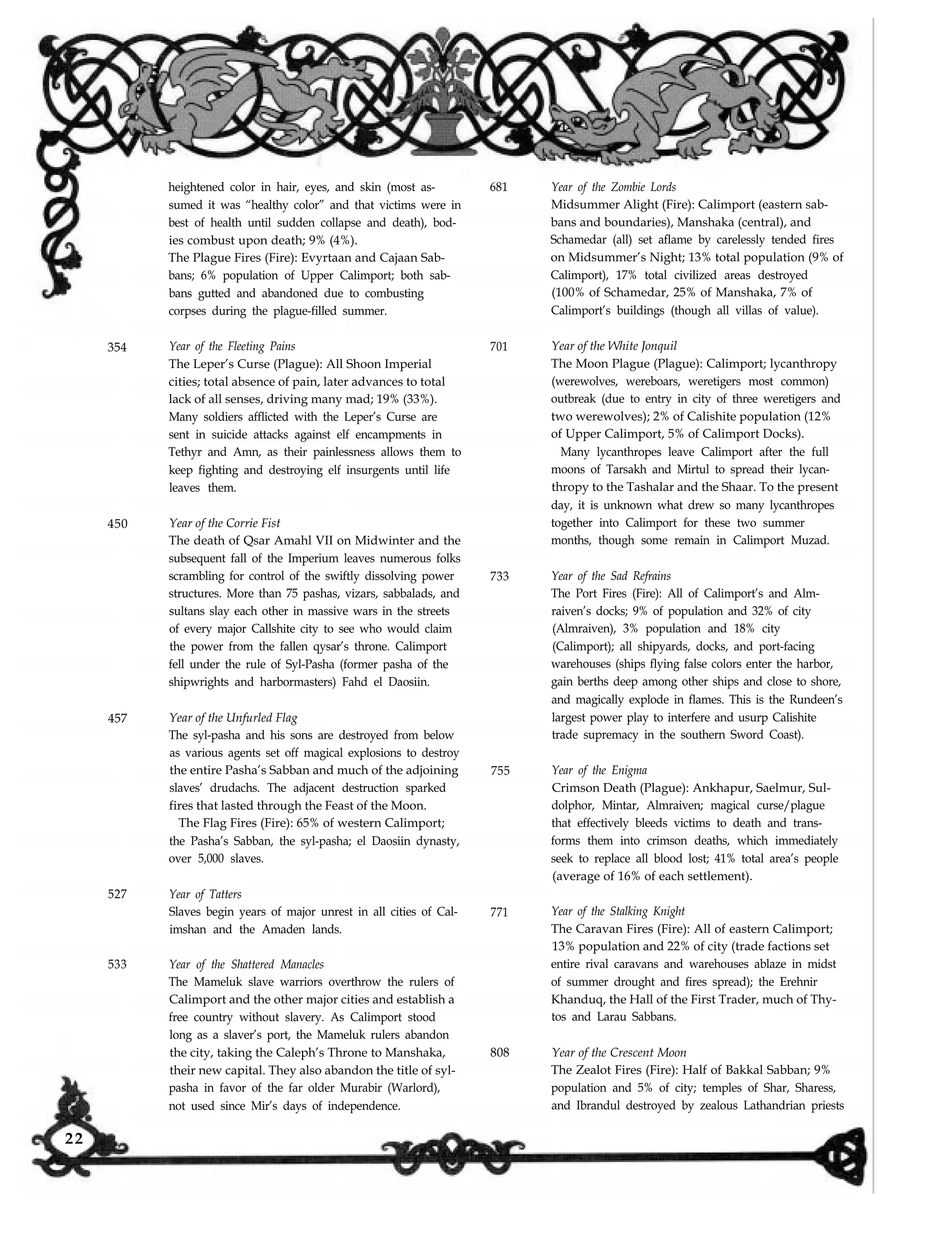
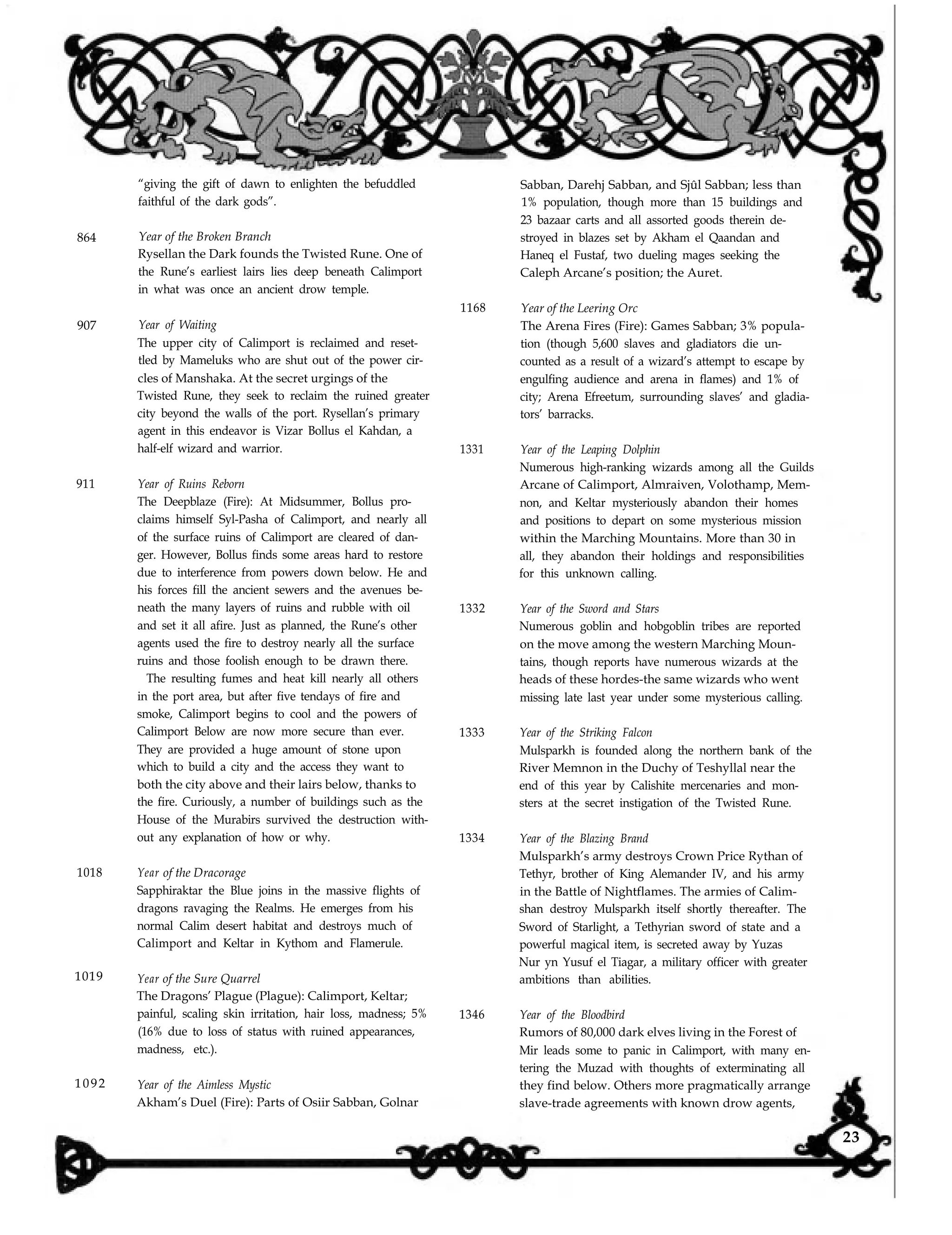
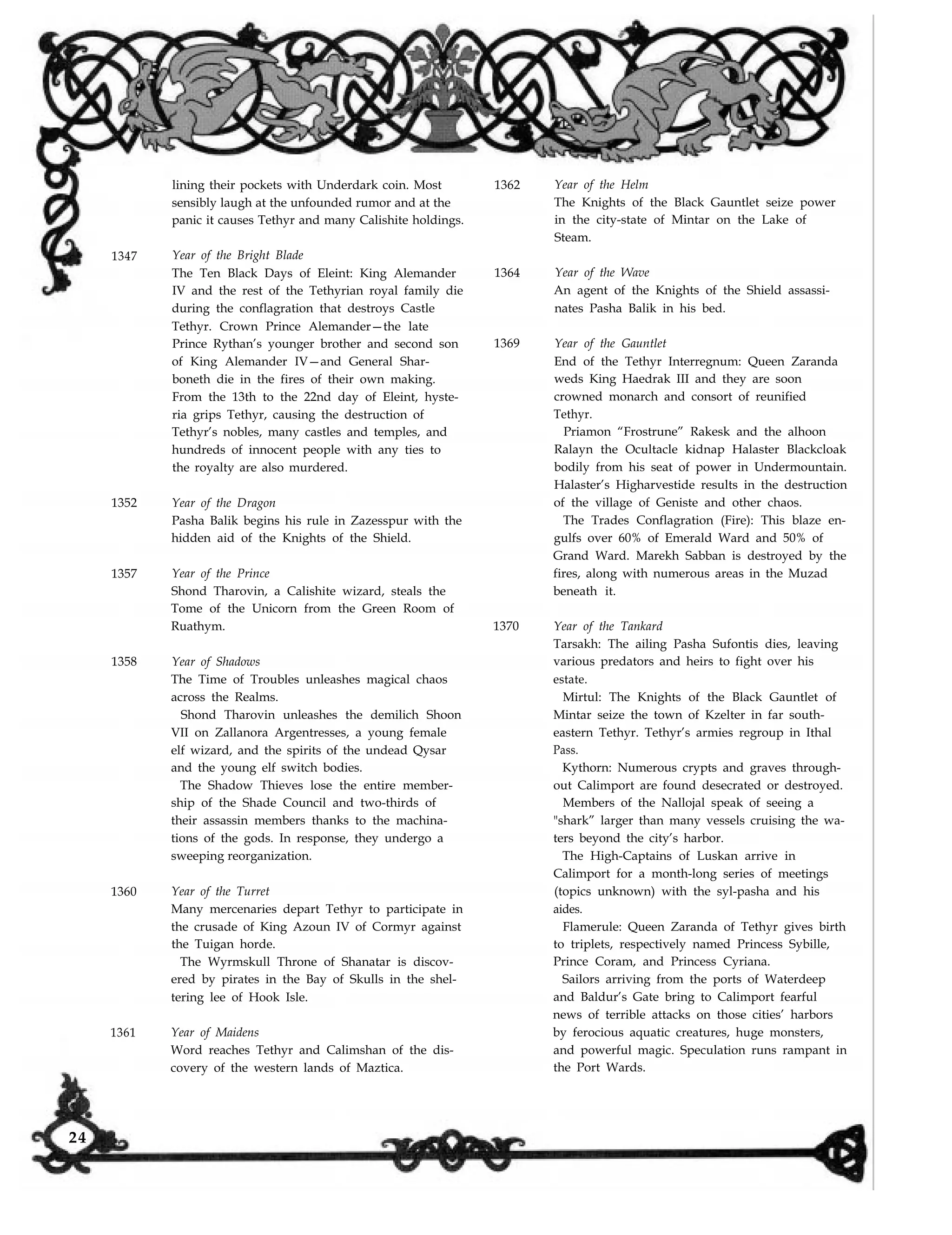
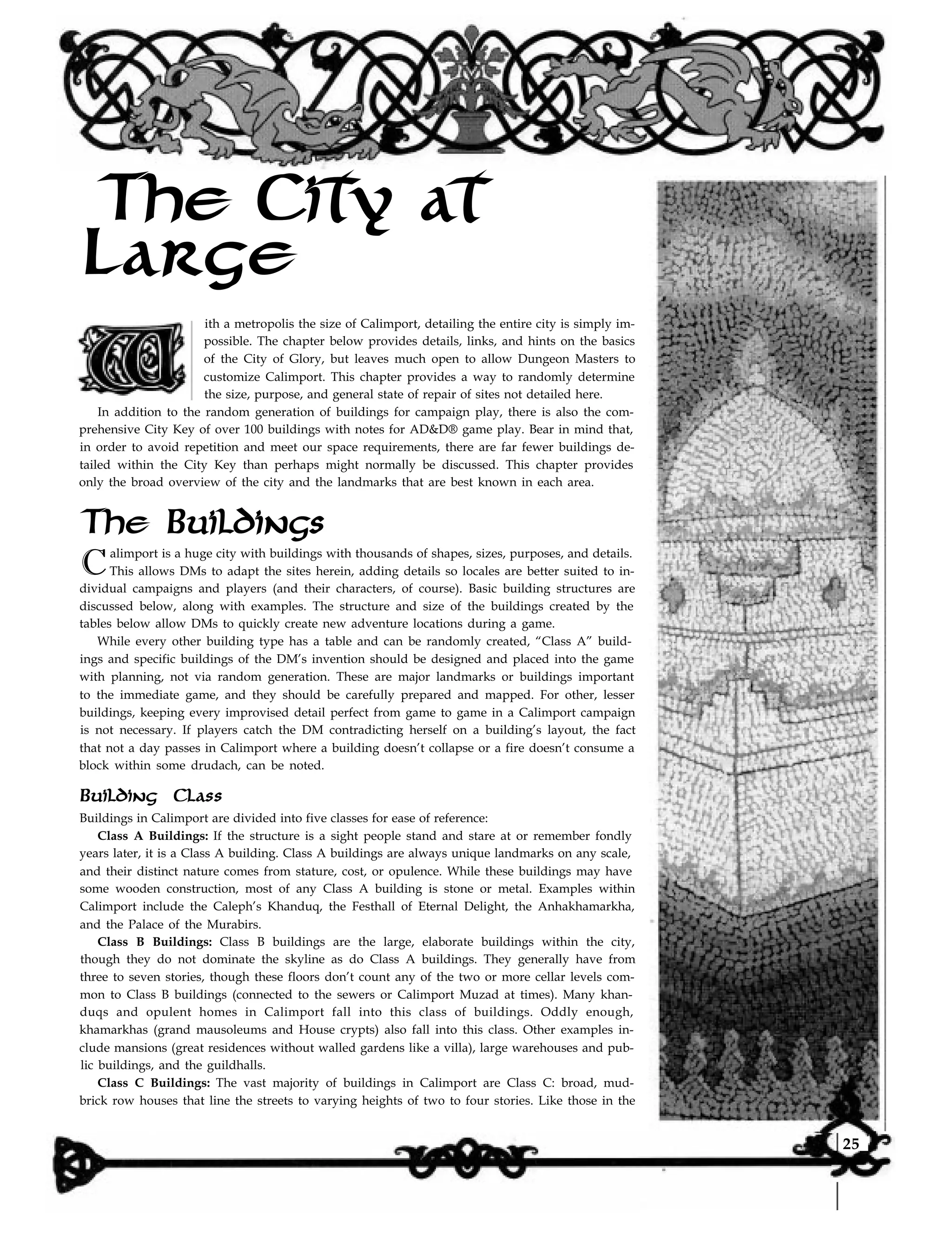
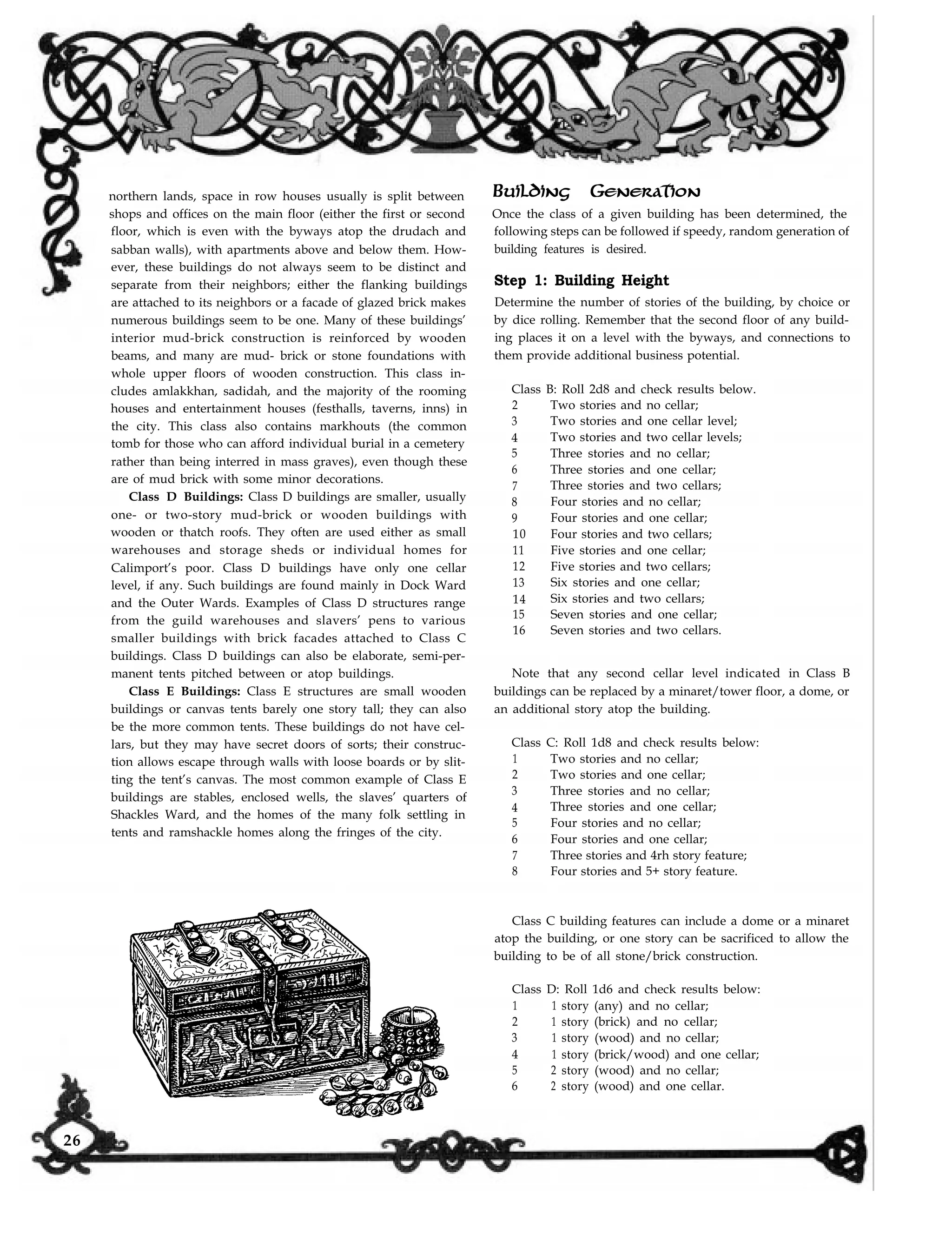
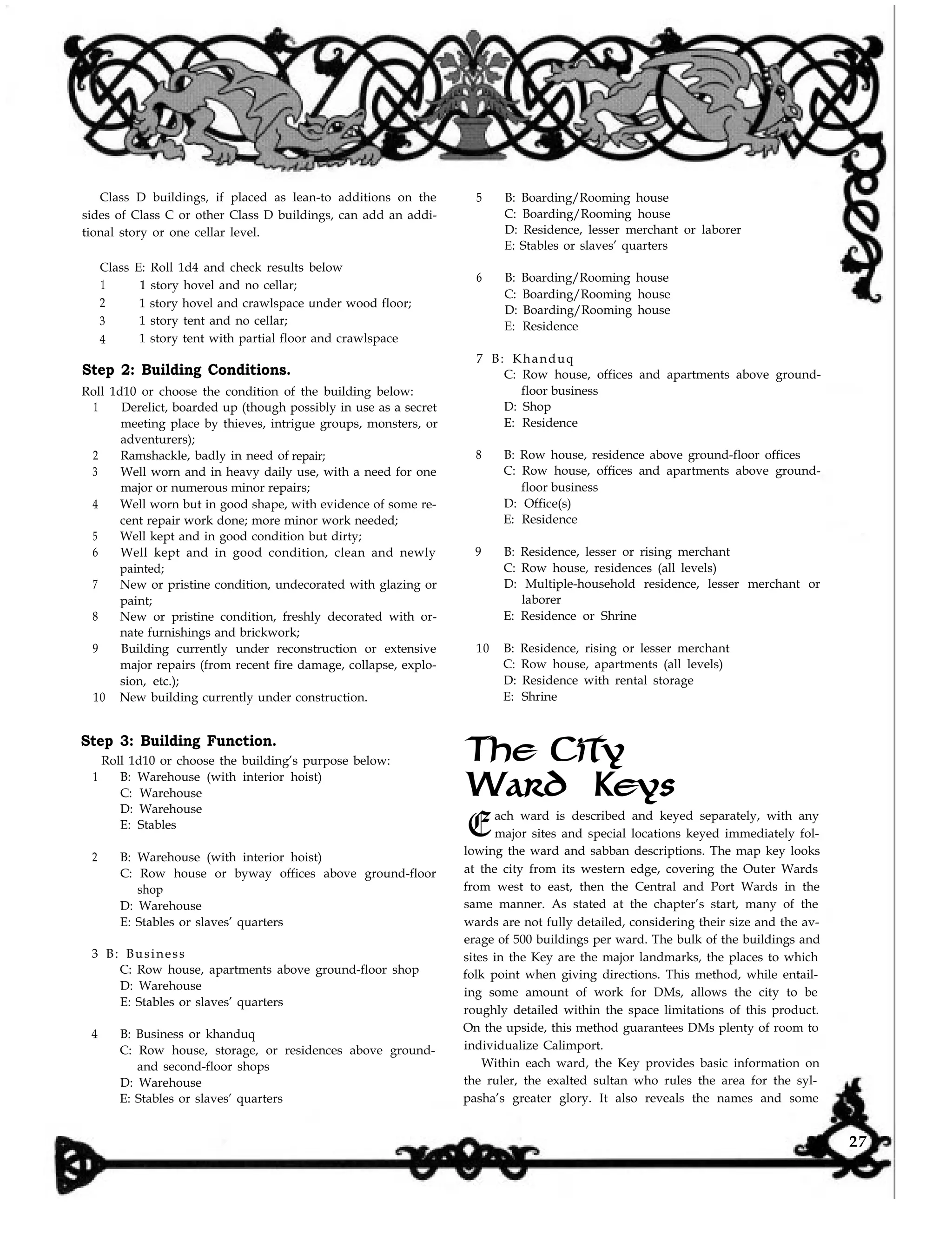
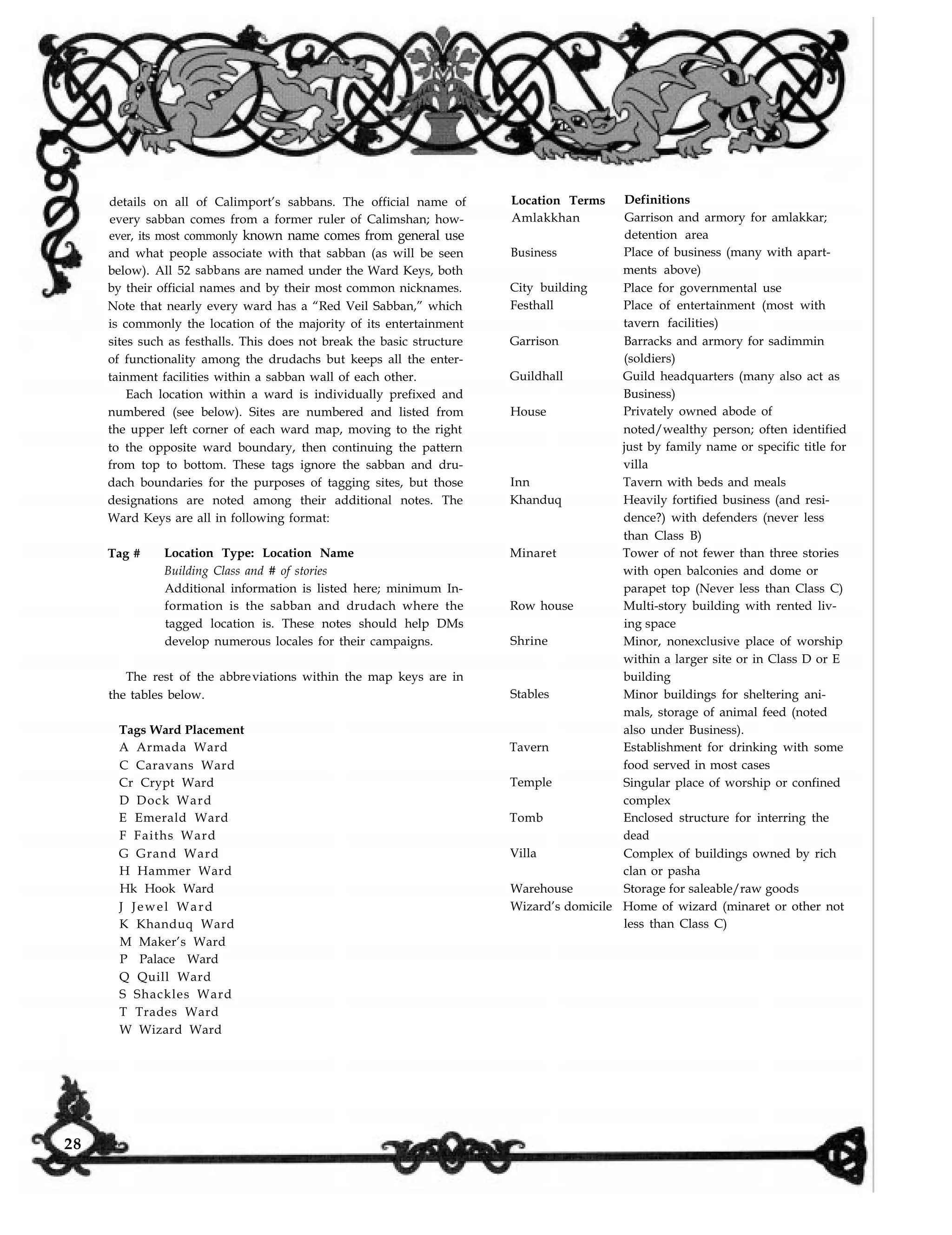
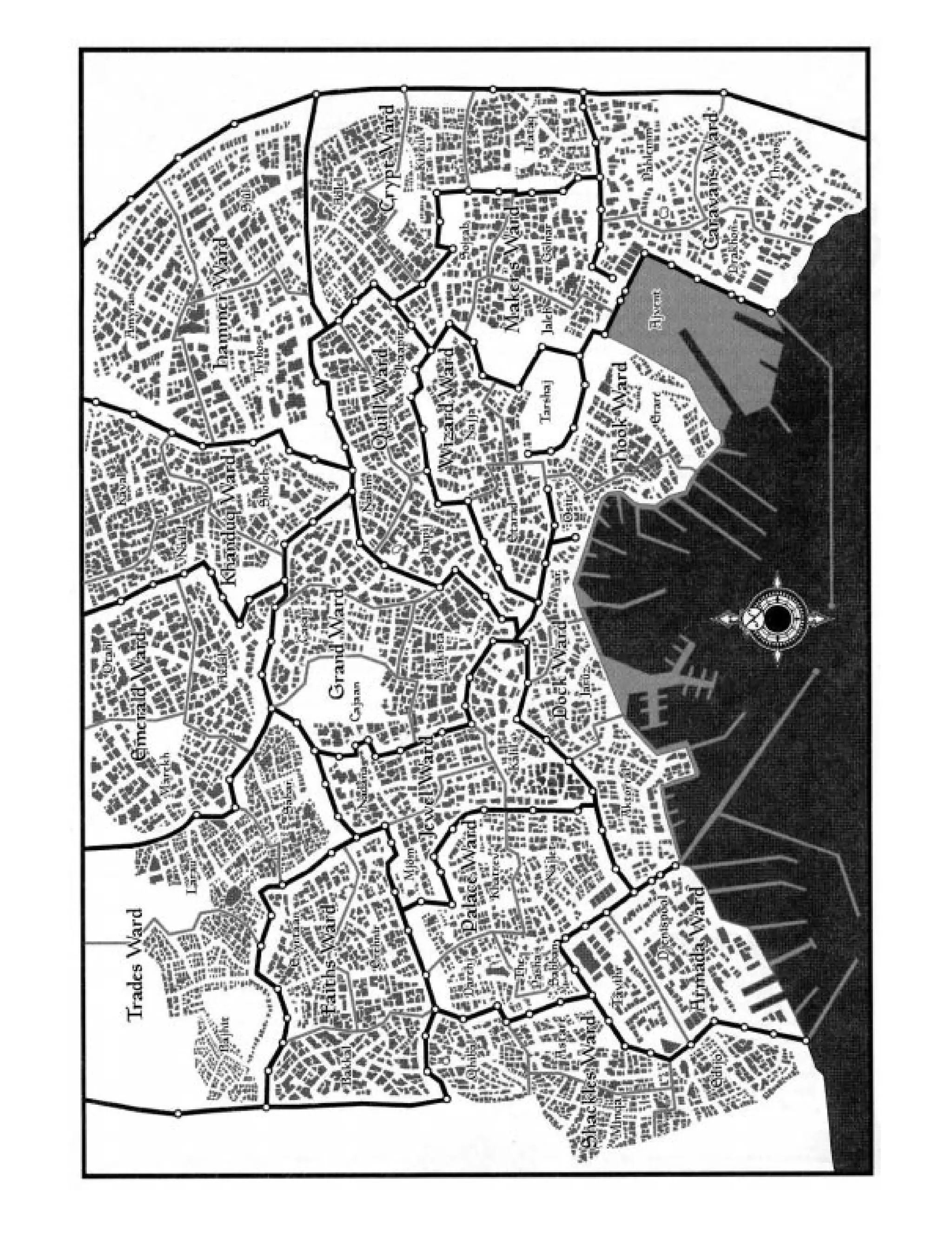
![The Elder Wall
Remnants
Much of the outer city lies unprotected by city walls, as
the City of Glory has not been surrounded fully by a
defensive wall-and-gate system in more than three centuries.
As the city constantly expands, what little has not fallen
from the previous outer walls has been claimed by the build-
ings that once built against the walls for stability. The walls
of numerous buildings in the Outer Wards contain secret
chambers even their buildings’ owners know nothing of.
Buildings made from the Elder Walls are easily spotted: the
brickwork of the wall is more massive than standards or
building size demands.
There are yet a few free-standing elements from the Elder
Walls that fell late in the Seventh Age. The walls were
pierced in three places on the northwestern, northern, and
eastern sides of the city. The Malikhan Gates of Trades Ward
still stand, though their entrances have long since been
blocked, and they stand today as grand decoration for the
travelers entering Calimport on the Trade Way. The
Zhamush Gate still acts as a gateway to the city and the
sadimmin of Khanduq Ward use it as a garrison and staging
post for their drills. The last of the Great Gates (built by the
short-lived Jhaapir Dynasty of the Eighth Age) partially col-
lapsed during Akham’s Duel (1092 DR) and was never re-
built. In the 278 years since, the crumbled Sayad Gate was
looted for its stone, but it was never fully cleared away. Today,
Sayad Hill is the prominent hill within Pahlemm Sabban in
the Caravans Ward, long smoothed and shaped by the ele-
ments and some small magic into a 30-foot-high plateau
above the rest of the sabban. From its top, many drovers and
trading caster organizers oversee their caravans down in the
courtyards and staging areas surrounding the base of the hill.
The last marks that note the former existence of the Elder
Walls are the plinths. They mark the former path of the dru-
dach/sabban walls, though tents and rough hovels have sur-
rounded them as the city expands. As the plinths are often
used as hitching posts for mounts and other such common
tasks, the sabban marks are worn off all the plinths.
Shackles Ward
[Outer Ward] This ward encompasses the western edge of the
city and is the traditional home of much of Calimport’s slave
(and slaver) populations. The entire eastern length of Shackles
Ward, where it abuts Armada and Palace Wards, remains in
shadow beneath the looming Pesarkhal Wall being built to pro-
tect the city center. While certainly the poorest sector of the
One of the strangest features of Shackles Ward is its lack
of drudach walls. While the three sabbans remain distinct,
there are no divisions among them internally. Over the cen-
turies, the older drudach walls were scavenged until their
walls had been put to use reinforcing the sabban walls and
building massive sales platforms even with the byways.
Ward Ruler: Harun yn Ralan el Pesarkhal, Sultan of
Shackles Ward (NE hm T5) is the ill-tempered seventh child
(fourth son) of the syl-pasha and is Pasha of the Slavemas-
ters’ Circle in his own right. His primary vizar and wizard-
ally, Kamal el Estarq (CE hm M7), is an agent (and lover) of
Tamol yr Pirit (LE hf C4 of Shar), who directs them both for
the Twisted Rune. While both men are smart enough to real-
ize they are being manipulated by this freelance jhasina from
the Muzad, both realize she has other allies whose power they
covet and welcome for their own power plays. Neither is far-
sighted enough to realize that such power comes with a price.
Astaré Sabban
Other names: Slaver Sabban, “the Flesh Market.”
This sabban is the primary staging area for newly arrived
slaves coming up for sale. Of its four former drudachs, its cen-
tral one was long a mere composting and rubbish heap that
was eventually filled in with mud. Thus, there is a large central
market in Astaré Sabban even (at least visually) with the sab-
ban byways, and pashas and the mercantile class can purchase
slaves without having to lowering themselves to ground level.
The bulk of the sabban’s streets are filled by one- or two-room
tents and hovels, wherein hundreds of thousands of slaves live.
Sabban mark: A hand with a shackle and length of chain.
Edijo Sabban
(and burned to the ground).
Sabban mark: Two eyes, each with single tears beneath.
and poor as well as the secondary housing area for slaves.
This sabban looks out from atop a 30-foot-high cliff next to
the Armada Ward, and its isolation on the coast restricts
other city residents’ exposure to the illnesses rampant here.
Of course, when plagues begin, this is the first sabban blamed
Other names: Penitents’ Sabban.
This sabban is the housing sabban for the destitute, sick,
Minqa Sabban
Other names: Sadimmin Sabban
This sabban, the westernmost area of the ward and of
Calimport itself, is hardly a sabban as much as a military out-
post. The military training grounds and garrisons here at least
hint to the slaves of this ward that even without chains, they
will not be allowed to flee from the city. This is the post for
raw recruits and aging soldiers, while others of the sadimmin
are stationed among the other city garrisons or elsewhere
across Calimshan.
city, it is far from the most dangerous area to frequent. After all,
there are few thieves here since there is very little to plunder.
30](https://image.slidesharecdn.com/dd3-150414105156-conversion-gate01/75/D-D-3-5-calimport-31-2048.jpg)
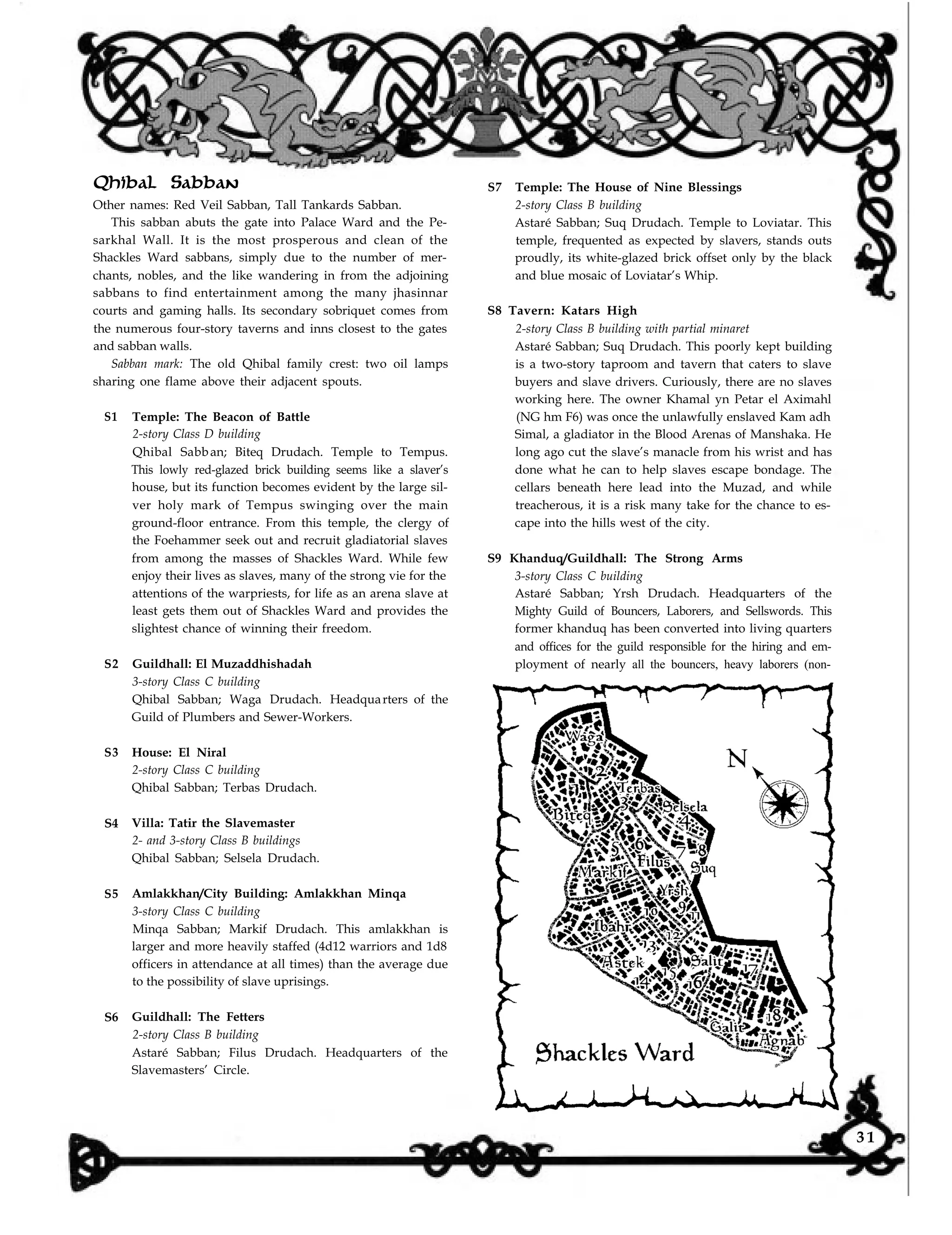
![dock work), and mercenaries in the city. Pasha Kadan el
Vyndahla (CE hm T9) has effectively merged this legiti-
mate guild with his less-than-ethical enforcers and protec-
tion rackets, though he carefully maintains the distinc-
tions, so he can remain “a legitimate business man who
provides a strong arm where needed.”
S10 Villa: Dome of the Balak
2- and 3-story Class B buildings
Minqa Sabban; Ibahr Drudach. This three-building
domed villa is reserved for the older balak (colonel) in
charge of training army recruits. This military leader
also becomes the de facto sabbalad.
S11 Amlakkhan/City Building: Amlakkhan Edijo
3-story Class C building
Astaré Sabban; Yrsh Drudach. This amlakkhan is larger
and more heavily staffed (4d12 warriors and 1d8 officers
in attendance at all times) due to the dangers inherent
in slave uprisings.
S12 Garrison: Garrison Katar
3-story Class B building
Minqa Sabban; Ibahr Drudach. This garrison is filled
with recruits who show enough promise to earn the
training for commissions in the Farisan, the elite troops
of Calimshan or the syl-pasha’s guardians, the
Qysaghanni.
S 13 Garrison: Ninth Scimitar Garrison
3-story Class C building
Minqa Sabban; Astek Drudach.
S14 House: Giidaradah
2-story Class B building
Minqa Sabban; Astek Drudach. This house is reserved
for the use of the Minqa Sabban’s second-in-command,
most often a shyk (major).
S15 Garrison: Fourth Scimitar Garrison
3-story Class C building
Minqa Sabban; Astek Drudach.
S 16 Business/Stables: Rôghiian Stables
1 -story Class E building
Edijo Sabban; Salit Drudach.
S 18 Khanduq: The Adhavensarai
2-story Class D building
Edijo Sabban; Agnab Drudach. This former khanduq
and surrounding bazaar stalls attached to its outer walls
is one of the few markets where indentured servants and
slaves can buy food, clothing, and other materials with
any meager coins they can scrounge. The products for
sale are substandard for any other market in Faerûn, but
they still count as luxuries for the downtrodden.
Faiths Ward
[Outer Ward] Many of Calimport’s oldest temples lie
within this ward, thus its name. In fact, while most of the city
has been destroyed in past centuries, this area has retained
most of its structure and architecture for more than 1,000
years. It has not been untouched by fires, plagues, or the con-
stant street battles of both guilds and criminals, yet the build-
ings take strength from their devoted inhabitants and remain
standing, though streaked with the soot and grime of cen-
turies (unless cleaned each day, as some temples are).
Ward Ruler: Uarel yn Petal el Waukeen, Sultan of Faith
Ward (N hm P11 of Waukeen) is a remote, distant man save
when he is performing his religion’s ceremonies. His duties as
Sultan, Master of the Counting House, and Pasha of the
Guild of Money Lenders, Coinsmiths, and Pawn Brokers do
not interfere with his ecclesiastical duties, though his consid-
erable financial and spiritual influence has always been
threatened by the rival church of Waukeen, the Khanduq of
the Coinmother (K1), and his former assistant, Druzir Petal
el Saiduwm.
Bakkal Sabban
Other names: High-Priests’ Sabban.
One of the few sabbans not named directly for a ruling dy-
nasty, its name was the title of the priest-rulers of Coramshan
and First-Age Calimshan. The hallmarks of this sabban,
other than both its ancient and modern temples, are the nu-
merous statues that dot the streets and rooftops.
Sabban mark: Generic face with a coiled serpent crown
atop its head (the ancient crown of the bakkals).
Erehnir Sabban
Other names: The Statue Sabban.
There is no sabban mark for Erehnir Sabban, simply be-
cause the inner-facing walls of the sabban are so distinctive.
Similar to the Eight Erehnirs looming along the approach to
Volothamp, the brick walls of this sabban were either molded
or carved to have many statues along the sabban walls. Most
are merely stoic priest-kings, but some are posed with weap-
ons and opponents. While the roll of time has worn much of
the detail away, the rough outlines of all figures are still
S 17 Temple: House of the Bound Hands
2-story Class C building with a 3-story minaret
Edijo Sabban; Galit Drudach. Temple to Ilmater.
32](https://image.slidesharecdn.com/dd3-150414105156-conversion-gate01/75/D-D-3-5-calimport-33-2048.jpg)
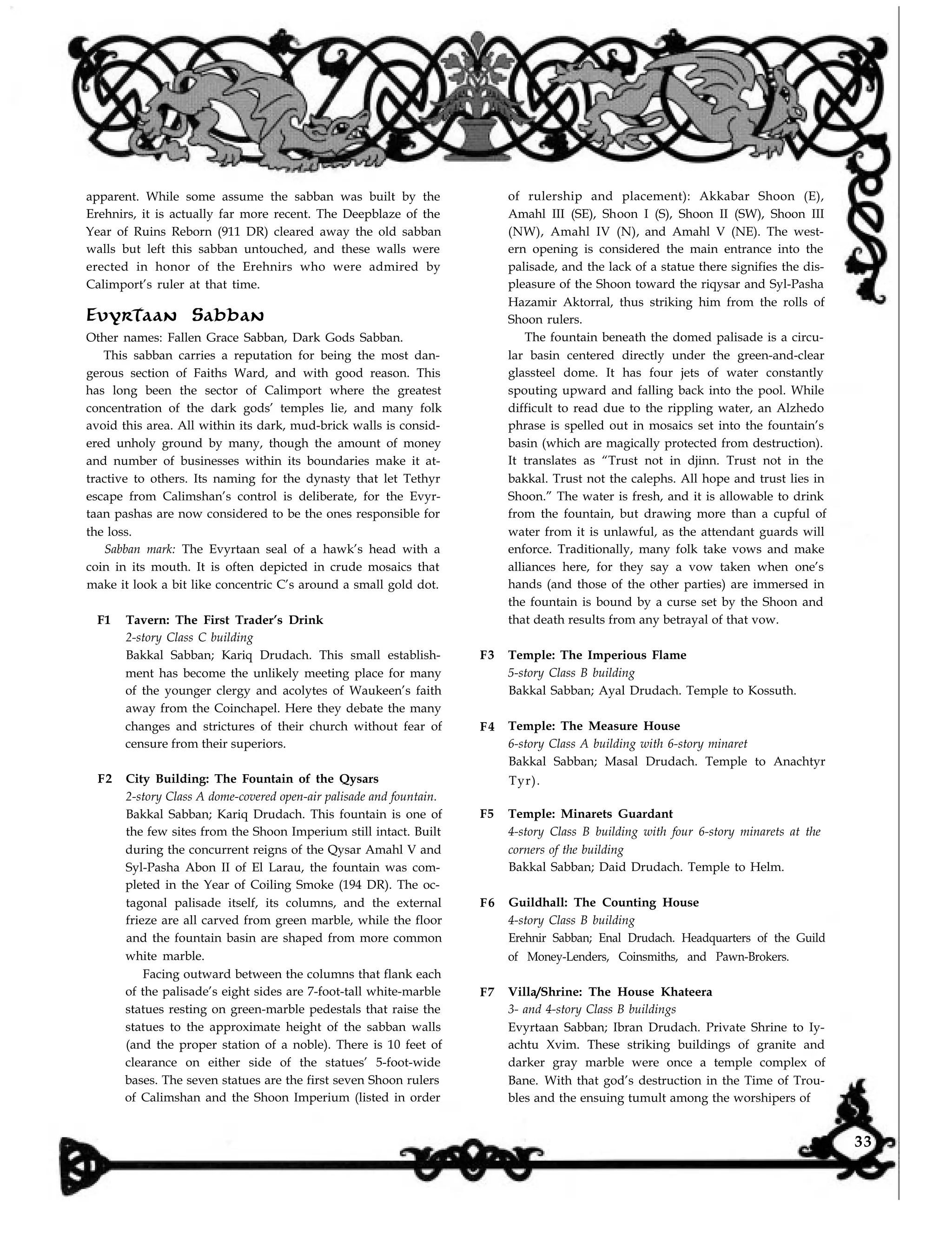
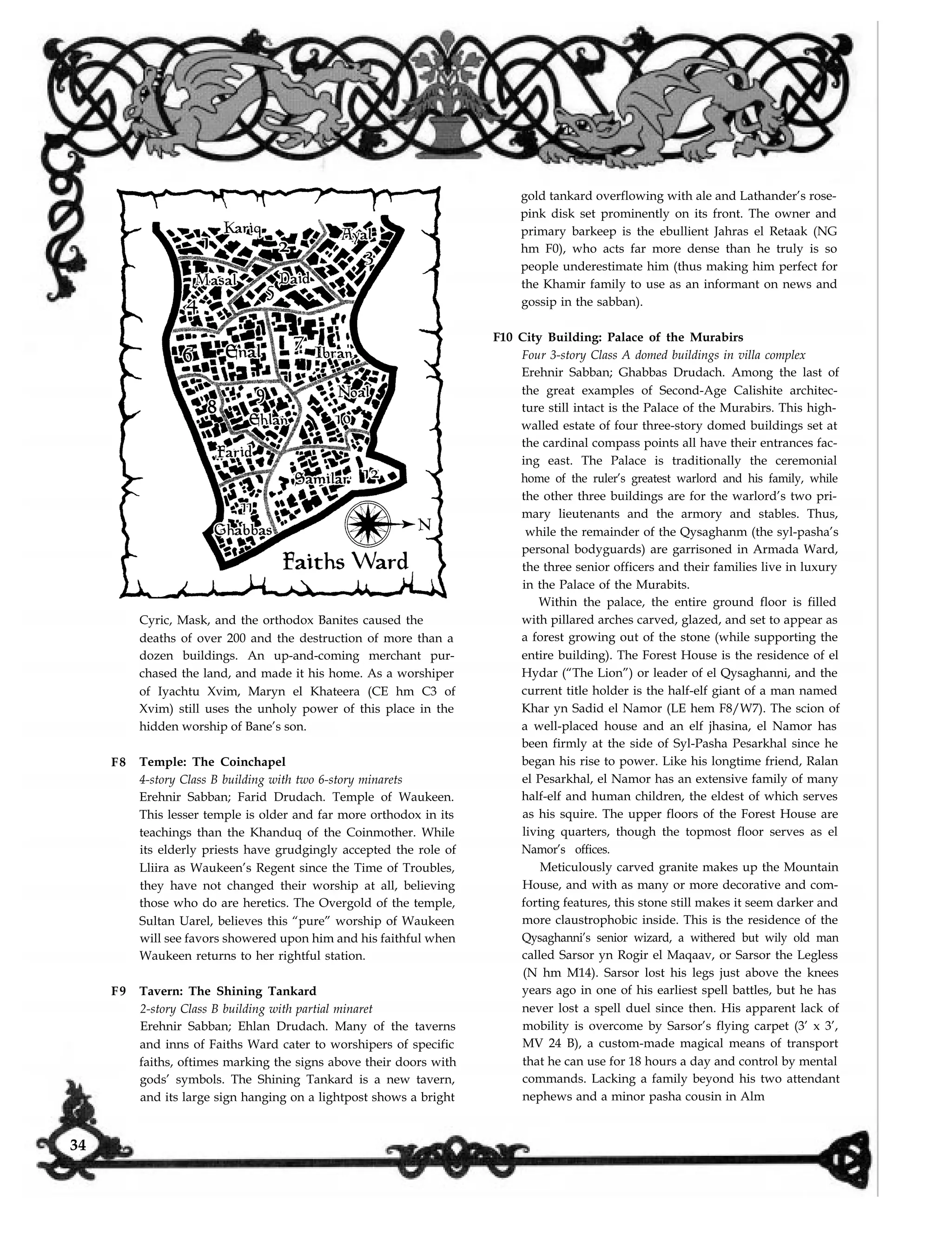
![raiven, Sarsor acts as the primary commander of the
Qysaghanni wizards and their primary tutor in spell-
battle tactics.
The Ysrnadah is a bright building of white marble on
its outer facade and steps, ivory tiles on the roof, and
carved-ivory screens in the open windows. Inside,
nearly all other surfaces are decorated with mosaics of
lapis lazuli and turquoise, while floors and walls are
made of blue marble. It will be the home of the leading
qayadin of the Qysaghanni beneath el Namor, but the
position is currently vacant due to the recent assassina-
tion of Rayan el Hadhil, the former qayadin. At pre-
sent, there are no fewer than seven people vying for the
promotion to the post, and el Namor is simply biding
his time, allowing them to eliminate each other and see
just how ruthless they are in pursuit of their goals.
The final building within the Palace of the Murabirs
is known as the Spear House. This was once the Jhasina
House but is now an armory for many of the most pow-
erful magical weapons for the Qysaghanni’s use in its
protection of the syl-pasha.
F11 Temple: Aurensahldah
3- and 4-story Class A buildings
Evyrtaan Sabban; Noal Drudach. Temple to Lliira and
Chauntea. The larger of the two temple buildings is
more than 300 years old, and the 3-foot-diameter
brightly polished gold coin of Waukeen stamped into
the wall above the entrance flashes brilliantly when the
rising sun hits it. The senior priest of Aurensahdah is
Pasha Uarel yn Petal el Waukeen, and his orthodox ap-
proach to Waukeen’s faith bade him build the adjoining
new temple with his son after the Time of Troubles. The
lesser temple is dedicated to Lliira, whose Regency of
Waukeen’s faithful for the past 13 years has been hon-
ored by many of the clergy. Uarel’s son Rahim yn Uarel
el Lliira (NG hm P6 of Lliira) was raised in Waukeen’s
church and would have become an acolyte and priest of
the Coinmother, until Lliira’s assumption of Waukeen’s
divine duties. Rahim is as hedonistic as his father is re-
served, but the two of them complement each other,
and the two temples act in accord despite any reasons to
the contrary.
F12 Temple: The Towers of Fury
Four 4- and 5-story Class B buildings
Evyrtaan Sabban; Samilar Drudach. Temple complex to
Auril, Malar, Talos, and Umberlee. After centuries of
attempting to appease the Gods of Fury and centuries
more of their temples all being destroyed in fits of godly
(or more mortal) pique, Syl-Pasha Djenispool had this
temple constructed in the Year of the Worm ( 1356 DR).
While its attendant priests bridled over having to share
holy ground with other faiths, the alliances among the
Gods of Fury (and the risks involved with directly de-
stroying another god’s temple and faithful in such close
proximity to one’s own temple) keep this temple com-
plex standing behind a curtain wall built off the Samilar
Drudach wall.
Trades Ward
[Outer Ward] As its name states, this ward is the elder
mercantile ward and still the primary area in terms of trade
with the northern shanates (outlying estate farms), since the
Trade Road enters the city directly into this area. The ward
attracts many visitors with the colloquially known Golden
Sands and Games Sabbans. It is also the ward with the high-
est concentration of taverns outside of the Port Wards.
Ward Ruler: The twelfth son of the syl-pasha, Faruk yn
Ralan el Pesarkhal, Sultan of Trades Ward (LE hm C4 of
Shar; Int 17) stands apart from his brothers due to his aston-
ishing rise to power. A mere 18 years of age, Faruk has already
conquered two guilds, a large part of the illicit trade in the
Muzad, and sits as the sultan of one of the more profitable (if
not prestigious) wards of the city. His father notes his son’s
abilities with pride, and he often pits this prodigy in courtly
battles of wits against his other sons to shame them into more
activity and loyalty. Faruk does not seek the syl-pasha’s
throne, but he does harbor some ambition of leading the
Temple of Old Night, of which he is an acolyte, to conquer
the Muzad.
Bajhit Sabban
Other names: The Tent Sabban.
The northern outskirts of the ward are Bajhit Sabban, a
disorganized cluster of tents and bazaars that surround the
still-standing Malikhan Gates. The sabban also dominates
the areas west of the Trade Way in this ward. Those entering
the city here get the impression of a slovenly, chaotic city
that does not protect its people. However, the infrastructure
of the sabban walls and amlakkhans keep the peace among
the poor (and the many pickpockets that swarm any foolish
enough to travel at ground level more than 30 yards away
from the Grand Gate). There are a number of other brick
buildings within this sabban, but their numbers are minimal
compared to the tents of the poor.
Sabban mark: Four slashes in the crude shape of a tent.
Larau Sabban
Other names: Games Sabban, Arena Sabban
The Larau were among the largest supporters of the Djen
Arenas during their rule as syl-pashas under the Shoon
Qysars. While there are the usual peripheral businesses and
35](https://image.slidesharecdn.com/dd3-150414105156-conversion-gate01/75/D-D-3-5-calimport-36-2048.jpg)

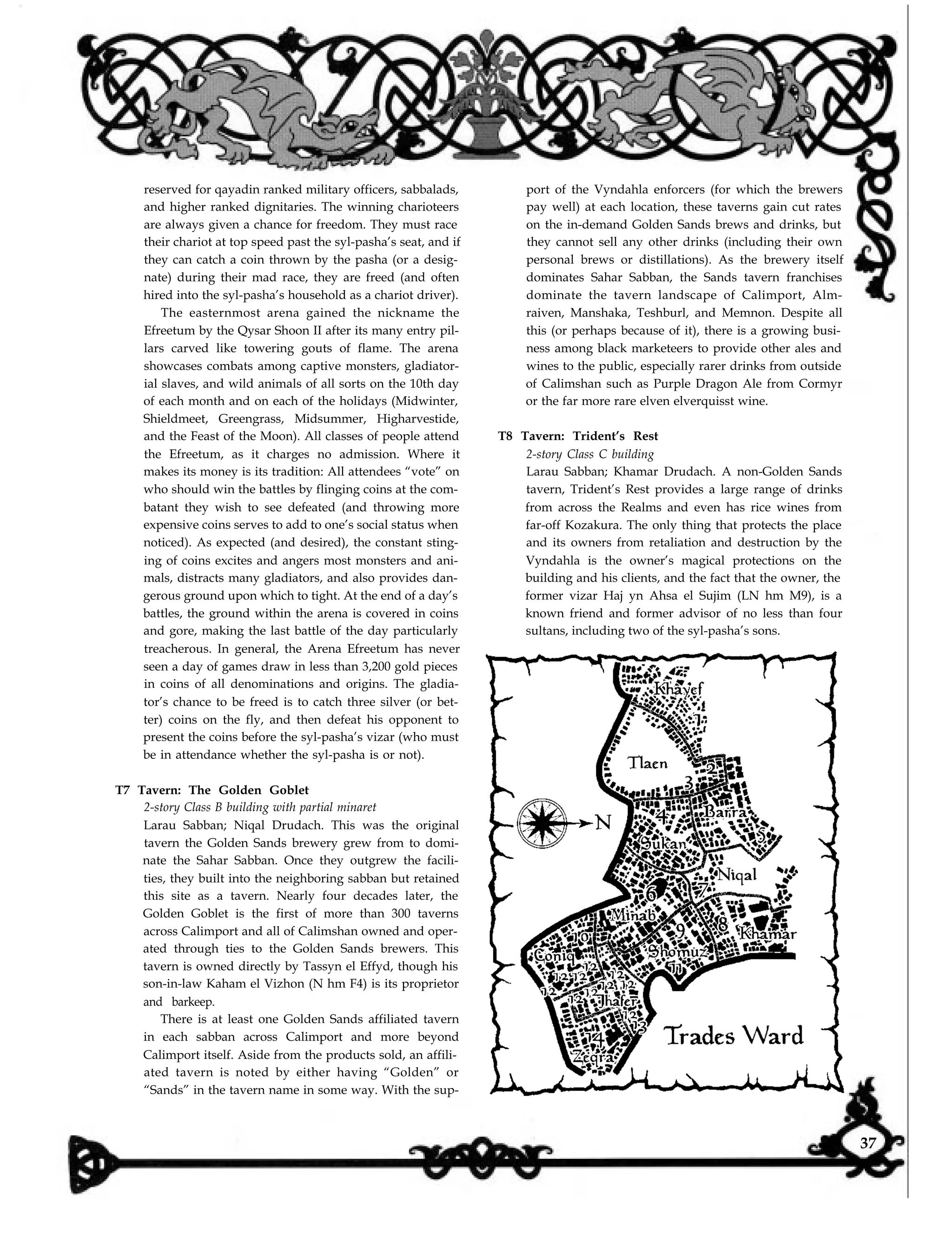
![T9 Temple: The Arms House
3- and 4-story Class B buildings
Larau Sabban; Shomuz Drudach. Temple to Tempus.
Located near the Djen Arenas, the Arms House is a sec-
ondary barracks of a sort for the gladiators. Those who
seem unlikely to escape yet are favored by Arena crowds
live here, training with the priests of Tempus. There is
an underground tunnel made from a long-forgotten
sewer line that leads directly into the staging areas for
the gladiators, allowing the fighting slaves the freedom
to move from the complex outside into the arena with-
out their masters’ fears of their investments fleeing once
they leave the Arms House.
heavily guarded buildings among them all here.
T13 Business/Stables: The Chawal’s Bridle
1 -story Class E building.
Sahar Sabban; Jhafer Drudach.
T14 Guildhall: The Shanates’ Bounty
4-story Class B building
Sahar Sabban; Zeqra Drudach. Headquarters of the
Grocers’ and Farmers’ Guild.
Emerald Ward
T 10 Guildhall: Sunned Barley Villa
1- and 4-story Class B buildings
Sahar Sabban; Coniq Drudach. Headquarters of the
Vintners’, Distillers’, and Brewers’ Guild. The main
building that fronts on the Sahar Sabban wall is the pri-
mary guildhouse, where business is conducted. The lat-
ter two buildings within the Sunned Barley villa have
single levels above ground but have two cellar levels
each. These are the distilling and brewing buildings,
with wine and ales respectively brewing in separate long
cellars where temperatures are cooler. The drinks made
here are for internal guild consumption only, and they
are the only brewing facilities in this sabban that are
not of the Golden Sands brewery and distillery.
Joining the guild is not difficult, but remaining in the
guild without becoming part of the Golden Sands brew-
ers or distillers is nearly impossible. Many of those who
attempted to reap the benefits of guild membership
without turning over all recipes and brewing secrets to
them ended up dead. While not mandatory, one’s tav-
ern business does remarkably better if one is a member
of this guild and the Entertaining Society of Taverners.
[Outer Ward] One of the first signs of opulence in the city
when approached from the northern trade road, Emerald
Ward is a home for the many rising mercantile powers in the
Outer Wards of the city. An address here indicates one’s for-
tunes are on the rise and on the verge of reaching the pinna-
cle of the lesser classes. This ward is worlds apart from the
dirt and despair found in Trade Ward’s outer sabbans, as this
area was hardest hit in the last fires and disasters. Thus,
nearly everything in Emerald Ward is newer, cleaner, and
more opulent. This has made it the home of choice for much
of Calimport’s “new money,” and the social oneupsmanship
of the rising villas and businesses is blinding in the overabun-
dance of brightly colored tiles and paints. Still, the recent
renovations allowed the expansions of some older bazaars
into the more wide-open marketplaces indigenous to north-
ern cities.
Ward Ruler: Nasim yn Nasim el Pesarkhal, Sultan of
Emerald Ward (CN hm F0) is the favored nephew of the syl-
pasha by his youngest brother Nasim. The strikingly hand-
some young man is as brilliant as the prodigy Faruk of Trades
Ward, though his tastes remain close to business, not the in-
trigues of Calimport Below. Loyal to the syl-pasha to a fault,
Nasim the Younger’s only failing is his weakness for gambling
(which has some of the criminal powers lining up to become
his creditors and gain them some leverage among the shining
spires of Emerald Ward).
Axash Sabban
Other names: Cloth Sabban, Sash Sabban.
This sabban is a constantly busy area and it is the largest
market area for clothing, from the most common to the most
expensive. Still, with all the business within this sabban,
many tailors and clothing sellers pack up their wares and
travel personally into Grand or Palace Ward to bring their
best wares directly to the pashas and sultans.
Sabban mark: Three parallel waving lines that represent
sashes.
Marekh Sabban
Other names: The Great Bazaar Sabban, Black Sabban.aging of their drinks, and these are among the most
T12 Business: The Golden Sands Brewery
Nine 3- and 4-story Class B buildings
Sahar Sabban; Coniq and Jhafer Drudachs (“Golden
Sands” Drudachs). These many brewing, preparatory,
and distilling buildings produce more ale, beer, and
wine than any single producer in Faerûn. Distilling and
other preparations are done in cellars below ground,
where the cooler temperatures allow them to create
their bubbly lagers that they ship northward through
Aurora’s Wholesalers. Magical transport is the only way
the product can survive a journey of more than a tenday
if sent via mundane means. The brewery also has ware-
houses within this complex of buildings for storage and
38](https://image.slidesharecdn.com/dd3-150414105156-conversion-gate01/75/D-D-3-5-calimport-39-2048.jpg)
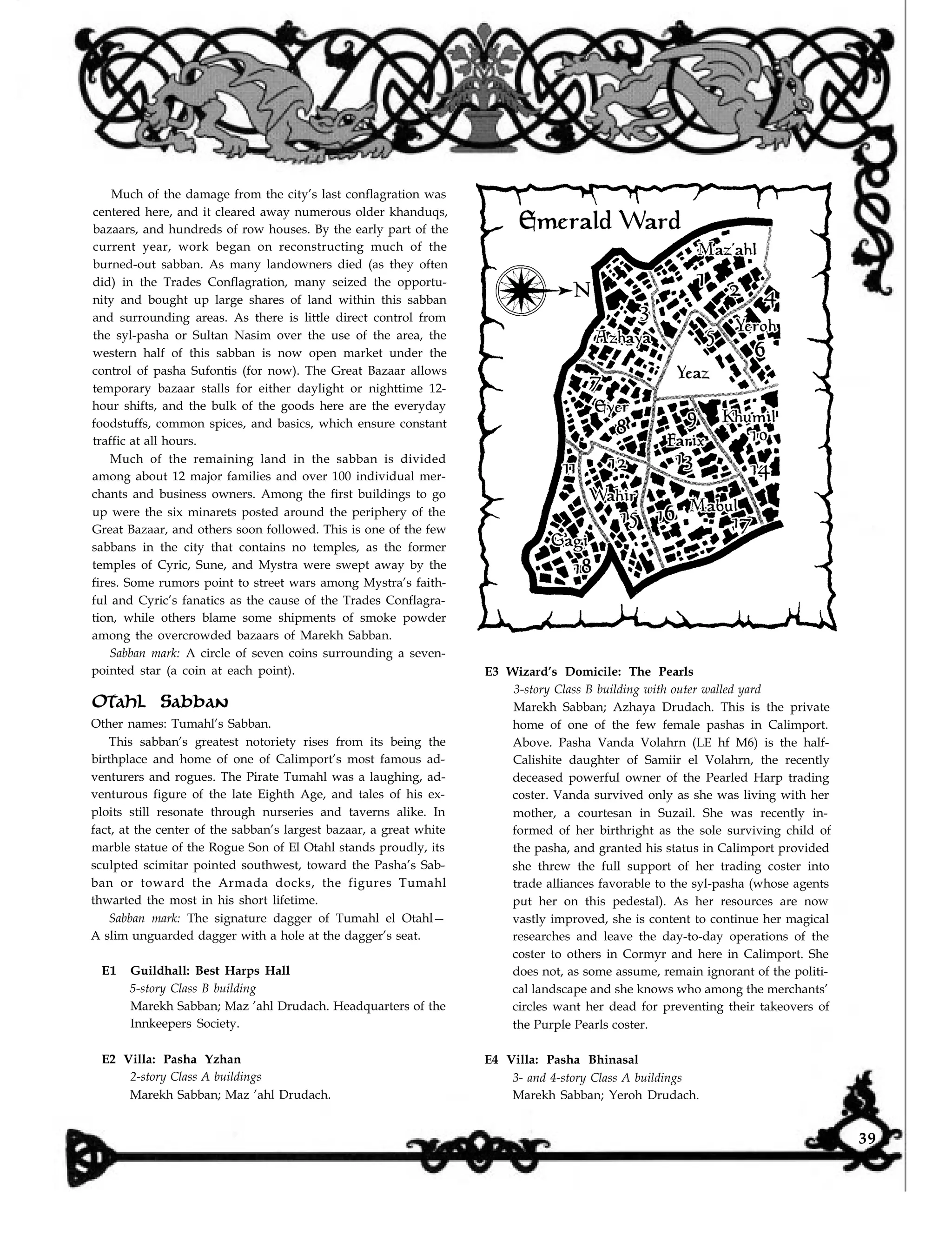
![E5 Villa: Pasha Akhadar
3- and 4- story Class A buildings
Marekh Sabban; Yeaz Drudach
E6 Villa: Pasha Yekhol
and under the ground. The First Trader created the first
slippers so the dao could appear as prosperous as the
other genies. Thus, shoes and slippers are seen as social
climbing tools more than practical footwear (though
both have developed).
E13 Temple: The Halls of Fortune
Two 5-story Class A buildings
Otahl Sabban; Farix Drudach. Temple to Tymora.
E 14 Villa: Pasha Baalaed
2- and 4-story Class A buildings
Otahl Sabban; Khumil Drudach.
E 15 Villa: Pasha Rasûla
2- and 4-story Class A buildings
Axash Sabban; Wahir Drudach.
E16 Villa: Pasha Sha’al
2-story Class A buildings
Otahl Sabban; Mabul Drudach.
E 17 Villa: Pasha Awadabh
3- and 4-story Class A buildings
Otahl Sabban; Mabul Drudach.
E18 Festhall: The Sultry Siren
4-story Class B building
Axash Sabban; Gagi Drudach. This opulent festhall has
such a reputation as the primary festhall under the com-
plete control of the Jhasinnar Sodality that few look any
further than its most obvious services. This serves the
guild and its pasha well, for Ralahn el Matyr (LN hm
F0) uses this as a front for fielding black market goods,
especially stolen jewelry. The cellars have secret links to
the Muzad, and many a pasha and sultan owes Ralahn
and his jhasinnar their lives (or at least political reputa-
tions) by using these secret tunnels to escape traps set
by rival houses and pashas. Ralahn is a quiet and con-
templative guildmaster, and he has yet to use any favors
beyond those needed to repair this building within a
month after the Conflagration.
2-story Class A buildings
Marekh Sabban: Yeroh Drudach.
E7 Minaret: The Tower Sufontis
5-story Class B minaret
Axash Sabban; Eyer Drudach.
E8 Villa: Pasha Samarkhan
2- and 4-story Class A buildings
Otahl Sabban; Eyer Drudach.
E9 Guildhall: Seven Chalices Trading House
4-story Class B building
Otahl Sabban; Farix Drudach. Headquarters of the
Kindly Order of Silversmiths.
E 10 House: Schamazharkh
3-story Class B building with 4-story minaret.
Otahl Sabban; Khumil Drudach. Private dwelling of
Druzir Tulan el Galin (NE hm F4), a mover-and-shaker
within the Circle of Architects, Engineers, and Builders.
E11 House: Capridah
3-story Class B building with cellar crypt.
Axash Sabban; Gagi Drudach. Home of Khiber yn
Makal el Wisynn (LE hm/vampire F8), the night-time
head of the Great Bazaar’s minaret guards. A former
gladiatorial slave of Manshaka and mercenary for Su-
fontis for more than a decade, Khiber gained his posi-
tion slowly, but he has the trust of the old pasha (and
thus the enmity of his young wife and older sons). They
would trust him even less if they realized he had become
a vampire more than two years ago. A man of con-
trolled emotions, Khiber bides his time in respect for
the older Pasha, but his cold fury will soon be unleashed
against the petty scions of House Sufontis, and Khiber
plans on inheriting more than just continued control of
the house’s mercenaries.
Khanduq WardE12 Guildhall: The Dao’s Step
3-story C`lass C building
Axash Sabban; Wahir Drudach. Headquarters of the
Cobblers’ Society. This guildhall gains its name from a
children’s story about the first shoes created by the First
Trader of Calimshan. In essence, a powerful dao was
jealous of the opulence and cleanliness of the other ge-
[Outer Ward] This ward gained its name from its prepon-
derance of marketplaces and khanduqs, even though much of
the business and trade has moved further west into Emerald
Ward. This ward contains numerous sites of notoriety, in-
cluding the palace and villa of the infamous Pasha Pook, a
former guildmaster of thieves. As much of its western quarter
fell victim to the Trades Conflagration of 1369 DR, Naiidnies, since his feet were always muddy from walking on
40](https://image.slidesharecdn.com/dd3-150414105156-conversion-gate01/75/D-D-3-5-calimport-41-2048.jpg)
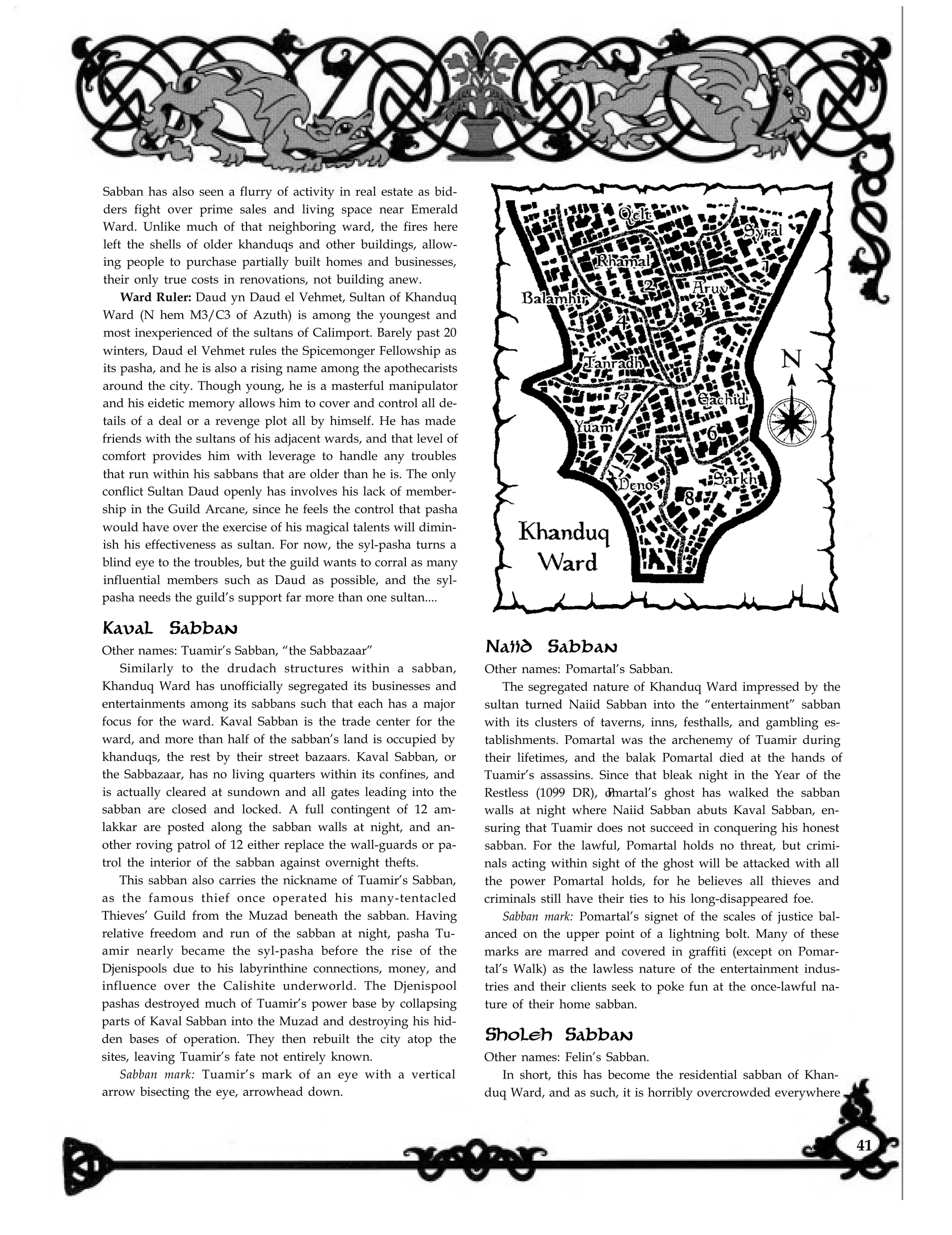
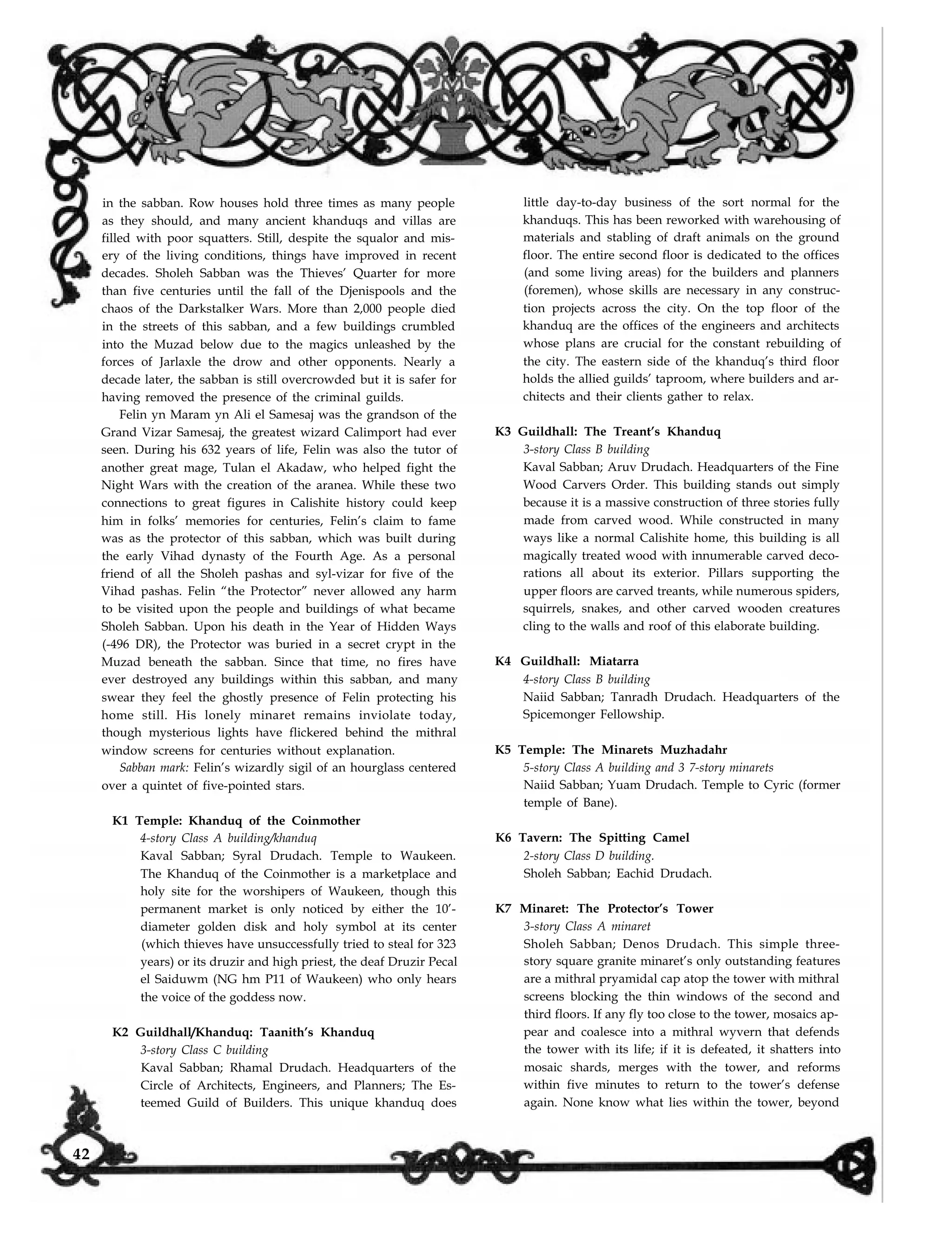
![Amyran Sabban
Other names: Hammer Sabban.
The rougher smithies and workshops of the common
blacksmiths dominate this sabban. While competition al-
ways runs fiercely, there is more than enough work in wheel-
mysterious lights visible through the screens, but folk say
that the lights are the Protector still watching over his sab-
ban. Many believe the tower is linked with Felin’s Lost Crypt
in the Muzad beneath the streets and expect great riches and
greater magic to be found in both. None have broached ei-
ther location ever, despite all effort.
K8 Villa: Pook’s Palace
3-story Class A building with 2 cellar levels
Sholeh Sabban; Sarkh Drudach. This once opulent
villa was both the home of the infamous Pasha Pook
and the Thieves’ Guildhall until the downfall of the
pasha in the Year of the Prince (1357 DR). Now
partly run down and no longer the seat of power for
any of the criminal families of Calimport, Pook’s
Palace is the home of the drunken and temperamental
Druzir of Rogues Drudach and Sabbalad of Sholeh
Sabban, Nur yn Aban el Esarn (CE hm T4). Druzir
Esarn was once a sneak-thief under Pasha Pook, and
he knows enough secrets to maintain his small level
of power but little more.
Hammer Ward
[Outer Ward] The “Smiths’ Home” is the ward for the
heavy labor of blacksmiths, armorers, weaponers, and the
like. The armorers and weapon-makers are all clustered
closer toward the heart of the city, so their wares can
quickly be used to defend the richer parts of the city
(rather than having their goods used against Calimport).
Everywhere throughout the daylight hours (and oft into
the night), the ringing of hammers on anvils fills the air of
the ward.
While the Pesarkhal Wall has not yet reached this ward’s
southern sabbans, the Skilled Smiths and Metalworkers
Guild has erected a fence of tall, barbed metal spears set
along the top of the sabban walls abutting Quill Ward to
mark its eventual placement. The spears do not restrict pas-
sage along the sabban wall byways, but they do prevent any
from vaulting across the walls into the Nasim Sabban.
Ward Ruler: Harel yn Rafam el Qardeen, Sultan of
Hammer Ward (NG hm F6; Str 17). This former black-
smith and inadvertent savior of Syl-Pasha Ralan el Pe-
sarkhal, Harel simply interrupted an assassination at-
tempt against Ralan during the Darkstalker Wars, throw-
ing red-hot horseshoes and sword blades at the assassins
simply because he disliked the odds of seven-against-one.
While he is happy with his position and succeeded far be-
yond his wildest dreams, Harel and his ringing hammer
can still be heard behind the walls of his villa working in
his personal smithy.
rims and horseshoes and the common metalwork to keep
over 50 blacksmiths’ forges blazing at all times. Surprisingly
to some visitors, Amyran Sabban is among the safest of sab-
bans to live in. Its natives are no-nonsense hard workers al-
most in defiance of the normal Calishite work ethic, and they
want to keep their homes and businesses clear of the corrup-
tion so rampant elsewhere.
Sabban mark: A smith’s claw hammer.
Sjûl Sabban
Other names: Anvil Sabban.
The Alzhedo word for anvil announcing its primary at-
tribute, Sjûl Sabban is the weaponsmiths’ sector of Hammer
Ward. In accordance with the True and Skilled Guild of
Weapon-Makers, all weaponsmiths of Calimport must meet
minimum standards of quality in their work, and they are
only allowed to sell two types of weapons per shop, prevent-
ing any one weaponsmith from totally dominating the mar-
ket. Thus, in this ward and mostly in this sabban, there are
more than 60 shops that sell swords, spears, scimitars, and
other weapons.
Sabban mark: An anvil on a circular field.
Tyrbos Sabban
Other names: Ringing Step Sabban.
This sabban is home to the metalworkers who do not deal
in weapons or common horseshoes. The bulk of the trade and
work in this sabban produces metal grills and screens for win-
dows, door hinges, portcullis gates, and some metal shingling
that could grace domes and minarets across the city. Due to
the larger products and need for space, buildings in Tyrbos
Sabban are larger than the norm, and there are fewer of
them. The majority of the buildings are warehouses and
three-story buildings altered to two internal stories to allow
for larger foundries and forges on the ground floors. This sab-
ban also houses many of the most skilled armorers and shield-
makers, though they are found all across the Hammer and
Maker’s Wards.
Sabban mark: This is the seal of the Tyrbos pashas, a
chevron-shaped shield placed off-center and overlapping a
dark circular field. This is virtually the only physical evidence
left of the rule of the Two Tyrbos Tyrants of the Second Age.
H1 Guildhall: Shield Hall
3-story Class C building
Tyrbos Sabban; Harar Drudach. Headquarters of the
Rigid Order of Armorers and Shield-Makers.
43](https://image.slidesharecdn.com/dd3-150414105156-conversion-gate01/75/D-D-3-5-calimport-44-2048.jpg)
![Crypt Ward
H2 Guildhall: Hammersring Hall
4-story Class B building
Tyrbos Sabban; Maadan Drudach. Headquarters of the
Metalforgers Guild.
H3 Guildhall: Syrimatarah
2-story Class D stone building
Sjûl Sabban; Qima Drudach. Headquarters of the True
and Skilled Guild of Weapon-Makers.
H4 Guildhall: The House of Five Rings
4-story Class B building
Amyran Sabban; Atfa Drudach. Headquarters of the
Skilled Smiths and Metalworkers Guild.
H5 Festhall: The Dragon’s Maw
2-story and 4-story Class B buildings (facade-joined with
internal access)
Sjûl Sabban; Nakhla Drudach. The unique nature of this
building draws many visitors to it all year round. Two rela-
tively standard buildings are joined by a glazed tile facade,
creating the illusion that they are only one building. An
elaborate metal superstructure was built around the lower
front building in the shape of a dragon’s head and torso, its
most balconies of the taller building. The main entrance
into the festhall gives it its title: the Dragon’s Maw. The
glazed tiles and mosaics that cover and fill the metalwork
skeleton of the dragon (and the glazing that covers both
buildings) are a dazzling sapphire-blue hue, and the metal
horns and teeth of the head are offset with white marble
mosaics. Inside the festhall, there are rooms and jhasinnar
decorated in color motifs corresponding to the chromatic
and metallic dragons, and merely the choice of colored
veils or masks when one enters determines the entertain-
ment for the evening.
[Outer Ward] This ward on the city’s eastern horizon is
dominated by cemeteries, temples, khamarkhas, and mark-
houts. While its official title (from the syl-pasha) is Crypt
Ward, many locals refer to this as Dead Ward or Skulls Ward,
as this has been the area for mass burials and tomb sites since
the Sixth Age of Calimshan. Each of its three sabbans are
named after pashas’ houses, but their colloquial names corre-
spond to the traditional burials found in each sabban and
drudach of Crypt Ward. Thus, the khamarkhas (mau-
soleums) of the upper class dominate the northern sector of
the ward, while few buildings beyond the drudach walls dis-
turb the peaceful expanse of fountains, obelisks, and small
plinths marking the mass graves of Kirruk Sabban.
It is getting the reputation of becoming the new
Thieves’ Quarter, as its relatively vacant avenues and nu-
merous shadowed alleys provide many hidden locations
from which to plot intrigues and activities. In fact, there are
a number of markhouts in Irataq Sabban that have no one
buried in them, and they exist to provide secret surface ac-
cess to the Muzad for certain guild members and those
among the rogue powers.
Ward Ruler: Muham yn Nasim el Pesarkhal, Sultan of
Crypt Ward (NE hm T2), is the eldest son of the syl-pasha’s
brother Nasim and the elder brother of Sultan Nasim of
Emerald Ward. This jealous, petty underachiever was given
this post “as a fitting reward for one of your ambitions.” In
other words, this sultanate merely keeps him out of the way
of the syl-pasha and away from those power players who
might easily influence him against his uncle. Unknown to
Muham and others in the city, Voraya of the Black Markets
has some hypnotic controls over the young arrogant sultan
(and he believes her to be simply his favorite jhasina from
the Jhasinnar Sodality), which she uses to the benefit of the
Twisted Rune.
Adlel Sabban
Other names: Khamarkha Sabban, Pasha’s Rest Sabban.
The northern sector of the ward is opulent to an extreme,wings arcing back to merge with and support the upper-
44](https://image.slidesharecdn.com/dd3-150414105156-conversion-gate01/75/D-D-3-5-calimport-45-2048.jpg)
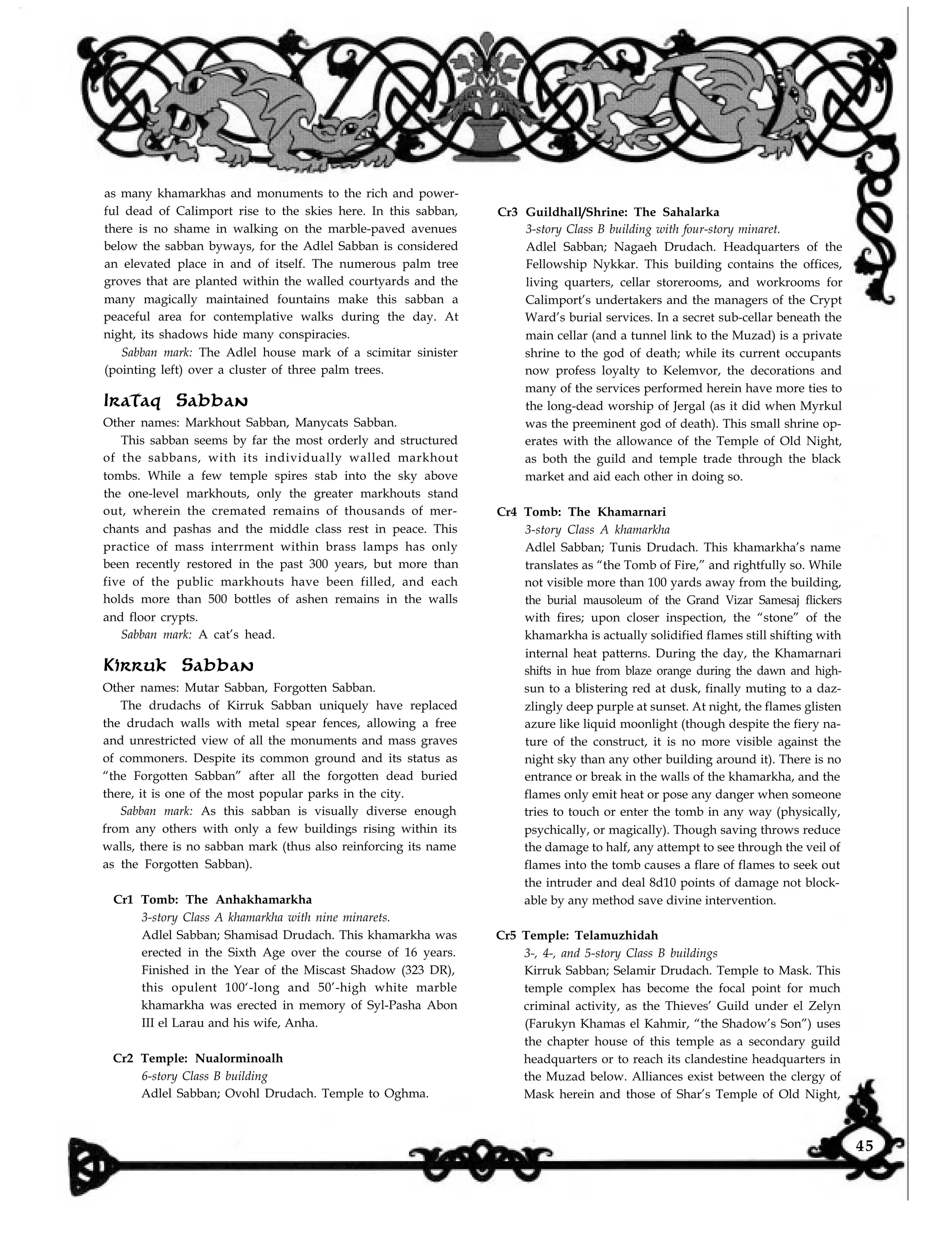
![which dominates the Muzad beneath the temple.
Cr6 Business/Stables: Stables of Tobeah
1 -story Class D building
Kirruk Sabban; Tulamir Drudach.
Cr7
Cr8
Cr9
Temple: The Darkness Passing
4-story Class A buildings
Kirruk Sabban; Zhakamir Drudach. Temple to
Kelemvor. This former temple of Myrkul has undergone
only two major changes in its eight-centuries-long lifes-
pan: Its name changed from Reaperscythe Hall to its
current title, and a glistening crystalline-glazed minaret
rose on one side of the temple with Kelemvor’s ascen-
sion (and the subsequent labors of the glaziers and ma-
sons who built the tower).
Business/Row House: Spectralhouse
2-story Class B minaret
Irataq Sabban; Sabayn Drudach (Drudach of the Seven
Sons). Stronghold and repository of knowledge for one
of the few Cloak societies to survive since the fall of the
Graycloak Society. Most eerie chamber in building is
the Hall of Eyes-Petrified beholders’ eyes line the walls
and are magically enspelled to shift and stare at entrants
(thoroughly unnerving to all but the most dauntless).
Their library and sage lore focus on ephemeral undead
such as ghosts, spectres, and wraiths from their minaret
base in Calimport. Their minaret is among the highest
buildings in Crypt Ward, looming over the markhouts.
Guildhall: Chathaodah
5-story Class B building
Irataq Sabban; Nasharot Drudach. Headquarters of the
Skilled Circle of Butchers and Dressers.
Cr10 Temple: The Dawn Belltowers
5-story Class A building with 2 partial belltower minarets on
the roof
Irataq Sabban; Orbafura Drudach. Temple to
Lathander.
Cr11 Guildhall: Osiirdah
5-story Class B building
Irataq Sabban; Nasharot Drudach. Headquarters of the
Order of Hunters and Furriers.
The Risen Sabbans
Over the past few centuries, the “ground level” has been
built up within the sabbans of the Central Wards.
Thus, the distinctions of drudachs and sabbans are blurred in
the areas of Palace Ward, Jewel Ward, and Grand Ward.
People reach the actual ground level by stairs leading be-
neath the elevated stone streets. The slightly vaulted
stonework streets provide solid avenues and courts rather
than the very directed movement of the normal byways. The
streets are braced by both stone and timber supports from
below, and the engineers’ guild built the streets to remain in
place even if half of the timber supports originally holding up
the stones fell away beneath the street. This whole buildup of
the streets allowed more direct movement for the upper
classes among where they lived. It also creates multiple sab-
ban areas beneath their streets wherein their slaves can live
and move about in their business without being seen or
“dirtying up” the richest sabbans in the city above. This
move also allows numerous pashas and sultans and the like to
operate clandestine activities with the rogue powers out of
plain sight and within social strictures in the Upper Muzad,
as many now call the three-ward-wide area.
In the risen wards, the edges of the sabban-wall byways are
now curbs, and the glazed colors of the curbs determine the
sabban and drudach within which a person stands. However,
the older sabban marks still exist in the walls beneath the
streets, and are thus still noted.
Palace Ward
[Central Ward] This ward encompasses the richest and
most affluent of Calishite society, including much of the
leadership. The Pasha’s Sabban, while not officially part of
the Palace Ward, rests at its heart. The villas of the pashas
dominate this ward, broken up only by the row houses and
garrisons for hired guards and mercenaries and the obligatory
taverns.
Ward Ruler: Tomuk yn Jhiavor el Kahmir, Sultan of
Palace Ward (CE hm F0) is the second grandson of patriarch
Nur el Kahmir from Manshaka (and a well-known pasha
among the spies of Calimshan). While Sultan Tomuk is an in-
effectual fop and a fool, he is paranoid and constantly keeps
his grandfather apprised of who says what to him merely to
find out what he should do about “his enemies.” Tomuk sur-
vives here only due to the threat his presence suggests to the
syl-pasha’s rivals about El Pesarkhal’s alliance with El Kahmir.
His grandfather and his contacts have profited greatly from
the amount of information provided by the easily panicked
Sultan Tomuk, and this avails pasha Nur el Kahmir well
enough to allow his grandson to be the bother that he is.
46](https://image.slidesharecdn.com/dd3-150414105156-conversion-gate01/75/D-D-3-5-calimport-47-2048.jpg)
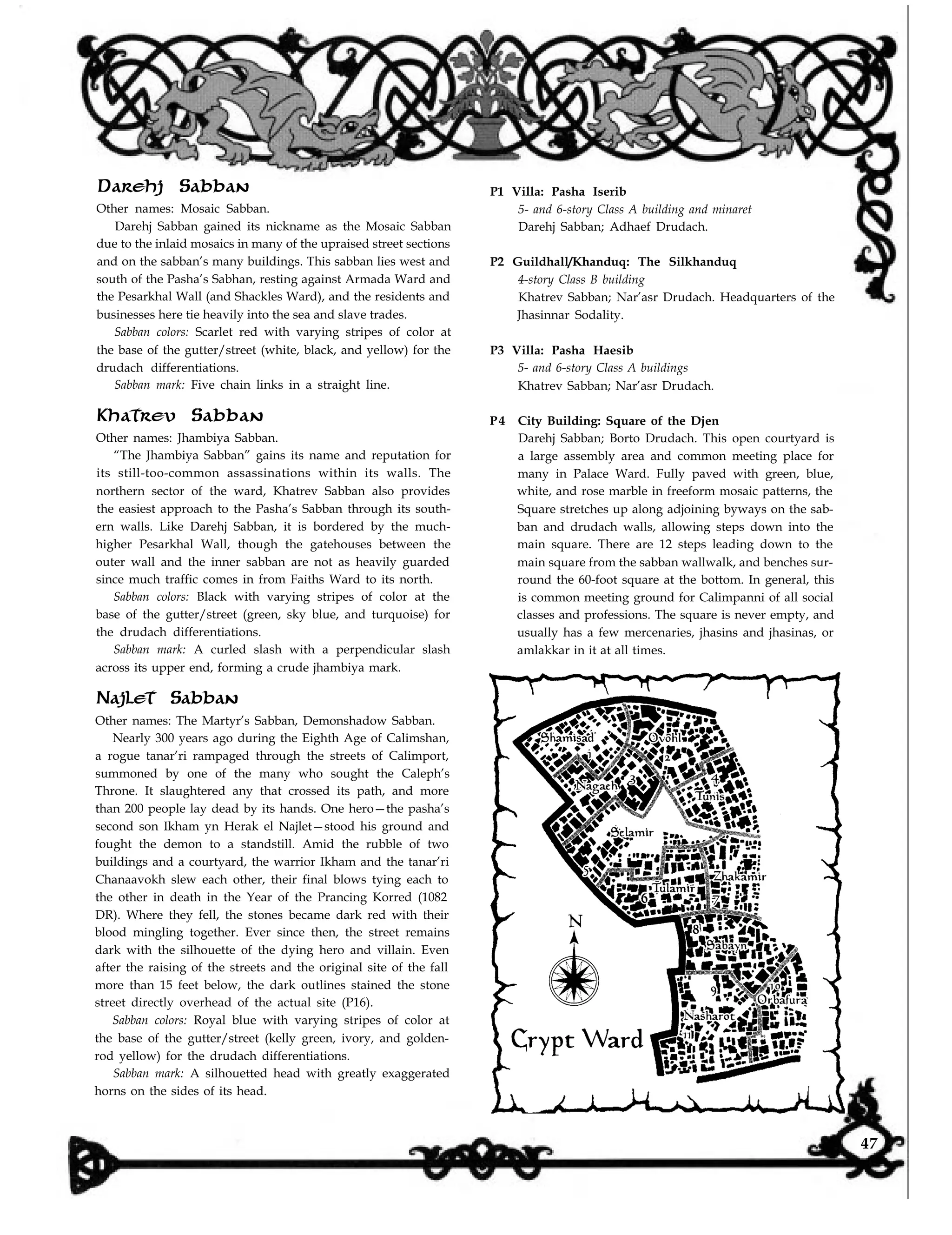
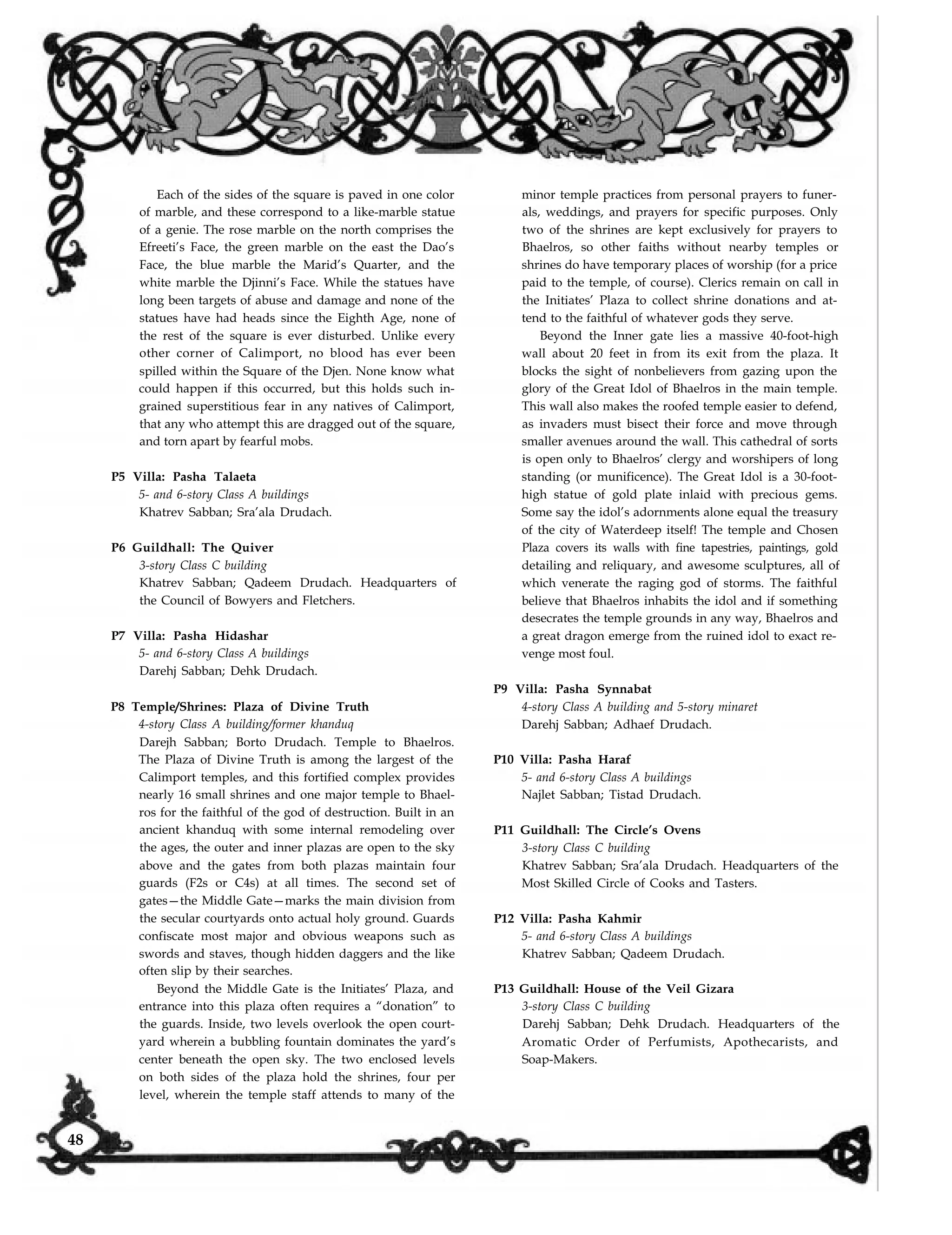
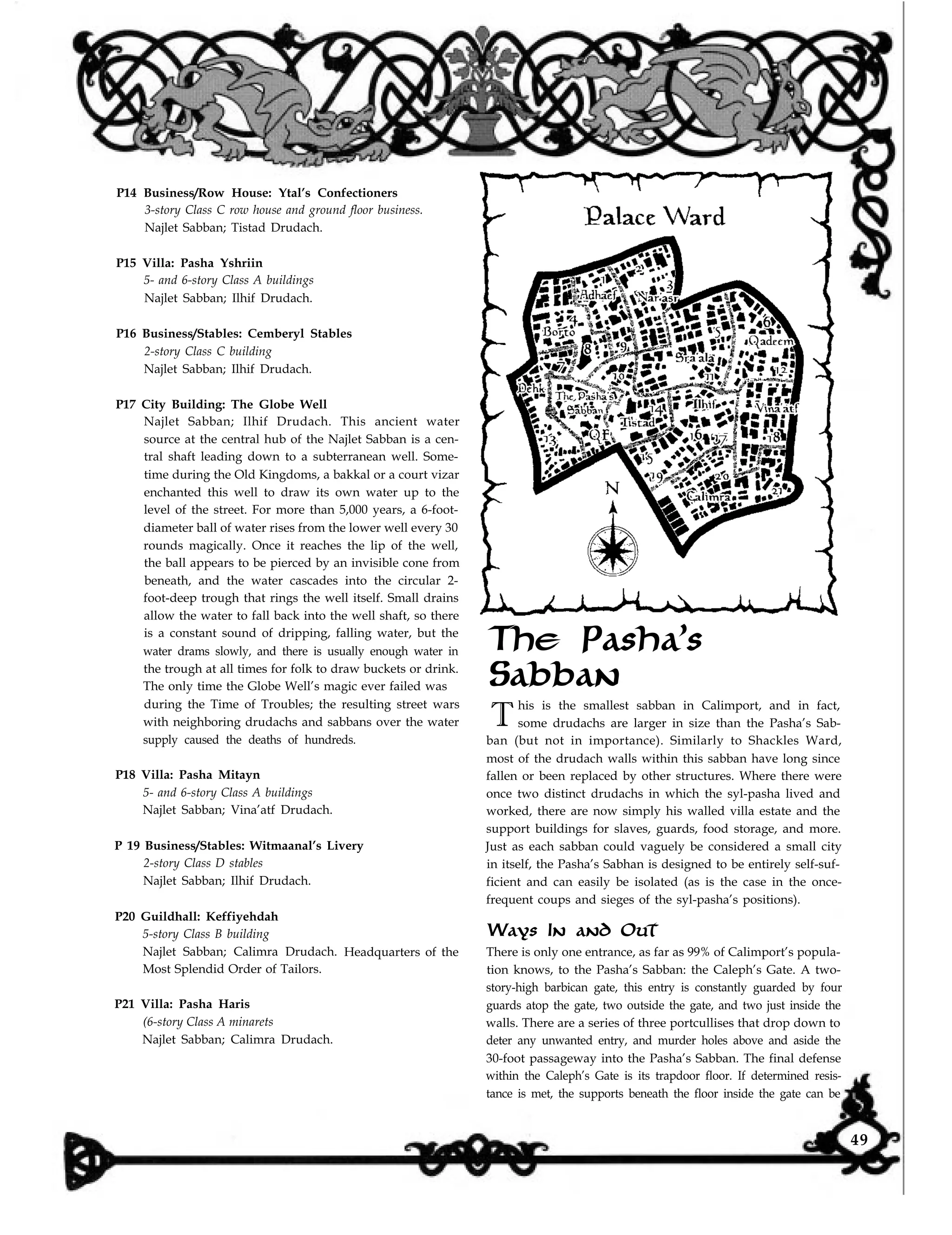
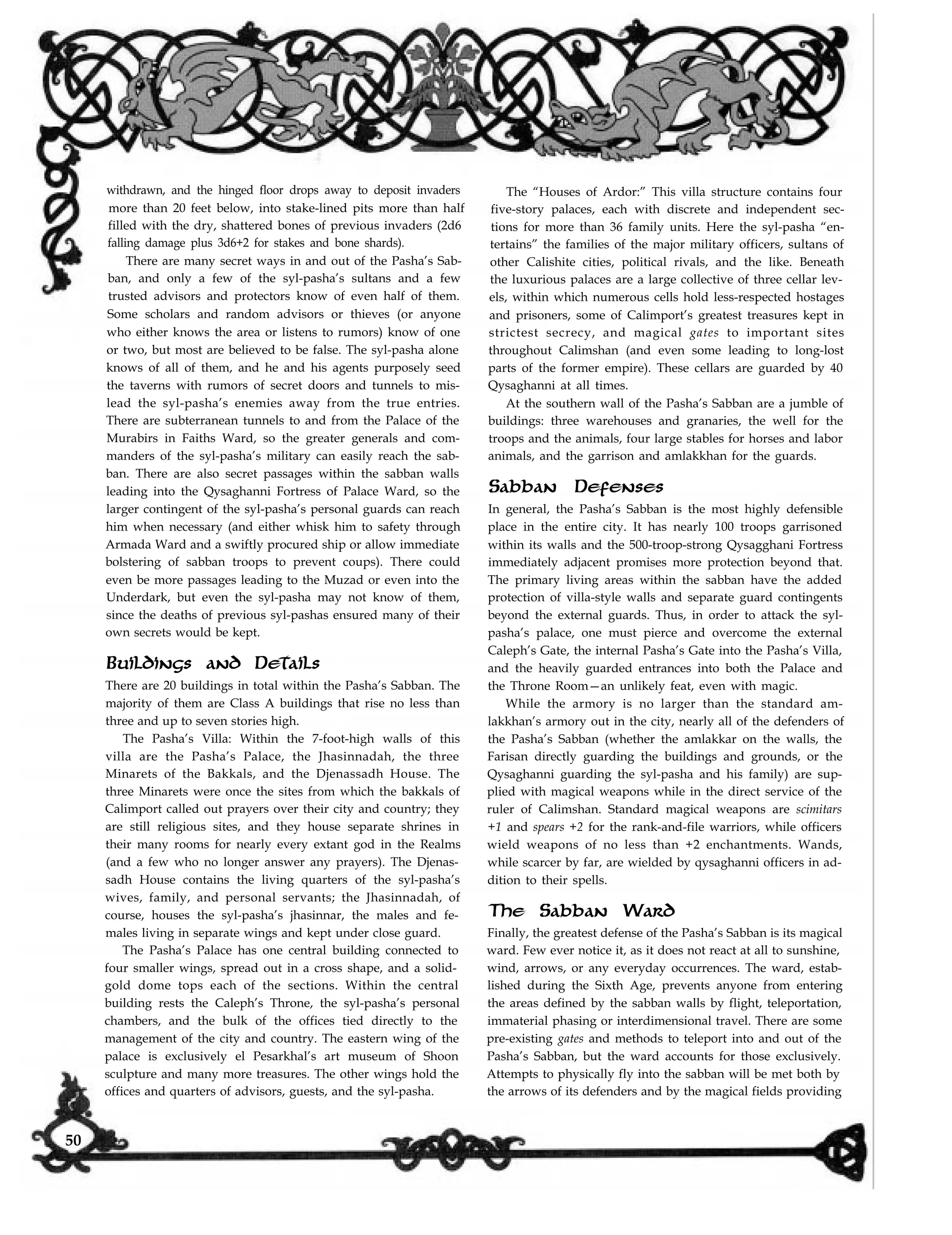
![an invisible barrier as effective as a wall of force against entry
at any angles. One of the subtler effects of the ward keeps the
moisture in the air over the sabban during the day, preventing
troop or animal dehydration, and keeping the air cooler on av-
erage than the rest of the city. At night, the moisture coalesces
as small rain clouds at the top of the ward as the temperature
drops, and by midnight every night, the moisture falls as light
rain within the sabban (and replenishes the rooftop and cellar
cisterns).
The Qysagghani Fortress
3- and 4-story Class B buildings with a 5-story minaret
The Qysaghanni Fortress is surrounded by a defensive wall
that connects to the walls about the Pasha’s Sabban. These
walls stand taller than the nearby walls of either Armada
Ward or the Sabbans Darehj or Najlet. It garrisons all 500 of
the personal guards of the syl-pasha, provides both an armory
and library for the “Imperial Guard” of both wizards and war-
riors, and has an assembly yard large enough for drills and
mock spell combats. There are secret tunnels within the
walls of this fortress that allow swift access to hidden tunnels
to any building in the Pasha’s Sabban without being seen.
The fortress’ most notable feature is the Lambent Minaret
its central free-standing minaret. This seems to be made
wholly of transparent blue crystal, and the fortress walls and
towers opposite the viewer on the other side of the tower are
visible. However, no one and nothing on the inside is visible
from the outside, even through the open archways behind
the balconies, thus making it a great place for clandestine
meetings with the syl-pasha. From the Lambent Minaret’s
parapet and balconies, the Qysaghanni launch many flying
carpets (of which the group has five) and patrol the areas
around the Pasha’s Sabban.
Jewel Ward
[Central Ward] This ward is the home of many of the
city’s whitesmiths and gemcutters, but as a place of labor (no
matter how delicate or exclusive), it is seen as a lesser place
than the equally rich but “noble” Grand and Palace Wards.
Curiously enough, the understreets of the Upper Muzad be-
neath Jewel Ward are the site of more than 60% of
Calimport’s illegal weapons and magic trade. The lower lev-
els of legitimate businesses deal in like trades with equal skill,
but are less particular about their customers or the goods they
sell, disguise, or alter.
Ward Ruler: Janar yn Janar el Vyrsatyr (NE hem P8 of
Shar) is many things, including sultan of Jewel Ward, druzir
of the Octel Drudach, and the third-highest-ranked member
of the Kindly Order of Silversmiths. Most importantly to
him, he is Darklord of the Temple of Old Night and is one of
three who sits at the side of Irtemara, the Dancer before
Dawn and the head of Shar’s temple in the Muzad. He uses
his influence above and below to play all elements against
each other so he can profit, no matter who wins any conflict.
Kalil’s Sabban
Other names: Butcher’s Sabban, Sholehfall Sabban, Vihad
Sabban.
Another of the sabbans whose name strays from conven-
tion, this one gets its name directly from the Fourth Age
Pasha Kalil Vihad, the brutal warrior pasha who personally
slaughtered the weak Sholeh dynasty to its last child. He is
yet known as the Butcher Vihad or Kalil the Bloody to the
present day, and thus the sabban’s aliases. In keeping with its
mark, Kalil’s Sabban contains the majority of the finework
artists who create ornate weapons and hilts. While not ad-
vertised heavily, this is also the place to come if you want
jewelry or items with hidden weapons and the like.
Sabban colors: Deep purple with varying stripes of color at
the base of the gutter/street (white, black, and gray) for the
drudach differentiations.
Sabban mark: A pair of scimitars crossed beneath a skull.
Mjôm Sabban
Other names: The Marriage Sabban.
The dominant traders in this sabban are silk importers and
jewelry makers and sellers. As both of the primary trades link
with marriage ceremonies, that partially provides the sabban’s
51](https://image.slidesharecdn.com/dd3-150414105156-conversion-gate01/75/D-D-3-5-calimport-52-2048.jpg)
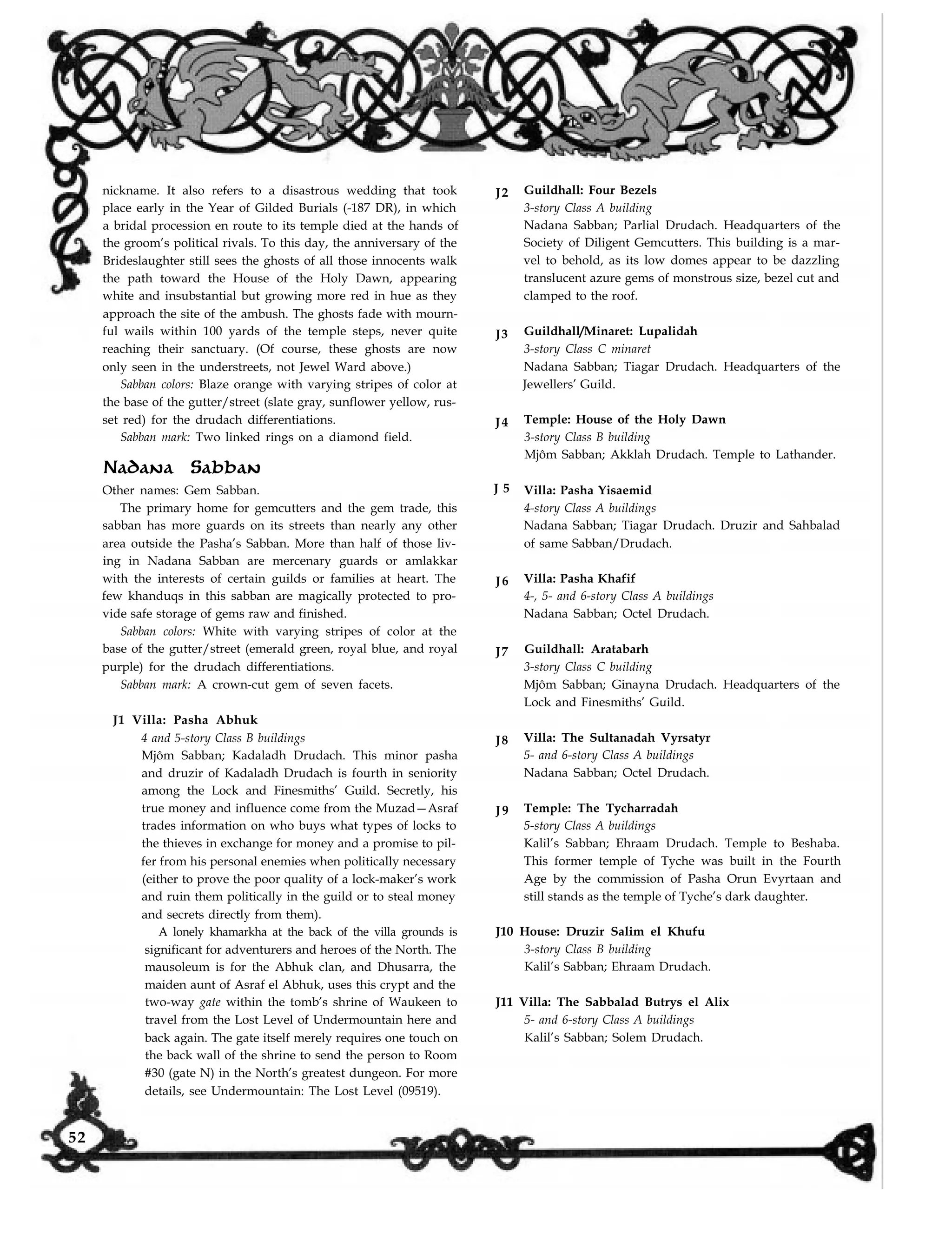
![J12 Guildhall: The Gilded Lantern
4-story Class B building
Kalil’s Sabban; Yuzhad Drudach. Headquarters of the
Shining Order of Goldsmiths and Gilders.
Grand Ward
[Central ‘Ward] Like other areas of the city, Grand Ward
fell victim to the Trades Conflagrations of recent years, and
much of its real estate was cleared and only recently rebuilt.
Like Emerald Ward, some areas were left cleared and Grand
Ward now encompasses the largest market area of the city.
Grand Ward is the second richest ward in Calimport outside
Palace Ward. In terms of sheer status, an address in this ward
at the heart of the city suggests one has reached the goal of
the “idle” life of the rich. Of course, those of Palace Ward
consider Grand Ward’s denizens “new money” and hold them
with some disdain.
Ward Ruler: Perat el Zastar, Sultan of Grand Ward (LE
hm M13) is one of the “new money” upstarts recently immi-
grated into Grand Ward from Wizard Ward. One of his great-
est weapons is his vizar’s status within the syl-pasha’s court;
Perat came from Manshaka with el Pesarkhal, and aided him
greatly during the Darkstalker Wars. Now with many more
intrigues afoot, the syl-pasha may live to regret bringing this
viper into the fold, though el Zastar’s word is his bond, and it
will never be his hand that brings the Pesarkhal clan down.
Cajaan Sabban
Other names: Market Sabban.
This sabban fell victim to the Trades Conflagration and
less than 20 of its former buildings survived the disaster.
Where the Cajaan Bazaar once stood among four gleaming
white marble khanduqs from the Third Age, the area is now
totally wiped clear. The Cajaan Market now provides a wide-
open marketplace for bazaar carts and stands to sell their
wares. Among the greatest losses were not the Cajaan Khan-
duqs but the gold they contained—The Conflagration turned
more than 10,000 gold pieces and 2,500 trade bars into
molten gold, and it flowed down into the Muzad where it was
eagerly claimed by the many shadowy denizens. While pasha
Nur yn Kalil el Wariq (NE hm T4) lost an inordinate amount
of money in the fires, he has recouped his losses by the fees he
charges for day (and night) staging of markets in the market.
Sabban colors: Vibrant green with varying stripes of color
at the base of the gutter/street (midnight blue, crimson red,
and wheat yellow) for the drudach differentiations.
Sabban mark: The Cajaan’s former signet of a fiery sun
pierced from behind by three arrows pointing southwest.
Casajr Sabban
Other names: Stars Sabban.
This area is dominated by the entertainment and some
scholarly trades. While none of the city’s libraries burned in
the latest fires, the warehouses here held much of the stock
ink, parchment, and vellum used by both the Masterful
Order of Clerks, Scribes, and Scriveners and the Dutiful Cir-
cle of Binders and Printers. These items helped fuel the fires
and saw nearly a third of the sabban aflame.
Sabban colors: Slate gray with varying stripes of color at
the base of the gutter/street (tan, ivory, and sky blue) for the
drudach differentiations.
Sabban mark: A book with a five-pointed star on its outer
cover (prominent point up).
Makista Sabban
Other names: Golden Maidens Sabban.
One of two sabbans to escape much of the Trades Confla-
gration, this sabban seems much like the typical jumble of
shops and row houses that one would find in any city of
Faerûn. The only differences are that the goods are expensive
luxury items, the buildings are glazed mud-brick or carved
stone, and the winding jumble of streets have been set in
place for longer than dragons measure a long lifetime. The
Makista Sabban’s bazaars, while temporary tents and carts in
most other sabbans, have become permanent additions and
sub-streets winding precariously around the khanduqs and
53](https://image.slidesharecdn.com/dd3-150414105156-conversion-gate01/75/D-D-3-5-calimport-54-2048.jpg)
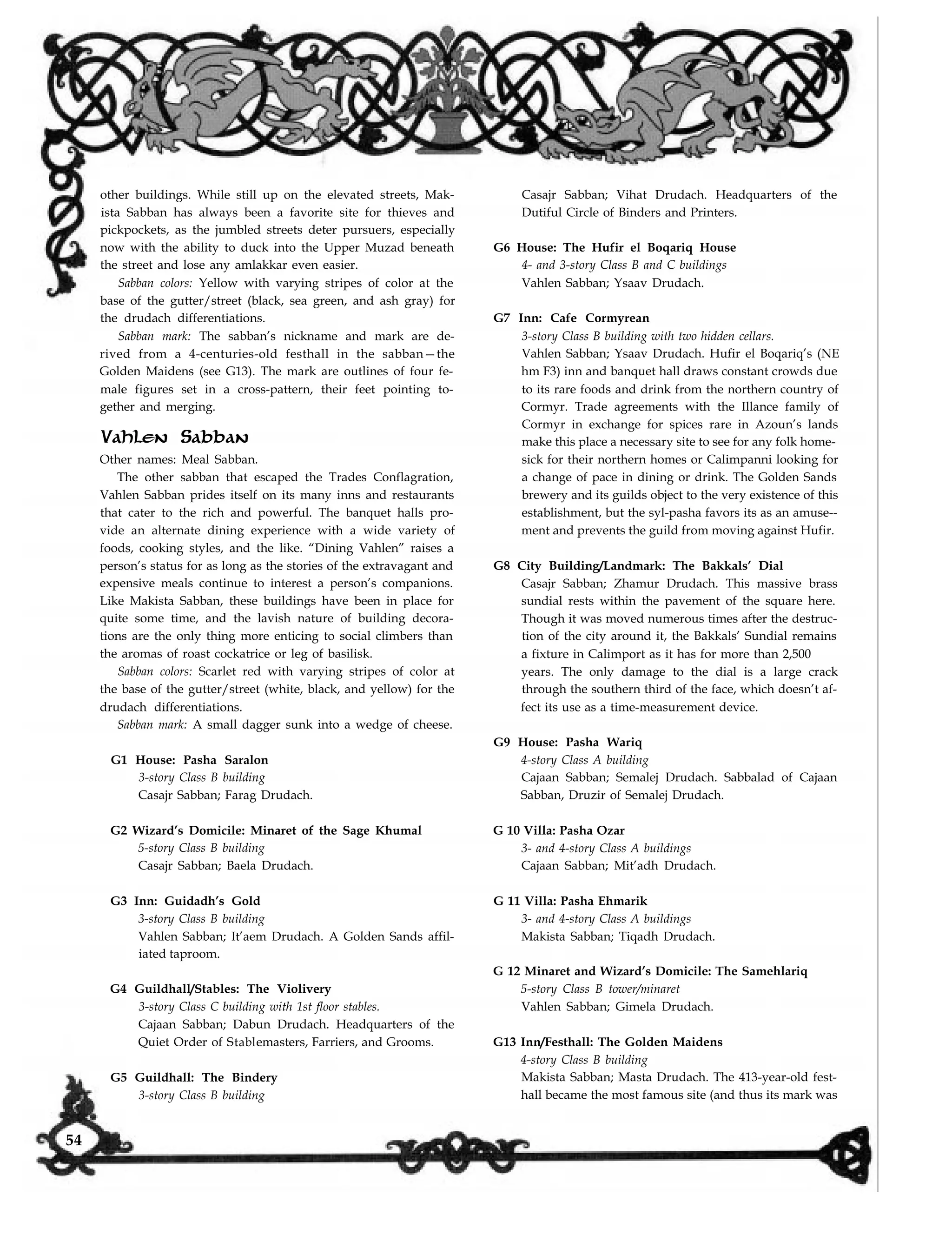
![adopted for the sabban itself) in Makista Sabban when the
avatars of Sharess, Hanali Celanil, Sune, and Lliira all
graced the festhall during its Midwinter Revels. Once
called the Jacinth Harp, no one remembered that name
after the visit by the “golden maidens.” While no one dis-
putes the story, there are no corroborating myths among the
four goddesses’ churches to support the tales of the Golden
Maidens. Despite this lack of religious support, the sabban
and the festhall continue using the reference proudly.
G14 Guildhall: The Desert’s Gifthouse
4-story Class B building with partial minaret
Makista Sabban; Binut Drudach. Headquarters of the
Guild of Glassblowers and Bottle-Makers. Near the top
of the two-story minaret attached to the two-story
building is a 6-foot-high hourglass that magically flips
itself within its minaret stand upon filling its bottom
level. The sands within are blood red, and the hourglass
takes four hours exactly to fill each time. As the top
base of the hourglass is of gold and the bottom of silver,
folk can roughly gauge time by the Desert’s Gifthouse
(an oblique reference to the glass they sell within).
G 15 Guildhall: Shiinalidajh
5-story Class B building
Makista Sabban; Tiqadh Drudach. Headquarters of the
Glaziers’ Society. Among the brightest of buildings,
Shiinalidajh is covered with cornflower-blue glazing
and its roof tiles are a dazzling white.
Quill Ward
mage and temporary matriarch of the still-proud Namor clan.
Sages attest that no plagues or diseases take hold of people
Ward Ruler: Abbas yn Akkabar el Quaahl, Sultan of
within the ward (though they continue unabated here if con-
Quill Ward (LE h
tracted outside of it), paper and parchment does not age and
crack (and books of more than 200 years remain as supple
em M15) is a long-time vizar and Pesarkhal
and fresh as when they were new), and candle flames emit
twice as much light as normal (providing scribes with far bet-
loyalist from Manshaka. When the syl-pasha was still learn-
ter working conditions than elsewhere in the city).
of the city’s actual administrative work gets done here, and it
[Central Ward] Just north of Wizard Ward is the area
where scholars, scribes, and learned sages congregate. Much
is also the ward with the largest concentration of libraries
(though most are private collections only). As it is also one
of the quieter areas of the city, it is the home for many peace-
ful inns and rooming houses favored by travelers.
Quill Ward, while not a recent addition to the city, has
one special feature shared only by the Pasha’s Sabban and ad-
joining Wizard Ward: It is surrounded by a ward. This field of
magic provides a number of effects for the people of Jhaapir,
Hapij, and Nasim Sabbans, though they know only of its
most basic reward: No fire larger than a hearth fire can sus-
tain itself long under the ward, thus preventing these areas
from succumbing to the fires that periodically ravage
Calimport. The wizard Nureh yr Catahra el Namor, also
known as the Emerald Enchantress, created the ward in the
Year of the Enigmatic Smile (693 DR), to better protect her
ing the earliest intrigues in the court of pasha Abon Duum,
Abbas el Quaahl served as his scribe. When he claimed
power in Manshaka after Duum’s disappearance, Abbas rose
to become a vizar. The quiet exterior of this small, gaunt Cal-
ishite man with a tightly trimmed beard and moustache hides
one of the most utterly ruthless souls ever to walk the Pasha’s
lands since the days of the Shoon. Some oath in the past ties
the vizar with the syl-pasha, and both are incapable of doing
harm or misfortune to the other, but the plots they hatch as
one are frightening in their reach and effect. This little man
who dresses always in ivory and tan with a scarlet sash and
keffiyeh has nearly as many folk living in fear of his displea-
sure as does the syl-pasha.
Emerald Archives from destruction. The ward’s other powers
remain elusive to all but those who study the first female
The vizar has little to do with the direct operations of
Quill Ward, and he leaves it in the hands of his nervous yet
55](https://image.slidesharecdn.com/dd3-150414105156-conversion-gate01/75/D-D-3-5-calimport-56-2048.jpg)
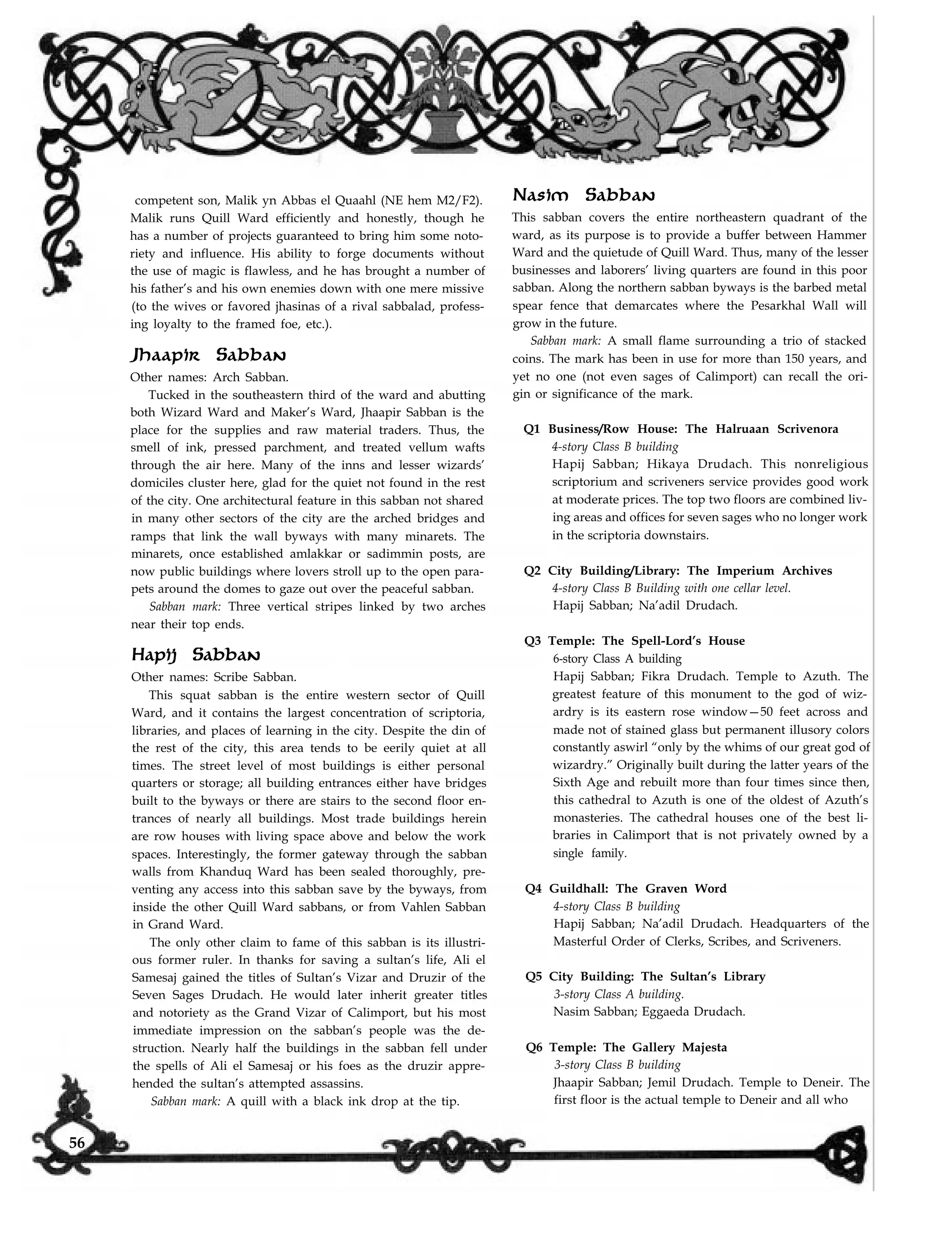
![enter are expected to honor his altar by stopping for an
informal prayer service or making a donation to the at-
tendant priests. The second floor is the Gallery proper,
and it is an artifact museum with many incredible dis-
plays; while all artifacts on display are magical, they are
all perfect forgeries. The priests keep the true artifacts
in a vault deep beneath this building, and the only ac-
cess is by moving the altar and climbing down long
winding stairs into the vault. Any so foolish as to steal
from the Gallery find themselves swiftly captured by the
amlakkar and beheaded, since the magic on the displays
allows for easy tracking. The top floor contains the per-
sonal quarters of the priests.
Q7 Guildhall: Home of the Healers
3-story class C building
Nasim Sabban; Nuvis Drudach. Headquarters of the
Circle of Physicians and Midwives.
Q8 Villa: Pasha Qoriha
3- and 4-story Class A buildings
Nasim Sabban; Nuvis Drudach.
Q9 Business/Row House: Eli yn Estaar’s Inks
2-story Class C building
Jhaapir Sabban; Jhalal Drudach. Eli yn Estar (CE hm T2)
is one of many ink-makers and suppliers in Quill Ward,
but he is one of the few who makes extra coin by poison-
ing quills and ink or simply poisoning someone directly.
Q10 Business: The Bards’ Wisdom
2-story Class B buildings
Nasim Sabban; Yaraf Drudach. One of many private
lending libraries and sages’ consortiums in Calimport,
this collection of books spans topics such as travel,
bards’ tales and songs, and legends of other countries
beyond the Empires of the Shining Sea. Druzir Kamal el
Kitaeb (LN hem M4) owns and operates this business,
but his true calling is his secret affiliation with the
Harpers, as his father and his father’s father before him.
Q11 Guildhall: Memnon’s Fingers
4-story Class B building
Jhaapir Sabban; Jhalal Drudach. Headquarters of the Il-
luminated Guild of Chandlers and Lamplighters. This
pentagonal building is unique by its five minaret towers
of four stories each at the intersections of the building’s
walls to each. Magical fires remain everlit atop the
minarets, and the off-white glazing and the brick pat-
terns of the minarets top off the image, making all five
towers appear as gargantuan candles.
Q 12 Villa: Pasha Khaetim
3- and 4-story Class A buildings
Nasim Sabban; Yaraf Drudach.
Q13Guildhall: Vimahlydah
4-story Class B building
Jhaapir Sabban; Shuzah Drudach. Headquarters of the
Choral Council.
Q 14 Business/Row House: Summarl’s Scrolls and Maps
3-story Class B building
Jhaapir Sabban; Shuzah Drudach.
Wizard Ward
[Central Ward] Obviously, the bulk of the city’s (and the
country’s) magical might rests herein. There are many
strange sights in this ward, from the many wizards’ minarets
to the permanent illusions and colored wards over many a
villa. Like the Pasha’s Sabban and Quill Ward, the fields of
magic have been in place for some time, though unlike those
previous areas, Wizard Ward has no one overarching ward
providing benefits for all. The wards about the Etarad, Najja,
and Tarshaj Sabbans are all placed by private individuals for
their own ends. With more than 1,000 buildings within the
ward and more than a third of them the homes of wizards and
sages, one can barely presume to guess at the variety of
magical effects bound in nearly 400 wards.
Many assume this ward to be among the richest in the city,
but to look at it from the byways, it seems half-deserted and
less extravagant and magical than expected. In truth, while
there are many unique and amazing sights to see here due to
the extroverted nature of illusionists and enchanters, most
wizards keep to themselves, remain indoors in study and
seclusion, and do not seek to impress their neighbors any
more than is necessary to ensure their own privacy. The sultan
of this ward, however, does exact vows from every wizard liv-
ing in his sabbans—Guild Arcane membership is mandatory
for all who emigrate here, and guild rules are as strictly en-
forced by the guards on the streets as they are in the guildhall.
The only other distinction about Wizard Ward, which
comes as no surprise to most, is the presence of wizards
among the amlakkar. Often among the officers, there are at
least two wizards to every 10 amlakkar warriors here, and
they are armed with rods of absorption and other defensive
measures to effectively neutralize rogue wizards swiftly. Given
the amount of magic loosed in the city streets each day, this
ward is strangely safe from much of the chaos, as magical
problems are expected and ended more quickly here.
Ward Ruler: Eli yn Adnan el Beza, as Sultan of Wizard
Ward (N hm M19) and Caleph Arcane of Calimport, con-
trols the most powerful guild and the most powerful real estate
57](https://image.slidesharecdn.com/dd3-150414105156-conversion-gate01/75/D-D-3-5-calimport-58-2048.jpg)
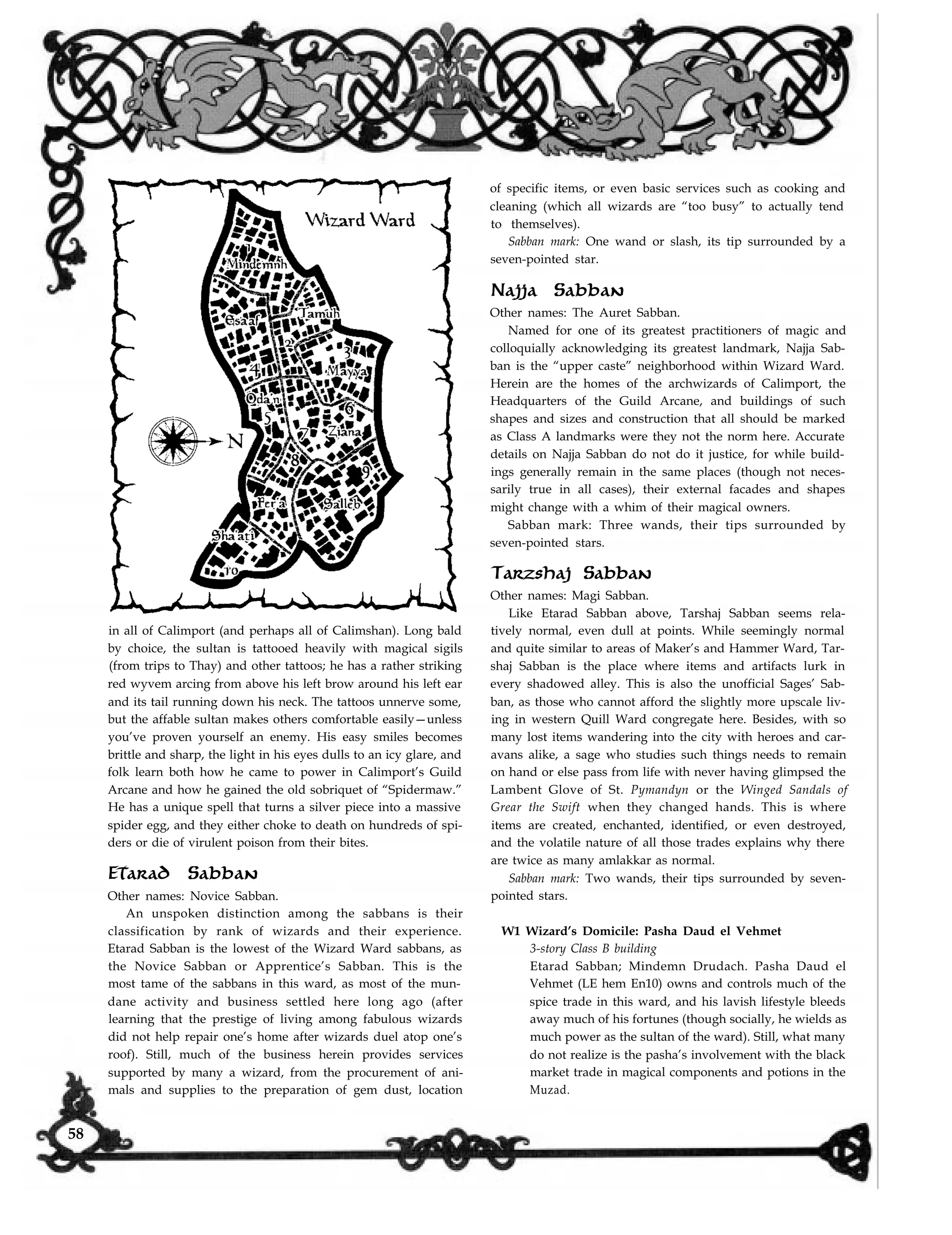
![W2 Guildhall: The Loom Halls
4-story Class B building
Etarad Sabban; Tamuh Drudach. Headquarters of the
Vibrant Order of Dyers and Weavers.
W3 Business/Minaret: Aquas and Azures
7-story Class B building
Najja Sabban; Mayya Drudach. This jewelry and gem-
cutter’s shop caters to an exclusive clientele of its
choosing, as it is set high up in a minaret with no direct
street or wall access to it. Should anyone prove to be of
the appropriate social rank and have any interest in the
wares of Melroat and his sapphires and other blue gems,
servants deliver an invitation to them, from which they
make an appointment. When customers are expected, a
blue flying carpet floats down to the waiting client to
bring him up to the shop. Flight is the only in or out of
the shop, and while one cannot enter the open balcony
that is the shop’s entrance unless he is on the carpet
(walls of force, etc.), one can easily leave by his own
means of flight.
W4 Wizard’s Domicile: The Sphere of Kaatos
3-story Class B building
Etarad Sabban; Esaaf Drudach. This is one of the most
significant sights in Etarad Sabban—the wizard’s home is
a massive silver sphere floating about 18 feet above the
courtyard beneath it. It has no apparent doors, windows,
or defenses, and it continuously spins rapidly, preventing
anyone from jumping or landing on it and holding on.
Inside, Kaatos’ lair is much larger than it seems, and the
entire interior surface of the sphere is his workshop, li-
brary, and living space (all held to the outer surface of the
sphere by the spinning forces). Guests learn to enter by
becoming insubstantial and passing through the wall, but
uninvited guests trying the same passage become
stretched across the surface of the sphere and are slain for
trying to steal from the paranoid but more often kindly
collector of Imaskari relics and artifacts (N hem M14).
W5 Guildhall: Eyesafar Hall
4-story Class B building
Tarshaj Sabban; Odan Drudach. Headquarters of the
Fellowship of Surveyors, Mappers, and Chart-Makers.
W6 Guildhall: The Auret
7-story Class A building/minaret.
Najja Sabban; Ziana Drudach. Headquarters of the
Guild Arcane. Seven stories tall and more than 75 feet
wide at its base, this seemingly solid gold minaret is
among the most impressive sights in Calimport, as mag-
ical sigils scrawl themselves in the apparently liquid
gold skin of the doorless minaret. Guild members who
approach the tower have openings appear before them,
whether they approach from ground or the air (as a
virtue of their magical guild membership rings). This
tower holds the High One’s Library, the sole library ex-
clusively stocked with books of and about magic, re-
stricted to only senior guild members.
W7 Wizard’s Domicile/Villa: Suryvlashadah
Three S-story Class A buildings with a 5-story minaret
Najja Sabban; Ziana Drudach. The home of the Caleph
Arcane of Calimport, like the guildmaster himself, is far
more than it seems. A trio of reddish granite buildings
and a white marble minaret cluster behind an open, un-
guarded high villa wall; those fools who enter without
announcing themselves to the lion’s head that is the
keystone in the gate arch find stone arms wrapping
around them from the walls and flagstones of the court-
yard within. The bald and tattooed Pasha Eli yn Adnan
el Beza (N hm W19) wonders at all things Thayvian
(thus, his facial and scalp tattoos), and the courtyard
and villa are filled with many sculptures, some of which
people suspect are petrified enemies of the pasha.
W8 Wizard’s Domicile/Minarets: Caaledar
Six 5-story Class B minarets.
Tarshaj Sabban; Fer’a Drudach. Home of the married
wizards Oma the Fireveil (N hf Inv11) and Nur “Jambi-
yarcane” (NE hm Con10), whose offensive spells and
specialists’ magics make them well-paid vizars to the
Qysaghanni on an annual basis. The minarets that
make up this villa/wizard’s house are six perfectly round,
slim white-glazed brick towers capped by gold-plated
domes. The balconies at the second and third levels of
the minarets are all connected by invisible arches be-
tween adjacent minarets.
W9 Wizard’s Domicile: The Coiled Quelzarn Tower
4-story Class A minaret.
Najja Sabban; Salleb Drudach.
W 1 0 Wizard’s Domicile: Tuuramil House
3-story Class B building
Tarhsaj Sabban; Sha’ati Drudach. This dark brooding
row house is a school specifically for the training of
necromancers.
Maker’s Ward
[Central Ward] Maker’s Ward contains many of the
skilled trade guilds and some of the newest khanduqs in the
city. While not a socially prestigious address, Maker’s Ward is
59](https://image.slidesharecdn.com/dd3-150414105156-conversion-gate01/75/D-D-3-5-calimport-60-2048.jpg)
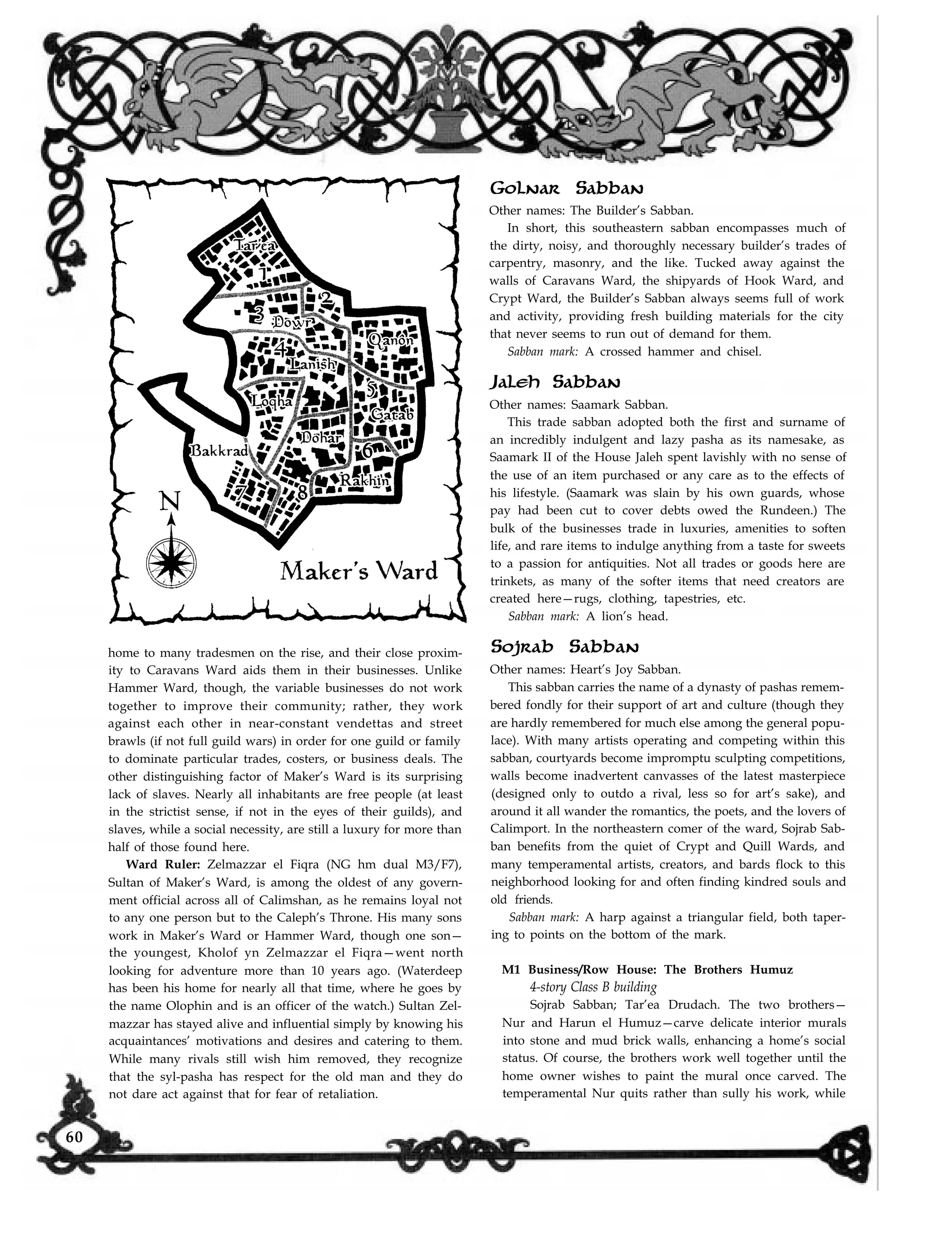
![the business-minded Harun finishes the job. Spending much
time in others’ homes allows the brothers to eavesdrop on
their clients for their true masters in the Rundeen, to whom
they report once every six months.
M2
M3
M4
M5
M6
M7
M8
Business/Row House: Salehlon’s Carpets
5-story Class B buildings
Sojrab Sabban; Qanôn Drudach. This rug-makers shop
handles standard orders on the first two floors and cus-
tom-made carpets on the third. The special orders for
magical carpets can be made on the fourth floor, while
the owners live in the top floor.
Guildhall: Casters’ Claim
3-story Class C building
Sojrab Sabban; Dowr Drudach. Headquarters of Pewter-
ers’ and Casters’ Guild.
Guildhall: Twelve Reeds House
2-story Class C building
Jaleh Sabban; Lanish Drudach. Headquarters of the
Basketmakers’ Guild.
Guildhall: Bahil-Bakadah
3-story Class C building
Golnar Sabban; Gatab Drudach. Headquarters of the
Order of Skilled Coopers and Barrel-Makers.
Amlakkhan: Amlakkhan Jaleh
2-story Class C building
Golnar Sabban; Rakhin Drudach. This amlakkhan is
directly run by extortionists and thugs who also happen
to wear the amlakkar uniforms in this sabban. Their
commanding officers control the protection rackets in
this sabban and provide a healthy cut for the sabbalad.
Any amlakkar that do not cooperate with this corrupt
system of protection meet with “lethal tavern brawls”
and “accidents” that either teach them to play along or
end their lives.
Business/Row House: Taerako Statuary and
Stonework
3-story Class B building
Jaleh Sabban; Bakkrad Drudach.
Guildhall: Sadidahjalan
5-story Class B wooden building
Golnar Sabban; Dohar Drudach. Headquarters of the
Guild of Stonecutters and Masons.
Armada Ward
[Port Ward] This ward encompasses solely the enclosed
docks for the Nallojal’s ships and the garrisons and armories
of the same. In the past 20 years, the Djenispool and Pe-
sarkhal pashas have expanded the docks of Armada Ward
such that it now is capable of docking two-thirds of the entire
Nallojal fleet. Tavihr Sabban contains 90% of the buildings
and businesses of the ward, even though it only comprises
35% of the area, since the Djenispool Sabban dominates the
rest of the ward. Of those buildings, more than half of them
are official city buildings for the management and coordina-
tion of el Nallojal. Civilians can enter Armada Ward, but
unless they voluntarily sign up for the Nallojal or have some
connections with the upper echelons of power (pasha or
above title), wanderers looking for trouble in Armada Ward
will find themselves press-ganged into service on one of the
Nallojal’s ships for a three-month-tour of duty.
Ward Ruler: Fahd yn Ralan el Pesarkhal, Sultan of Ar-
mada Ward and Sabbalad of Makista Sabban (NE hm F11),
is the eldest son of Syl-Pasha Pesarkhal at 39 years old. Many
of his 12 surviving brothers would covet his sultan’s crown,
but Fahd’s ambitions drove him to take control of all the
armed forces save the Qysaghanni (who answer only to his
father). As the Syl-Sultan of the Nallojal (navy), the Sadim-
min (army), and Farisan (elite forces), Syl-Sultan Fahd el Pe-
sarkhal spends much of his time touring Calimshan and re-
61](https://image.slidesharecdn.com/dd3-150414105156-conversion-gate01/75/D-D-3-5-calimport-62-2048.jpg)
![minding the outer pashas and scheming sultans of Almraiven
and Memnon (as well as other foreign ports) that the syl-
pasha is a force not to be crossed. His own physically threat-
ening presence (and that of his personal bodyguard contin-
gent of 12 minotaurs) ensures that those who meet him un-
derstand not to question or cross him either. The few who did
so, underestimating his cunning and intelligence due to his
hulking stature and gruff manner, died swiftly in manners too
distasteful for Calishites to speak of. Few doubt, and many
fear, that he is truly his father’s son.
Tavhir Sabban
Other names: Hammock Sabban.
This sabban, named after one of the more militaristic of
the bakkal dynasties of Old Calimshan, is the barracks and
armory for the syl-pasha’s naval armada. The garrisons for the
Nallojal are far more unique than most military barracks—
the bunks are all hammocks strung up two stories high
among ceiling beams and pillars, and climbing ropes and rig-
ging replace floors and stairs. Within this sector, one finds
nearly any type of maritime support trade or service, and
many of them belong to retired Nallojall seamen.
Sabban mark: A black anchor.
Djenispool Sabban
Other names: Wharf Sabban, The Wharf.
The only remnant of the previous dynasty’s rule, the Djenis-
pool Sabban retains its name in official documents only since
Syl-Pasha Rashid Djenispool commissioned much of the work
on expanding the docks of Armada Ward. As most sailors and
officers understand the political winds of Calimport, they all
take great care to refer to this only as Wharf Sabban, or the
Wharf. While there are a few buildings for the collection of
dock fees and minor businesses or equipment warehouses for
the League of Harbormasters, there is really little more to this
entire sabban than the docks and the ships lashed to them.
Sabban mark: The Djenispool seal of a genie’s lamp pour-
ing water out of its spout, a black six-pointed star prominent
on the lamp.
A1 Garrison: The Nallojal Billets
3- and 4-story Class C buildings
Tavihr Sabban; Hikal Drudach.
A2 Villa: The Sabbalad Bartoq
2- and 3-story Class A buildings
Tavihr Sabban; Seahrm Drudach.
A3 House: Druzir and Rysal Aban el Sirsi
3-story Class B buildings
Tavihr Sabban; Khadra Drudach.
A4 Villa: Pasha Tomouh
5- and 6-story Class A buildings
Tavihr Sabban; Khadra Drudach.
A5 Villa: Pasha Mohandis
3- and 4-story Class A buildings
Djenispool Sabban; Faso1 Drudach.
A6 Amlakkhan: The Wharf Amlakkhan
3- and 4-story Class C buildings
Djenispool Sabban; Faso1 Drudach.
A7 Villa: Pasha Rabta
3-, 4-, and 6-story Class A buildings
Djenispool Sabban; Nowm Drudach.
A8 Minaret/Guildhall: The Harpoon Minaret
4-story Class B minaret.
Djenispool Sabban; Nahla Drudach. Headquarters of
the Guild of Fishermen, Whalers, and Undersea
Hunters.
Dock Ward
[Port Ward] “Just ask anybody—they’ll tell ya Dock Ward ‘as
the most o’everything !” Such testimonials are common among
the seamen of this ward, as this ward contains many “mosts” for
Calimport. As the western half of the central trading and pub-
lic docks, it does have the most berths for ships, including Ar-
mada Ward. It contains the most warehouses for many trade
guilds shipping their products by sea, though it does not con-
tain many guildhalls (most preferring to be stationed farther in
the city). It also has the notoriety of having the highest con-
centration of festhalls and taverns for any ward in Calimport. If
folk are looking for trouble or just a rowdy time, Dock Ward is
their destination. And while all hold numerous taverns, inns,
and festhalls, the three sabbans are nicknamed according to
which place is most numerous within their walls.
Ward Ruler: Batras yn Faruk el Tuladim, Sultan of Dock
Ward (CN hm T5; Str 17, Dex 16) began his rise a dozen
years ago as the young 19-year-old druzir of Gamil Drudach.
Learning never to draw attention to himself, he played the
sniveling sycophant to his sabbalad until he could kill him
and divert suspicions elsewhere. While word of enough mur-
ders fell onto his shoulders, the vizar and sabbalad Tuladim
used his influence with the Harbormasters’ guild and the
shipwrights’ guilds to financially ruin those who plotted his
downfall. Batras, seeing the political winds shift, aided the
upstart Ralan el Pesarkhal by secretly slaying a number of the
Djenispool pashas and sultans during the Darkstalker Wars.
While he doesn’t trust Batras, the syl-pasha rewarded him
with the sultan’s crown over Dock Ward. This alone gave
62](https://image.slidesharecdn.com/dd3-150414105156-conversion-gate01/75/D-D-3-5-calimport-63-2048.jpg)
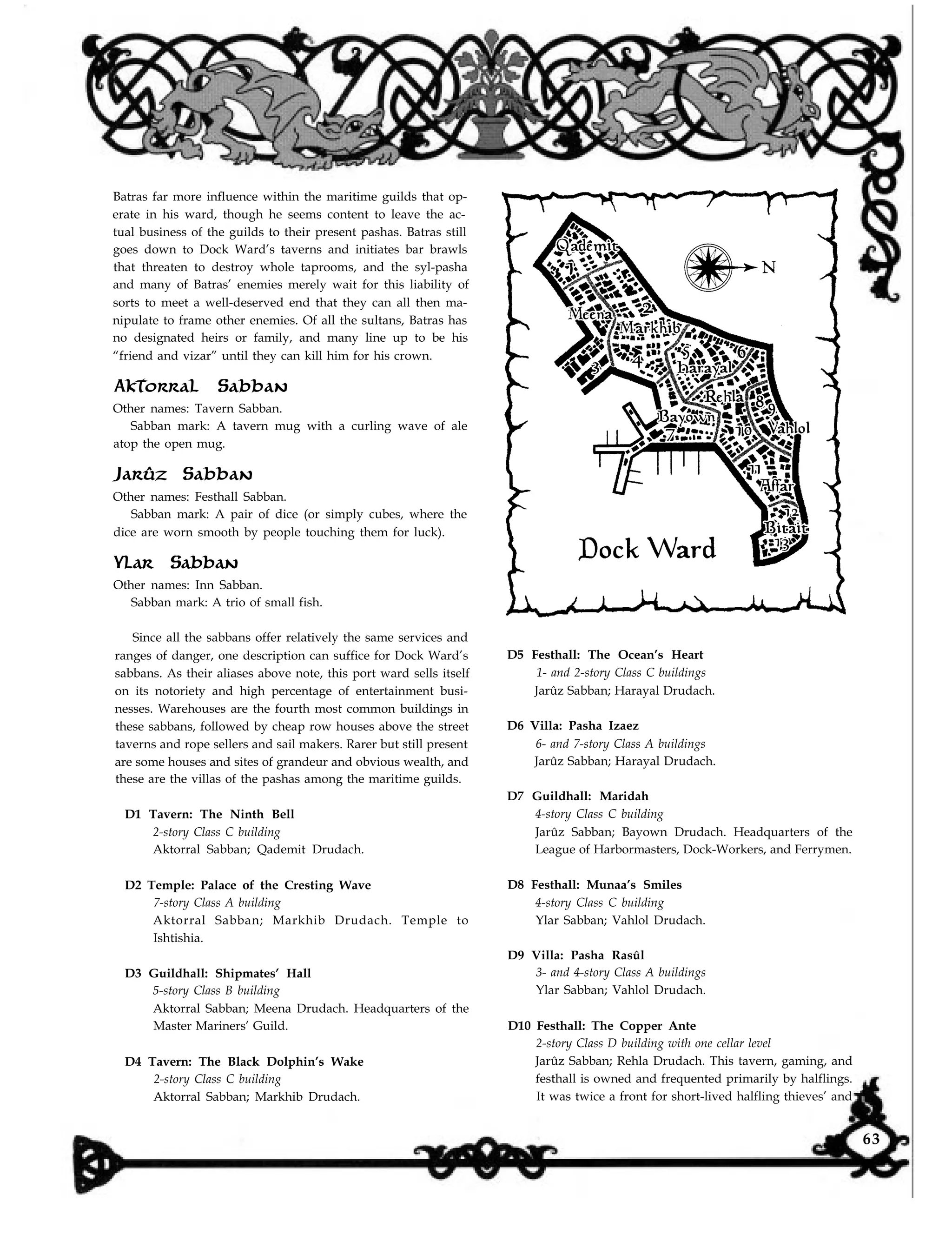
![spies’ guilds, but the Darkstalker Wars and the pressures from
the Four Families either subjugated the halflings or absorbed
them into their own ranks.
D11 Guildhall: Shelamardah
3-story Class C building
Ylar Sabban; Affar Drudach. Headquarters of the Loyal
Order of Fishmongers.
D12 Villa: Pasha Badayin
5-story Class A buildings
Ylar Sabban; Bitait Drudach.
D13 Villa: Pasha Ydarit
5-story Class A buildings with minarets
Ylar Sabban; Bitait Drudach.
Hook Ward
[Port Ward] This ward takes in the remainder of the pub-
lic docks (the eastern third) and actually contains the ship-
yards that service the port. Many of the seafarers’ guilds place
their guildhalls within its borders. While many of the monied
classes make little distinction among the Port Wards, Hook
Ward stands out as an area equally balanced between com-
mercial and military influences. It has a far more subdued
military presence than Armada Ward, and it is far cleaner
and more organized than the rowdy Dock Ward.
One of the factors that also separates this ward from its ad-
joining Port Wards is the predominance of maritime temples.
All of the major and minor gods of the seas have temples or
shrines within this ward, though very few stand out as sites of
excess as the temples of the upper city can be. With these
temples close by, many of the other temples sent proselytes
and new acolytes down to the markets and dock areas to
drum up attention both for their god and their temples. Hook
Ward often becomes a flare point between the faithful of op-
posing churches as their streetside sermons attempt to draw
new arrivals in the city to their houses of worship and more
often lead to proselytes tussling in the streets and leading to
the maxim often heard that “Hook Ward has a holy war at
least twice a day!”
Ward Ruler: Tahyr yn Ralan el Pesarkhal, Sultan of Hook
Ward (CC hm F8) also answers to the title of Ralbahr of the
Nallojal, the commander of the navy with only his elder
brother and father to answer above him. A decent, hard-
working seaman and officer, Ralbahr Tahyr controls both his
navy and the docks of Hook Ward for three reasons: loyalty
to his father; an consuming hatred of Rundeen pirates (ever
since the death of two beloved brothers and his young wife at
their hands); and despite a distaste for politics and intrigues,
younger brothers the chance to undermine their father’s rule
in favor of their own. While Tahyr and the syl-pasha are
nearly incapable of being together in one room without dis-
agreeing over politics or methods, the 36-year-old ralbahr
(admiral) is one of the syl-pasha’s best allies against the sedi-
tion common among Calishite families.
Ajvent Sabban
Other names: Shipwrights’ Sabban, Sails Sabban.
This sabban exists only as a marked division from the
other sabbans of the ward. In truth, it is the entire shipyards
of Calimport under the shared control of the sultan and ral-
bahr Tahyr el Pesarkhal, the sabbalad Saibh el Daafib, and
the pasha of shipwrights. Of course, the sultan has the ulti-
mate authority, but he allows his underlings to manage the
day-to-day operations with the understanding that his ships
and their maintenance or repairs take precedence over all
other customers, including visiting allies’ ships.
Sabban mark: A leaping dolphin atop a curling wave.
Eraré Sabban
This sabban is discussed fully in Chapter 4: The Eraré
Campaign.
Osiir Sabban
Other names: Harbor Sabban.
As this is the sabban wherein the captains of all incoming
ships must register their ships and pay docking fees to the
city, Osiir Sabban has become Harbor Sabban for many. Even
those who docked elsewhere along the port consider this sab-
ban the entrance to the city, as no more than five people can
exit any ship until docking fees are cleared with the harbor-
masters, and thus this sabban controls entry into the city in
its own way.
Sabban mark: The silhouette of a single-masted ship with
full sails seen from the side.
Hk1 House: Druzir Kemmel
4-story Class A building
Osiir Sabban; Biguh Drudach.
Hk2 Guildhall: Kealza’s Home
3-story Class C building
Osiir Sabban; Biguh Drudach. Headquarters of the Sail-
and Rope-Makers’ League.
Hk3 Temple: Lighthouse of the Moon
5-story Class B building with 6-story minaret
Osiir Sabban; Piqaz Drudach. Temple to Selûne. The
unofficial lighthouse inside of the harbor walls, the
Lighthouse’s mirror atop its central minaret coalesces
moonlight on all nights (except the one night of theTahyr as the second son did not wish to hand some of his
64](https://image.slidesharecdn.com/dd3-150414105156-conversion-gate01/75/D-D-3-5-calimport-65-2048.jpg)
